Manual

1%"
6TFS.BOVBM

2
Please Read Before Proceeding
THE BATTERY IS NOT CHARGED WHEN YOU TAKE IT OUT OF THE BOX.
DO NOT REMOVE THE BATTERY PACK WHEN THE DEVICE IS CHARGING.
YOUR WARRANTY IS INVALIDATED IF YOU OPEN OR TAMPER WITH THE DEVICE’S OUTER
CASING.
PRIVACY RESTRICTIONS
Some countries require full disclosure of recorded telephone conversations, and stipulate that you must
inform the person with whom you are speaking that the conversation is being recorded. Always obey the
relevant laws and regulations of your country when using the recording feature of your PDA Phone.
INTELLECTUAL PROPERTY RIGHT INFORMATION
Copyright © 2008 HTC Corporation. All Rights Reserved.
, , , ExtUSB, and HTC Care are trademarks and/or service marks of HTC Corporation.
Microsoft, MS-DOS, Windows, Windows NT, Windows Server, Windows Mobile, Windows XP, Windows Vista,
ActiveSync, Windows Mobile Device Center, Internet Explorer, MSN, Hotmail, Windows Live, Outlook, Excel,
PowerPoint, Word, OneNote and Windows Media are either registered trademarks or trademarks of Microsoft
Corporation in the United States and/or other countries.
Bluetooth and the Bluetooth logo are trademarks owned by Bluetooth SIG, Inc.
Java, J2ME and all other Java-based marks are trademarks or registered trademarks of Sun Microsystems, Inc.
in the United States and other countries.
Copyright © 2008, Adobe Systems Incorporated. All Rights Reserved.
Opera® Mobile from Opera Software ASA. Copyright 1995-2008 Opera Software ASA. All Rights Reserved.
Google is a registered trademark of Google, Inc. in the United States and other countries.
YouTube is a trademark of Google, Inc.
Sprite Backup is a trademark or service mark of Sprite Software.
Copyright © 2001-2008, Spb Software House. All Rights Reserved.
Copyright © 2008, Esmertec AG. All Rights Reserved.
Copyright © 2003-2008, ArcSoft, Inc. and its licensors. All Rights Reserved. ArcSoft and the ArcSoft logo are
registered trademarks of ArcSoft, Inc. in the United States and/or other countries.
Copyright © 2004-2008, Ilium Software, Inc. All Rights Reserved.
All other company, product and service names mentioned herein are trademarks, registered trademarks or
service marks of their respective owners.
HTC shall not be liable for technical or editorial errors or omissions contained herein, nor for incidental or
consequential damages resulting from furnishing this material. The information is provided “as is” without
warranty of any kind and is subject to change without notice. HTC also reserves the right to revise the content
of this document at any time without prior notice.
No part of this document may be reproduced or transmitted in any form or by any means, electronic or
mechanical, including photocopying, recording or storing in a retrieval system, or translated into any
language in any form without prior written permission of HTC.
3
Disclaimers
THE WEATHER INFORMATION, DATA AND DOCUMENTATION ARE PROVIDED “AS IS” AND WITHOUT WARRANTY
OR TECHNICAL SUPPORT OF ANY KIND FROM HTC. TO THE MAXIMUM EXTENT PERMITTED BY APPLICABLE
LAW, HTC AND ITS AFFILIATES expressly disclaim any and all representations and warranties, express or
implied, arising by law or otherwise, regarding the Weather Information, Data, Documentation, or any other
Products and services, including without limitation any express or implied warranty of merchantability,
express or implied warranty of fitness for a particular purpose, non-infringement, quality, accuracy,
completeness, effectiveness, reliability, usefulness, that the Weather Information, Data and/or Documentation
will be error-free, or implied warranties arising from course of dealing or course of performance.
Without limiting the foregoing, it is further understood that HTC and its Providers are not responsible for Your
use or misuse of the Weather Information, Data and/or Documentation or the results from such use. HTC and
its Providers make no express or implied warranties, guarantees or affirmations that weather information
will occur or has occurred as the reports, forecasts, data, or information state, represent or depict and it shall
have no responsibility or liability whatsoever to any person or entity, parties and non-parties alike, for any
inconsistency, inaccuracy, or omission for weather or events predicted or depicted, reported, occurring or
occurred. WITHOUT LIMITING THE GENERALITY OF THE FOREGOING, YOU ACKNOWLEDGE THAT THE WEATHER
INFORMATION, DATA AND/OR DOCUMENTATION MAY INCLUDE INACCURACIES AND YOU WILL USE COMMON
SENSE AND FOLLOW STANDARD SAFETY PRECAUTIONS IN CONNECTION WITH THE USE OF THE WEATHER
INFORMATION, DATA OR DOCUMENTATION.
Limitation of Damages
TO THE MAXIMUM EXTENT PERMITTED BY APPLICABLE LAW, IN NO EVENT SHALL HTC OR ITS PROVIDERS
BE LIABLE TO USER OR ANY THIRD PARTY FOR ANY INDIRECT, SPECIAL, CONSEQUENTIAL, INCIDENTAL OR
PUNITIVE DAMAGES OF ANY KIND, IN CONTRACT OR TORT, INCLUDING, BUT NOT LIMITED TO, INJURY, LOSS OF
REVENUE, LOSS OF GOODWILL, LOSS OF BUSINESS OPPORTUNITY, LOSS OF DATA, AND/OR LOSS OF PROFITS
ARISING OUT OF, OR RELATED TO, IN ANY MANNER, OR THE DELIVERY, PERFORMANCE OR NONPERFORMANCE
OF OBLIGATIONS, OR USE OF THE WEATHER INFORMATION, DATA OR DOCUMENTATION HEREUNDER
REGARDLESS OF THE FORESEEABILITY THEREOF.
Important Health Information and Safety Precautions
When using this product, the safety precautions below must be taken to avoid possible legal liabilities and
damages.
Retain and follow all product safety and operating instructions. Observe all warnings in the operating
instructions on the product.
To reduce the risk of bodily injury, electric shock, fire, and damage to the equipment, observe the following
precautions.
ELECTRICAL SAFETY
This product is intended for use when supplied with power from the designated battery or power supply unit.
Other usage may be dangerous and will invalidate any approval given to this product.
SAFETY PRECAUTIONS FOR PROPER GROUNDING INSTALLATION
CAUTION: Connecting to an improperly grounded equipment can result in an electric shock to your device.
This product equipped with a USB Cable for connecting with desktop or notebook computer. Be sure your
computer is properly grounded (earthed) before connecting this product to the computer. The power supply
cord of a desktop or notebook computer has an equipment-grounding conductor and a grounding plug. The
plug must be plugged into an appropriate outlet which is properly installed and grounded in accordance with
all local codes and ordinances.
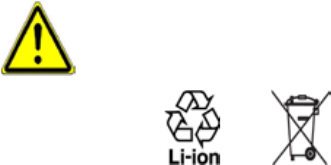
4
SAFETY PRECAUTIONS FOR POWER SUPPLY UNIT
Use the correct external power source
A product should be operated only from the type of power source indicated on the electrical ratings
label. If you are not sure of the type of power source required, consult your authorized service provider
or local power company. For a product that operates from battery power or other sources, refer to the
operating instructions that are included with the product.
Handle battery packs carefully
This product contains a Li-ion battery. There is a risk of fire and burns if the battery pack is handled
improperly. Do not attempt to open or service the battery pack. Do not disassemble, crush, puncture,
short external contacts or circuits, dispose of in fire or water, or expose a battery pack to temperatures
higher than 60˚C (140˚F).
WARNING: Danger of explosion if battery is incorrectly replaced. To reduce risk of fire or burns, do not
disassemble, crush, puncture, short external contacts, expose to temperature above 60° C (140° F), or
dispose of in fire or water. Replace only with specified batteries. Recycle or dispose of used batteries
according to the local regulations or reference guide supplied with your product.
Take extra precautions
Keep the battery or device dry and away from water or any liquid as it may cause a short circuit.
Keep metal objects away so they don’t come in contact with the battery or its connectors as it may
lead to short circuit during operation.
Do not use a battery that appears damaged, deformed, or discolored, or the one that has any rust
on its casing, overheats, or emits a foul odor.
Always keep the battery out of the reach of babies and small children, to avoid swallowing of the
battery. Consult the doctor immediately if the battery is swallowed.
Only use the battery with a charging system that has been qualified with the system per this
standard, IEEE-Std-1725-2006. Use of an unqualified battery or charger may present a risk of fire,
explosion, leakage or other hazard.
Replace the battery only with another battery that has been qualified with the system per this
standard, IEEE-Std-1725-2006. Use of an unqualified battery may present a risk of fire, explosion,
leakage or other hazard.
Avoid dropping the phone or battery. If the phone or battery is dropped, especially on a hard
surface, and the user suspect damage, take it to a service centre for inspection.
If the battery leaks:
Do not allow the leaking fluid to come in contact with skin or clothing. If already in contact,
flush the affected area immediately with clean water and seek medical advice.
Do not allow the leaking fluid to come in contact with eyes. If already in contact, DO NOT rub;
rinse with clean water immediately and seek medical advice.
Take extra precautions to keep a leaking battery away from fire as there is a danger of ignition
or explosion.
SAFETY PRECAUTIONS FOR DIRECT SUNLIGHT
Keep this product away from excessive moisture and extreme temperatures. Do not leave the product or
its battery inside a vehicle or in places where the temperature may exceed 60°C (140°F), such as on a car
dashboard, window sill, or behind a glass that is exposed to direct sunlight or strong ultraviolet light for
extended periods of time. This may damage the product, overheat the battery, or pose a risk to the vehicle.
PREVENTION OF HEARING LOSS
CAUTION: Permanent hearing loss may occur if earphones or headphones are used at high volume for prolonged periods
of time.
•
•
•
•
•
•
•
•
•
•
•
•
•
•
5
SAFETY IN AIRCRAFT
Due to the possible interference caused by this product to an aircraft’s navigation system and its
communications network, using this device’s phone function on board an airplane is against the law in most
countries. If you want to use this device when on board an aircraft, remember to turn off your phone by
switching to Airplane Mode.
ENVIRONMENT RESTRICTIONS
Do not use this product in gas stations, fuel depots, chemical plants or where blasting operations are in
progress, or in potentially explosive atmospheres such as fuelling areas, fuel storehouses, below deck
on boats, chemical plants, fuel or chemical transfer or storage facilities, and areas where the air contains
chemicals or particles, such as grain, dust, or metal powders. Please be aware that sparks in such areas could
cause an explosion or fire resulting in bodily injury or even death.
EXPLOSIVE ATMOSPHERES
When in any area with a potentially explosive atmosphere or where flammable materials exist, the product
should be turned off and the user should obey all signs and instructions. Sparks in such areas could cause
an explosion or fire resulting in bodily injury or even death. Users are advised not to use the equipment at
refueling points such as service or gas stations, and are reminded of the need to observe restrictions on the
use of radio equipment in fuel depots, chemical plants, or where blasting operations are in progress. Areas
with a potentially explosive atmosphere are often, but not always, clearly marked. These include fueling areas,
below deck on boats, fuel or chemical transfer or storage facilities, and areas where the air contains chemicals
or particles, such as grain, dust, or metal powders.
ROAD SAFETY
Vehicle drivers in motion are not permitted to use telephony services with handheld devices, except in the
case of emergency. In some countries, using hands-free devices as an alternative is allowed.
SAFETY PRECAUTIONS FOR RF EXPOSURE
Avoid using your phone near metal structures (for example, the steel frame of a building).
Avoid using your phone near strong electromagnetic sources, such as microwave ovens, sound
speakers, TV and radio.
Use only original manufacturer-approved accessories, or accessories that do not contain any metal.
Use of non-original manufacturer-approved accessories may violate your local RF exposure guidelines
and should be avoided.
INTERFERENCE WITH MEDICAL EQUIPMENT FUNCTIONS
This product may cause medical equipment to malfunction. The use of this device is forbidden in most
hospitals and medical clinics.
If you use any other personal medical device, consult the manufacturer of your device to determine if they
are adequately shielded from external RF energy. Your physician may be able to assist you in obtaining this
information.
Turn your phone OFF in health care facilities when any regulations posted in these areas instruct you to do so.
Hospitals or health care facilities may be using equipment that could be sensitive to external RF energy.
HEARING AIDS
Some digital wireless phones may interfere with some hearing aids. In the event of such interference, you may
want to consult your service provider, or call the customer service line to discuss alternatives.
NONIONIZING RADIATION
Your device has an internal antenna. This product should be operated in its normal-use position to ensure
the radiative performance and safety of the interference. As with other mobile radio transmitting equipment,
users are advised that for satisfactory operation of the equipment and for the safety of personnel, it is
recommended that no part of the human body be allowed to come too close to the antenna during operation
of the equipment.
•
•
•
•
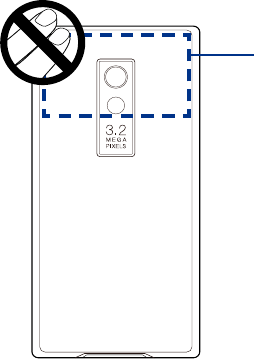
6
Use only the supplied integral antenna. Use of unauthorized or modified antennas may impair call quality and
damage the phone, causing loss of performance and SAR levels exceeding the recommended limits as well as
result in non-compliance with local regulatory requirements in your country.
To assure optimal phone performance and ensure human exposure to RF energy is within the guidelines set
forth in the relevant standards, always use your device only in its normal-use position. Do not touch or hold
the antenna area unnecessarily when placing or receiving a phone call. Contact with the antenna area may
impair call quality and cause your device to operate at a higher power level than needed. Avoiding contact
with the antenna area when the phone is IN USE optimizes the antenna performance and the battery life.
Antenna location
General Precautions
• Avoid applying excessive pressure to the device
Do not put heavy objects or apply excessive pressure on the device to prevent damaging the device or
distorting the touch screen display. Also avoid carrying the device inside your pocket for extensive lengths of
time.
• Heed service markings
Except as explained elsewhere in the Operating or Service documentation, do not service any product
yourself. Service needed on components inside the device should be done by an authorized service
technician or provider.
• Damage requiring service
Unplug the product from the electrical outlet and refer servicing to an authorized service technician or
provider under the following conditions:
Liquid has been spilled or an object has fallen into the product.
The product has been exposed to rain or water.
The product has been dropped or damaged.
There are noticeable signs of overheating.
The product does not operate normally when you follow the operating instructions.
• Avoid hot areas
The product should be placed away from heat sources such as radiators, heat registers, stoves, or other
products (including amplifiers) that produce heat.
• Avoid wet areas
Never use the product in a wet location.
• Avoid using your device after a dramatic change in temperature
When you move your device between environments with very different temperature and/or humidity ranges,
condensation may form on or within the device. To avoid damaging the device, allow sufficient time for the
moisture to evaporate before using the device.
•
•
•
•
•
7
NOTICE: When taking the device from low-temperature conditions into a warmer environment or from high-temperature
conditions into a cooler environment, allow the device to acclimate to room temperature before turning on
power.
• Avoid pushing objects into product
Never push objects of any kind into cabinet slots or other openings in the product. Slots and openings are
provided for ventilation. These openings must not be blocked or covered.
• Mounting accessories
Do not use the product on an unstable table, cart, stand, tripod, or bracket. Any mounting of the product
should follow the manufacturer’s instructions, and should use a mounting accessory recommended by the
manufacturer.
• Avoid unstable mounting
Do not place the product with an unstable base.
• Use product with approved equipment
This product should be used only with personal computers and options identified as suitable for use with
your equipment.
• Adjust the volume
Turn down the volume before using headphones or other audio devices.
• Cleaning
Unplug the product from the wall outlet before cleaning. Do not use liquid cleaners or aerosol cleaners. Use a
damp cloth for cleaning, but NEVER use water to clean the LCD screen.
8
Contents
Chapter 1 Getting Started 15
1.1 Getting to Know Your Touch Phone and Accessories .............................. 16
Top panel ...................................................................................................................................................16
Front panel ................................................................................................................................................16
Bottom panel ...........................................................................................................................................16
Left panel ...................................................................................................................................................17
Back panel .................................................................................................................................................17
Right panel ................................................................................................................................................17
Accessories ................................................................................................................................................17
1.2 Installing the Battery ................................................................................. 18
Battery ........................................................................................................................................................18
1.3 Charging the battery ................................................................................. 19
1.4 Starting Up ................................................................................................. 20
Turn your device on and off ................................................................................................................20
Switch to Sleep mode when not in use ..........................................................................................20
1.5 Navigating Your Device ............................................................................. 20
Finger-touch control .............................................................................................................................20
Stylus ...........................................................................................................................................................21
Navigation Control .................................................................................................................................21
1.6 Home Screen .............................................................................................. 22
1.7 Status Icons ................................................................................................ 22
1.8 Start Menu .................................................................................................. 24
1.9 Quick Menu ................................................................................................. 24
1.10 LED Alerts .................................................................................................. 25
1.11 Adjusting the Volume ............................................................................... 25
1.12 Using your Device as a USB Drive ............................................................ 26
Chapter 2 Using Phone Features 27
2.1 Using the Phone ......................................................................................... 28
The Phone screen ...................................................................................................................................28
2.2 Voice Call .................................................................................................... 28
Make a call .................................................................................................................................................28
Answer a call.............................................................................................................................................29
End a call ...................................................................................................................................................30
Call History ................................................................................................................................................30
Speed Dial .................................................................................................................................................30
Turn the phone function on and off ................................................................................................31
9
2.3 Smart Dial ................................................................................................... 31
Make a call or send a text message using Smart Dial ................................................................32
Chapter 3 TouchFLO™ 3D 33
3.1 About TouchFLO™ 3D ................................................................................. 34
3.2 Using the TouchFLO 3D Home Screen ...................................................... 34
Home ..........................................................................................................................................................35
People .........................................................................................................................................................36
Messages ...................................................................................................................................................37
Mail ..............................................................................................................................................................37
Photos and Videos ..................................................................................................................................38
Music ...........................................................................................................................................................39
Internet .......................................................................................................................................................41
Weather ......................................................................................................................................................41
Settings ......................................................................................................................................................42
Programs....................................................................................................................................................42
3.3 Finger Gestures .......................................................................................... 43
Finger scrolling ........................................................................................................................................43
Finger zooming .......................................................................................................................................43
Finger panning ........................................................................................................................................43
Chapter 4 Entering Text 45
4.1 Selecting an Input Method ....................................................................... 46
4.2 Using the Full QWERTY .............................................................................. 46
4.3 Using the Compact QWERTY ..................................................................... 47
4.4 Using the Phone Keypad ........................................................................... 48
4.5 Using Multitap and T9 Modes ................................................................... 48
Multitap mode .........................................................................................................................................48
T9 mode .....................................................................................................................................................48
4.6 Using Numeric and Symbol Mode ............................................................ 49
4.7 Using Block Recognizer ............................................................................. 50
4.8 Using Letter Recognizer ............................................................................ 50
4.9 Using Transcriber ....................................................................................... 50
Chapter 5 Synchronizing Information With Your Computer 53
5.1 About Synchronization ............................................................................. 54
Ways to synchronize ..............................................................................................................................54
5.2 Setting Up Windows Mobile® Device Center on Windows Vista® ........... 54
Set up synchronization in Windows Mobile Device Center ....................................................54
Use Windows Mobile Device Center ................................................................................................55
5.3 Setting Up ActiveSync® on Windows XP® ................................................. 55
10
Install ActiveSync ....................................................................................................................................55
Set up synchronization in ActiveSync .............................................................................................55
5.4 Synchronizing With Your Computer ......................................................... 56
Start and stop synchronization .........................................................................................................56
Change which information is synchronized .................................................................................56
Troubleshoot sync connection problem ........................................................................................56
5.5 Synchronizing via Bluetooth .................................................................... 57
5.6 Synchronizing Music and Video ................................................................ 57
Chapter 6 Exchanging Messages 59
6.1 Messaging .................................................................................................. 60
6.2 Text Messages ............................................................................................ 60
Create a new text message .................................................................................................................60
Compose and send a text message .................................................................................................61
Manage text messages .........................................................................................................................61
6.3 Types of E-mail Accounts ........................................................................... 62
Set up your device to synchronize Outlook e-mail with the computer..............................62
Add an e-mail account .........................................................................................................................62
6.4 E-mail Setup Wizard ................................................................................... 62
Set up an Internet e-mail account ....................................................................................................62
Set up a custom domain e-mail ........................................................................................................64
6.5 Using E-mail................................................................................................ 64
Create a new e-mail message ............................................................................................................64
Compose and send an e-mail ............................................................................................................64
Filter the Inbox message list ...............................................................................................................65
View and reply to messages ...............................................................................................................65
Synchronize e-mails...............................................................................................................................66
Customize e-mail settings ...................................................................................................................66
Chapter 7 Working With Company E-mails and Meeting
Appointments 69
7.1 Synchronizing with the Exchange Server ................................................ 70
Set up an Exchange Server connection ..........................................................................................70
Start synchronization ............................................................................................................................70
7.2 Working With Company E-mails ............................................................... 71
Automatic synchronization through Direct Push .......................................................................71
Scheduled synchronization ................................................................................................................71
Instant download through Fetch Mail ............................................................................................71
Search for e-mails on the Exchange Server...................................................................................72
Flag your messages ...............................................................................................................................72
7.3 Managing Meeting Requests .................................................................... 73
11
Out-of-office auto-reply .......................................................................................................................73
7.4 Finding Contacts in the Company Directory ........................................... 74
Chapter 8 Internet 75
8.1 Ways of Connecting to the Internet .......................................................... 76
Wi-Fi .............................................................................................................................................................76
Dial-up ........................................................................................................................................................78
8.2 Starting a Data Connection ....................................................................... 78
8.3 Using Opera Mobile™ ................................................................................ 79
View Web pages ......................................................................................................................................80
Opera Mobile menu ..............................................................................................................................80
8.4 Using YouTube™ ......................................................................................... 81
Browse for videos ...................................................................................................................................81
Watching videos .....................................................................................................................................82
Bookmarks ................................................................................................................................................83
History ........................................................................................................................................................83
8.5 Using Windows Live™ ................................................................................ 84
Set up Windows Live™ ..........................................................................................................................84
The Windows Live™ interface .............................................................................................................84
Windows Live™ Messenger .................................................................................................................85
Launch Messenger and sign in ..........................................................................................................85
Add Windows Live™ contacts .............................................................................................................85
8.6 Using Your Device As a Modem (Wireless Modem) ................................. 86
Activate your device as a modem ....................................................................................................86
Add your device as a modem to your notebook ........................................................................86
Create a modem dial-up connection ..............................................................................................88
Dial up and connect to the Internet ................................................................................................90
8.7 Using RSS Hub ............................................................................................ 91
Subscribe to and organize news channels ....................................................................................91
View and organize headlines .............................................................................................................92
View the news summary ......................................................................................................................92
Chapter 9 Bluetooth 95
9.1 Bluetooth Modes ....................................................................................... 96
9.2 Bluetooth Partnerships ............................................................................. 96
9.3 Connecting a Bluetooth Hands-free or Stereo Headset ......................... 97
9.4 Beaming Information Using Bluetooth .................................................... 97
9.5 Bluetooth Explorer and Bluetooth File Sharing ...................................... 98
9.6 Printing Files via Bluetooth ....................................................................... 99
Chapter 10 Navigating on the Road 101
12
10.1 Guidelines and Preparation for Using GPS ........................................... 102
10.2 Downloading Satellite Data via QuickGPS ........................................... 103
Download options .............................................................................................................................. 103
Chapter 11 Experiencing Multimedia 105
11.1 Taking Photos and Videos ...................................................................... 106
Capture modes ..................................................................................................................................... 106
Camera controls ................................................................................................................................... 107
On-screen controls and indicators ................................................................................................ 107
Menu Panel ............................................................................................................................................ 108
Zooming ................................................................................................................................................. 109
The Review screen ............................................................................................................................... 110
Advanced Options .............................................................................................................................. 110
11.2 Viewing Photos and Videos Using Album ............................................. 112
Select a photo or video to view ...................................................................................................... 112
View an image ...................................................................................................................................... 113
Play back video ..................................................................................................................................... 115
Close Album .......................................................................................................................................... 115
11.3 Using Windows Media® Player Mobile .................................................. 115
About the controls .............................................................................................................................. 116
About the screens and menus ........................................................................................................ 116
Synchronize video and audio files................................................................................................. 116
Play media .............................................................................................................................................. 117
Playlists .................................................................................................................................................... 118
Troubleshooting .................................................................................................................................. 118
11.4 Using Audio Booster ............................................................................... 118
11.5 Using MP3 Trimmer ................................................................................ 119
Chapter 12 Programs on your Device 121
12.1 Programs on your Device ....................................................................... 122
Programs in the Start Menu ............................................................................................................. 122
Programs screen .................................................................................................................................. 122
12.2 Adding and Removing Programs .......................................................... 123
12.3 Adobe® Reader® LE ................................................................................. 124
12.4 Calendar .................................................................................................. 124
Create appointments ......................................................................................................................... 124
View appointments ............................................................................................................................ 125
Send appointments ............................................................................................................................ 125
12.5 Contacts ................................................................................................... 126
Add new contacts ................................................................................................................................ 126
Organize and search contacts ......................................................................................................... 127
Share contact information ............................................................................................................... 127
13
12.6 Comm Manager....................................................................................... 128
12.7 Microsoft® Office Mobile ........................................................................ 128
12.8 Notes ........................................................................................................ 129
12.9 Tasks......................................................................................................... 130
12.10 Voice Recorder ...................................................................................... 131
12.11 ZIP .......................................................................................................... 132
12.12 Sprite Backup ........................................................................................ 133
Chapter 13 Managing Your Device 135
13.1 Copying and Managing Files ................................................................. 136
13.2 Settings on your Device ......................................................................... 137
Personal tab ........................................................................................................................................... 137
System tab ............................................................................................................................................. 137
Connections tab ................................................................................................................................... 138
13.3 Changing Basic Settings ........................................................................ 138
Date and time ....................................................................................................................................... 138
Regional settings ................................................................................................................................. 139
Display settings .................................................................................................................................... 139
Device name .......................................................................................................................................... 139
Ringer settings ...................................................................................................................................... 139
Alarms and notifications ................................................................................................................... 140
Phone services ...................................................................................................................................... 140
13.4 Using Task Manager................................................................................ 141
13.5 Protecting Your Device ........................................................................... 142
Protect your device with a password ........................................................................................... 142
13.6 Managing Memory ................................................................................. 143
13.7 Resetting Your Device ............................................................................. 143
Soft reset ................................................................................................................................................. 143
Hard reset ............................................................................................................................................... 144
Clear Storage ......................................................................................................................................... 144
13.8 Windows Update ..................................................................................... 145
13.9 Battery Saving Tips ................................................................................. 146
Appendix 147
A.1 Specifications ........................................................................................... 148
A.2 Regulatory Notices .................................................................................. 149
Regulatory Agency Identifications ................................................................................................ 149
Federal Communication Commission Interference Statement .......................................... 149
Industry Canada statement ............................................................................................................. 150
FCC Hearing-Aid Compatibility (HAC) Regulations for Wireless Devices ........................ 150
SAR Information ................................................................................................................................... 151
14
IC Statement .......................................................................................................................................... 152
Telecommunications & Internet Association (TIA) Safety Information ............................ 152
WEEE Notice .......................................................................................................................................... 152
RoHS Compliance ................................................................................................................................ 153
A.3 Additional Safety Information ................................................................ 153
When Driving ........................................................................................................................................ 153
When Using Your Device Near Other Electronic Devices ...................................................... 153
Turn Off Your Device Before Flying ............................................................................................... 154
Turn Off Your Device in Dangerous Areas ................................................................................... 155
General Safety ....................................................................................................................................... 155
Antenna Safety ..................................................................................................................................... 155
Battery Safety ........................................................................................................................................ 155
Adapter/Charger .................................................................................................................................. 156
Index 157

Chapter 1
Getting Started
1.1 Getting to Know Your Touch Phone
and Accessories
1.2 Installing the Battery
1.3 Charging the Battery
1.4 Starting Up
1.5 Navigating Your Device
1.6 Home Screen
1.7 Status Icons
1.8 Start Menu
1.9 Quick Menu
1.10 LED Alerts
1.11 Adjusting the Volume
1.12 Using your Device as a USB Drive
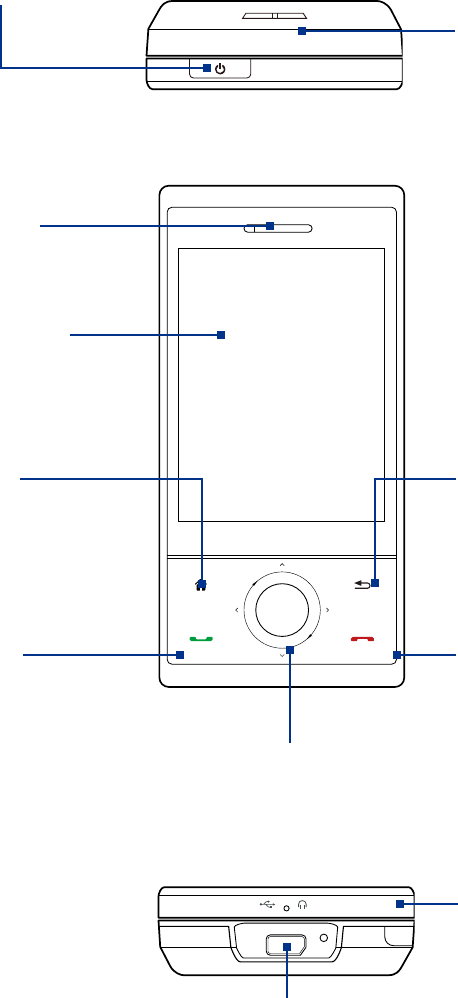
16 Getting Started
1.1 Getting to Know Your Touch Phone and Accessories
Top panel
POWER
Press to turn off the display temporarily. To turn off
the power, press and hold for about 5 seconds.
For more information, see “Starting Up” in this chapter.
Speaker
Front panel
Earpiece
Listen to a phone call
from here.
Touch Screen
HOME
Press to return to the
Home screen.
See Chapter 3 for details.
BACK
Press to return to
the previous screen.
Navigation Control
See “Touch-sensitive navigation control”
later in this chapter for details.
TALK/SEND
Press to answer an incoming
call or dial a number.
During a call, press and hold
to toggle the speakerphone
on and off.
•
•
END
Press to end a call or return to
the Home screen.
Press and hold to lock the
device. (See “Long Press End Key”
under “Settings on your Device”
in Chapter 13 for details.)
•
•
Bottom panel
Sync Connector/Earphone Jack
Connect the supplied USB cable to synchronize information or plug in the
AC adapter to recharge the battery. You can also connect the supplied USB
stereo headset for hands-free conversation or for listening to audio media.
Microphone
Note When using the four buttons — HOME, BACK, TALK/SEND, and END — and the Navigation Control, please observe
the following precautions:
• Make sure to press on the icons of the four buttons for the best accuracy. When pressing on the Navigation
Control, make sure to press the outer areas near the ENTER button for directional control.
• For best results, press with your fingertip. Do not wear gloves.
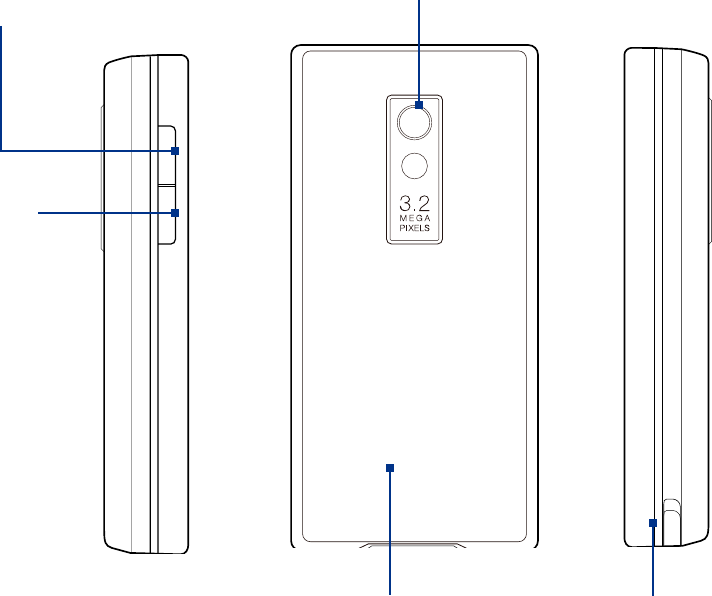
Getting Started 17
Left panel Back panel Right panel
Back Cover
Push the back cover upward
to remove it.
3.2 Megapixel Camera
See “Taking Photos and Videos”
in Chapter 11 for details.
Accessories
The product package includes the following items and accessories:
Battery
AC adapter
Screen protector
Stereo headset
USB sync cable
Multifunction audio cable
Quick Start Guide
Getting Started and Application discs
Pouch
Extra stylus
•
•
•
•
•
•
•
•
•
•
VOLUME UP
During a call or when playing
music, press this button to increase
the volume.
VOLUME DOWN
During a call or when
playing music, press
this button to lower the
volume.
Stylus
(See “Stylus” in this
chapter for details.)

18 Getting Started
1.2 Installing the Battery
Always turn off your device before installing or replacing the battery. You also need to remove the back cover
before you can install these components.
To remove the back cover
1. Make sure your device is turned off.
2. Hold the device with both hands and the front panel facing
down.
3. Push the back cover up with your thumb until it disengages
from the device and then slide it up to remove.
Battery
Your device comes with a rechargeable Lithium-ion or Lithium-ion polymer battery and is designed to use
only manufacturer-specified original batteries and accessories. Battery performance depends on many
factors, including network configuration, signal strength, the temperature of the environment in which you
operate your device, the features and/or settings you select and use, items attached to connecting ports, and
your voice, data, and other program usage patterns.
Battery life estimates (approximations):
Standby time: Up to 375 hours
Talk time: Up to 250 minutes
Note Battery life is subject to network and phone usage.
Warning! To reduce risk of fire or burns:
• Do not attempt to open, disassemble, or service the battery pack.
• Do not crush, puncture, short external contacts, or dispose of in fire or water.
• Do not expose to temperatures above 60
oC (140oF).
• Replace only with the battery pack designated for this product.
• Recycle or dispose of used battery as stipulated by local regulations.
To install the battery
1. Align the battery’s exposed copper contacts with the
battery connectors inside the battery compartment.
2. Insert the contact’s side of the battery first and then gently
push the battery into place.
3. Replace the back cover.
Battery grip
To remove the battery
1. Make sure your device is turned off.
2. Remove the back cover.
3. The top right side of the battery has a protruding grip.
Lift the protruding grip to remove the battery.
•
•
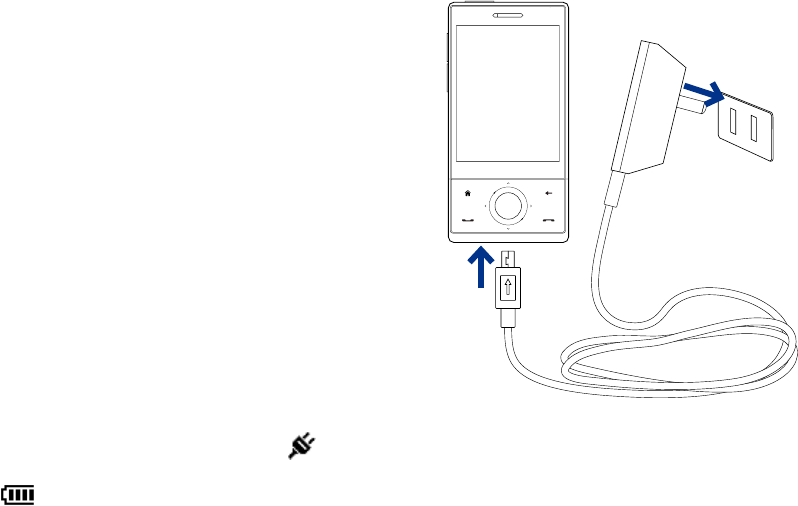
Getting Started 19
1.3 Charging the Battery
New batteries are shipped partially charged. Before you start using your device, it is recommended that you
install and charge the battery. Some batteries perform best after several full charge/discharge cycles.
To charge the battery
1. Connect the USB connector of the AC adapter to the
sync connector on your device.
2. Plug in the AC adapter to an electrical outlet to start
charging the battery.
Note Only the AC adapter and USB sync cable provided with your
device must be used to charge the device.
1
2
Charging is indicated by a “breathing” white light around the Navigation Control. As the battery is being
charged while the power is on, a charging icon ( ) also appears in the title bar of the Home screen.
After the battery has been fully charged, the Navigation Control LED shows a solid white light and a full
battery icon ( ) appears in the title bar of the Home screen.
For more information about the Navigation Control LED, see “LED Alerts” in this chapter.
Warning! • Do not remove the battery from the device while you are charging it using the AC or car adapter.
• As a safety precaution, the battery stops charging when it overheats.
20 Getting Started
1.4 Starting Up
After installing and charging the battery, you can now power on and start using your device.
Turn your device on and off
To turn on the power
1. Press and hold the POWER button for a few seconds.
2. When you turn on your device for the first time, a Quick Start Wizard guides you to set up regional
settings, date and time, and password. For more information about these settings, see Chapter 13.
After the Quick Start Wizard finishes, the device installs customization settings, then restarts.
Note After the device restarts, you may be prompted to set up an e-mail account. For instructions on how to set up an
e-mail account, see Chapter 6.
To turn off the power
1. Press and hold the POWER button for a few seconds.
2. Tap Yes when a message prompts you to choose whether or not to turn off the device completely.
Switch to Sleep mode when not in use
Press and immediately release the POWER button to turn off the display temporarily and switch your device
to Sleep mode. Sleep mode suspends your device to a low power state while the display is off in order to save
battery power.
Your device automatically goes into Sleep mode when you leave the device idle after a certain period of time.
You will still be able to receive messages and calls while your device is in Sleep mode. Pressing the POWER
button again or incoming calls/messages will wake up your device.
1.5 Navigating Your Device
There are different ways you can navigate and interact with the interface of your device.
Finger-touch control
A quick and easy way to interact with the home screen and the whole interface of your device is by touch.
Basically, the following are the types of actions, called finger gestures, you would do when interacting with
your device:
Touch or tap
When selecting items on the screen, such as the Home screen tabs, Start menu, programs and settings icons,
and large on-screen buttons, simply touch them with your finger. Apply some pressure with your finger pad
when touching an item on the screen.
Tapping means to touch lightly and quickly with your finger pad or fingertip. On screens that display smaller-
size items, you can more accurately select an item by tapping it with your fingertip.
Swipe
To swipe means to drag your finger vertically or horizontally across the screen. The following are some
instances when you would use swiping:
Flipping on the Home screen
Swipe your finger vertically to flip through favorite contacts, messages, music albums, photos, and
more. For more information, see “Using the TouchFLO 3D Home Screen” in Chapter 3.
Scrolling
When browsing the contacts list, web pages, documents, and certain selection lists on the Home screen
(such as the All Programs list), slowly swipe your finger vertically across the screen to scroll. This allows
you to scroll by page and to view the content or available selections as you scroll.
The direction of swiping resembles the way you move a printed document as you are reading it. For
detailed instructions, see “Finger scrolling” in Chapter 3.
•
•
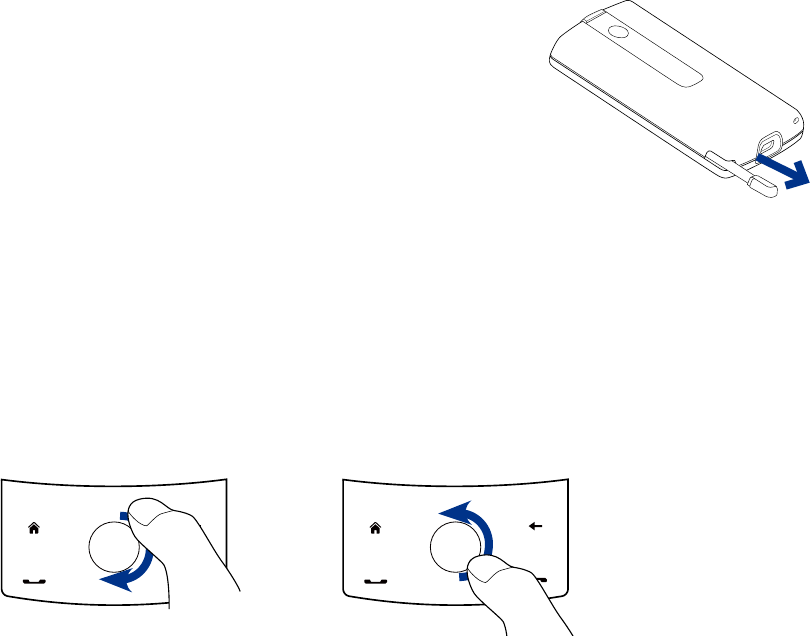
Getting Started 21
Slide
Sliding on the touch screen also involves dragging with your finger, but you need to press and hold your
finger with some pressure before you start to drag. While dragging, do not release your finger until you have
reached the target position.
The following are some instances when you would use sliding:
Switching between Home screen tabs
Slide your finger left and right to switch between the Home screen tabs. For more information, see
“Using the TouchFLO 3D Home screen“ in Chapter 3.
Advancing playback
In players that have a progress bar, such as the Home screen’s Music tab and Windows Media® Player
Mobile, slide your finger horizontally on their progress bar to advance forward or move backward in the
music or video you are playing.
For more information about the Home screen’s Music tab, see “Music” in Chapter 3.
For more information about Windows Media® Player Mobile, see “Using Windows Media® Player Mobile” in
Chapter 11.
Flick
Flicking the screen is similar to swiping, except that you need to swipe your finger in light, quicker strokes.
This finger gesture is always in a vertical direction, such as when flicking the contacts list. See “Finger scrolling”
in Chapter 3 for details.
Finger zooming and panning
In programs such as Album and Opera Mobile, you can use finger gestures when zooming and panning. See
Chapter 3, 8 and 11 for details.
Stylus
You can use the stylus to navigate and interact with the touch
screen. To use the stylus, pull it out from the stylus compartment
at the bottom of the right panel of your device. If the backlight
is off, removing the stylus automatically turns the backlight back
on.
The stylus is magnetic and sticks to the side when held close
to the device. This prevents you from accidentally losing or
misplacing the stylus.
Basically, you tap with the stylus to open programs and select items on the screen, and you tap and hold on
the screen to open a shortcut menu. You can also use the stylus the same way as what you do with finger
gestures, such as swiping, sliding and flicking on the screen.
Navigation Control
On the home screen and in many programs on your device, you can use the Navigation Control for directional
control. Press the directional arrows to navigate up, down, left, and right on the screen. When an item has
been selected on the screen, press the ENTER button (the center button) to confirm your selection.
The Navigation Control is also touch sensitive and can be used for zooming. Slide your finger clockwise
around the Navigation Control to zoom in, counterclockwise to zoom out.
Sliding your finger
counterclockwise
Sliding your finger clockwise
•
•
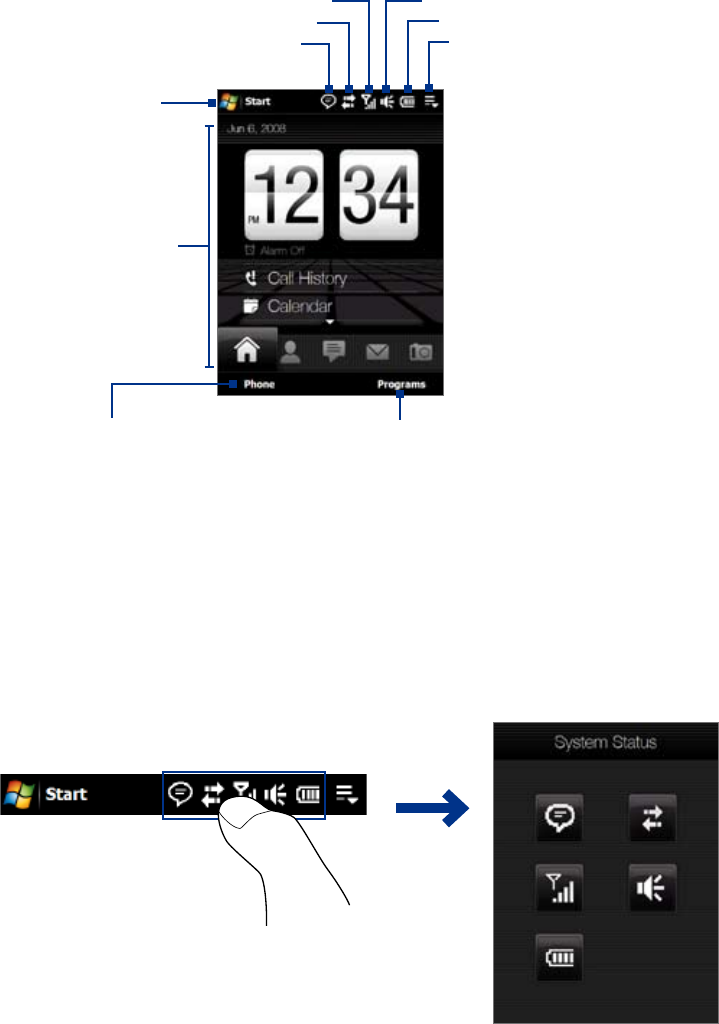
22 Getting Started
The following programs allow you to use the Navigation Control for zooming:
Album•Opera Mobile•
Camera•Word Mobile and Excel Mobile•
Tip If you purchase and install GPS navigation software on your device, you can also use the Navigation Control for
zooming in the GPS software.
On the Home screen’s Music tab, you can advance forward in the music you are playing by sliding clockwise
around the Navigation Control. To move backward in the music, slide counterclockwise. See “Music” in Chapter
3 for details.
1.6 Home Screen
The default home screen of the device is the TouchFLO™ 3D Home screen which allows finger-touch access to
the most important functions such as contacts, text messages, e-mail, Internet, and more.
Start menu
Notification
Signal strength Adjust volume
Battery status
TouchFLO 3D
Home screen
Connection status
Open the Phone screen
(See Chapter 2 for details)
Go to the Programs tab to
access favorite programs
Quick menu
For more information about using the TouchFLO 3D Home screen, see Chapter 3.
1.7 Status Icons
When you touch or tap the icon area of the title bar, the System Status screen opens and displays larger status
icons so you can touch them with your finger more easily and accurately.
Tip The System Status screen can be disabled in TouchFLO settings. See “Settings on your Device” in Chapter 13 for
details.
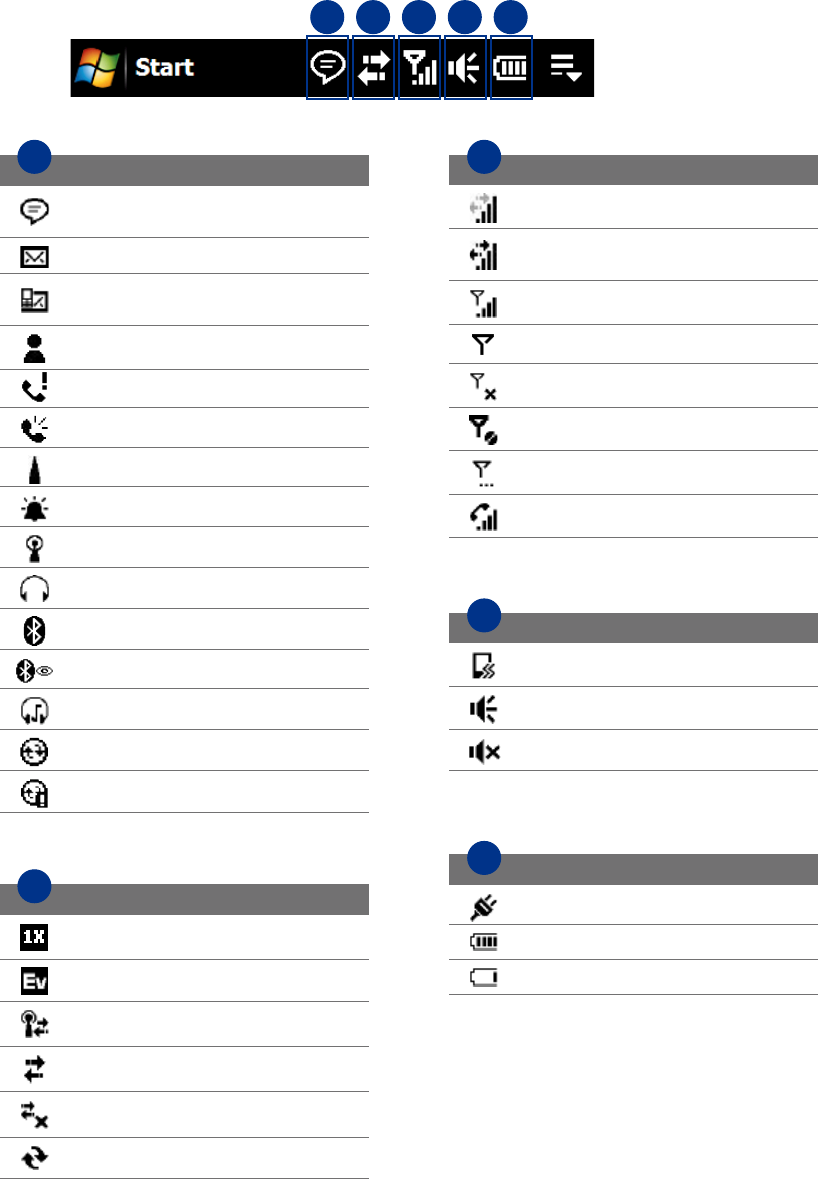
Getting Started 23
The following are some of the status icons that you may see on the device.
12345
Icons that appear in this area
Battery charging
Battery full
Battery very low
Icons that appear in this area
Vibrate mode
Sound on
Sound off
Icons that appear in this area
Data connection is active but idle
Data connection is active and
transmitting data
Maximum signal strength
No signal
Phone is turned off
No phone service
Searching for phone service
Voice call in progress
Icons that appear in this area
1xRTT available
EVDO available
Connected to a wireless network
Connection is active
Connection is not active
Synchronization in progress
Icons that appear in this area
Multiple notifications; tap the icon to
view all
New e-mail messages
New text messages;
SMS notification of voice mail
New Windows Live™ message
Missed call
Speakerphone on
Roaming
Alarm
Other wireless network(s) detected
Wired headset connected
Bluetooth on
Bluetooth visible mode on
Bluetooth stereo headset connected
ActiveSync notification
Synchronization error
1
2
3
4
5
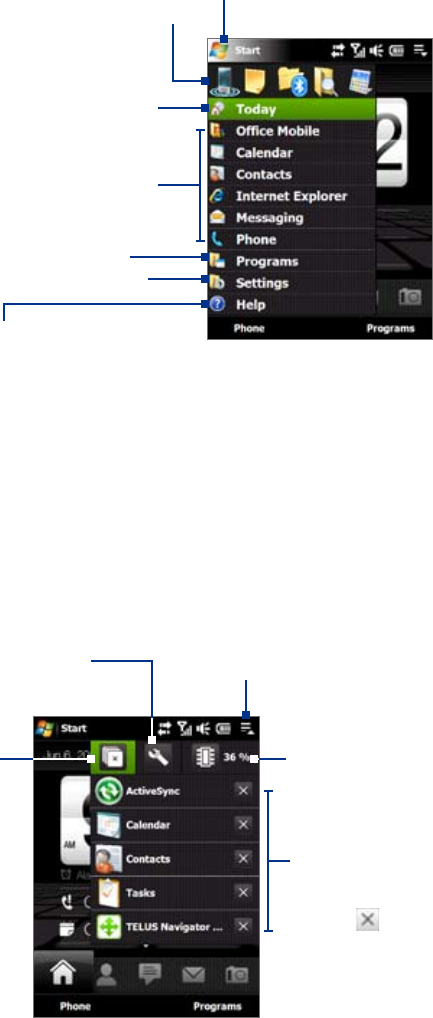
24 Getting Started
1.8 Start Menu
The Start menu, which can be opened from the top left corner of the screen, gives you access to all the
programs and settings of your Windows Mobile-powered device. Touch or tap to select an item on the Start
menu.
View Help information for the
current screen.
View and change settings.
Access more programs.
Open a recently-used program.
Open a program.
When you are on another screen,
touch or tap this item to return to
the TouchFLO 3D Home screen.
Open the Start menu.
By default, the Start menu is displayed in a large size to make it easier for you to touch menu items with your
finger when selecting them from the Start menu. The Start menu can also be displayed in a smaller size, if
preferred. Tap Start > Settings > System tab > TouchFLO and then clear the Enable large Start menu check
box to display a smaller Start menu.
1.9 Quick Menu
The Quick menu, which can be opened from the top right corner of the screen, shows the currently running
programs. You can quickly switch between running programs, stop programs, and see how much program
memory is being used.
Touch this icon to open the Quick Menu.
• To switch to a running program,
touch the program name.
• To stop a running program,
touch .
Customize Task Manager settings.
(See “Using Task Manager” in Chapter 13.)
Stop all currently
running programs.
Shows the total percentage of
program memory in use. Touch to
open the Memory settings screen.
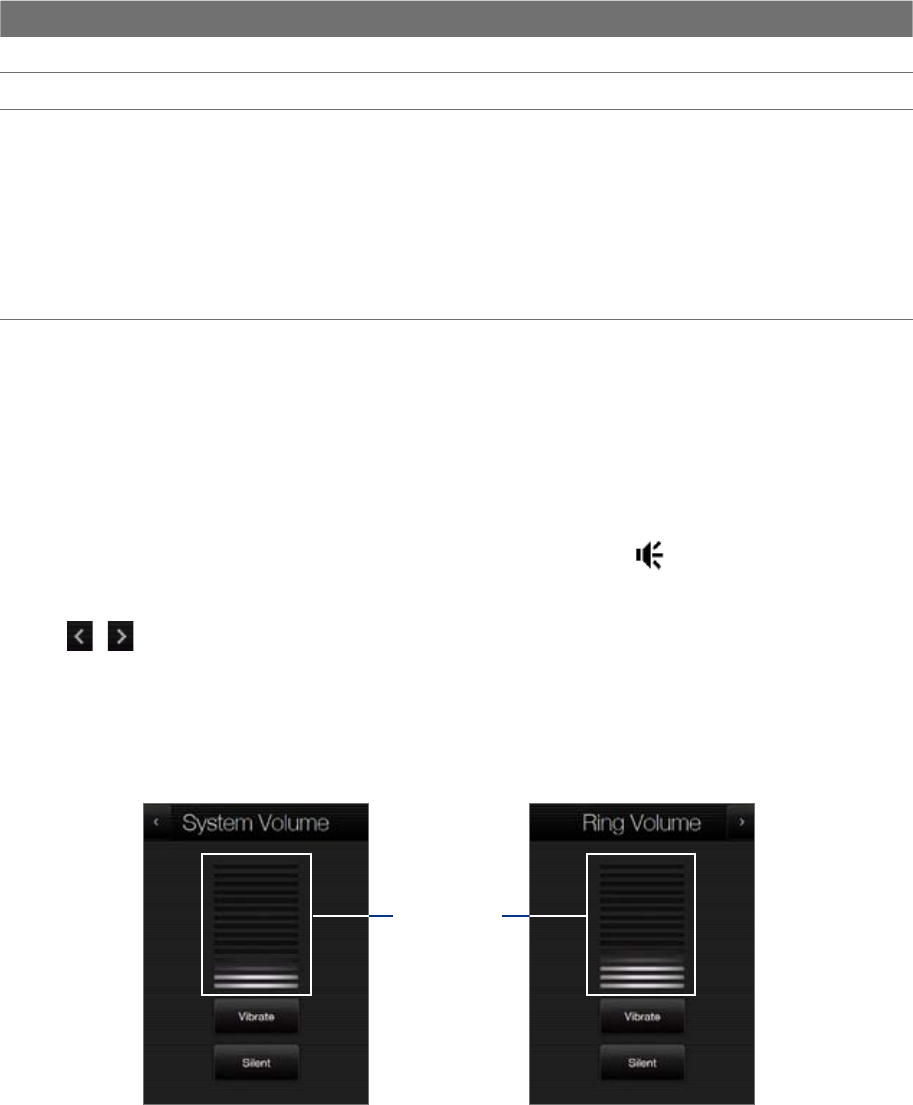
Getting Started 25
1.10 LED Alerts
The buttons below the touch screen and the exterior edge of the Navigation Control which is an LED ring will
light up in the following situations:
Controls Light Behavior
SEND button Light flashes when there is an incoming call.
END button Light stays solid when there is an incoming call.
Navigation Control The LED ring shows a “breathing” white light when the battery is being charged.
The LED ring shows a solid white light when the battery is fully charged.
The LED ring flashes a white light once when the battery level is low and reaches down to
about 10%.
The top and bottom parts of the LED ring flashes a white light twice when there is a new
e-mail, voice mail, or meeting reminder.
A white light goes around the LED ring counterclockwise twice starting from the top when
there is a missed call or new SMS message.
•
•
•
•
•
The LED ring, HOME, BACK, SEND, and END buttons will flash a white light once when one of the buttons or
Navigation Control is pressed.
1.11 Adjusting the Volume
Adjusting the system volume changes the volume level of sound notifications and audio/video playback,
whereas adjusting the ring volume affects only the volume of the phone ring. The system volume and ring
volume can be separately adjusted.
1. Touch the icon area in the title bar and then touch the Speaker icon ( ) on the System Status
screen.
2. To switch between the Ring Volume and System Volume screens, touch the Back and Next icons
( / ) on top of the screen.
3. On either screens, you can do the following:
To increase or decrease the volume level, drag your finger up or down the volume bars. You can also
press the VOLUME UP/DOWN buttons on the left panel of your device.
Touch Vibrate to enable or disable Vibrate mode.
Touch Silent to mute both the system and ring volume.
Volume bars
4. The System Volume or Ring Volume screen automatically closes. You can also manually close the screen
by touching the screen.
Note On certain screens that do not show the volume status icon on the title bar, you need to use the VOLUME
UP/DOWN buttons on the left panel of your device to adjust the volume. Also use these buttons to adjust the
conversation phone volume during an ongoing call.
•
•
•
26 Getting Started
1.12 Using your Device as a USB Drive
To easily carry media and other files with you, you can use the internal storage of your device as a USB flash
drive. Touch Start > Settings > Connections tab > USB to PC and then select Disk Drive mode. This allows
you to copy files from your computer to the device and vice versa faster.
When Disk Drive mode is used:
You will not be able to use your device to access files from the internal storage while it is connected to
your PC.
Your PC will only connect to the device’s internal storage. When you access your device from the PC, you
will only see the contents of the device’s internal storage.
Remember to change back to ActiveSync mode when you need to synchronize data between your device
and your PC.
•
•

Chapter 2
Using Phone Features
2.1 Using the Phone
2.2 Voice Call
2.3 Smart Dial
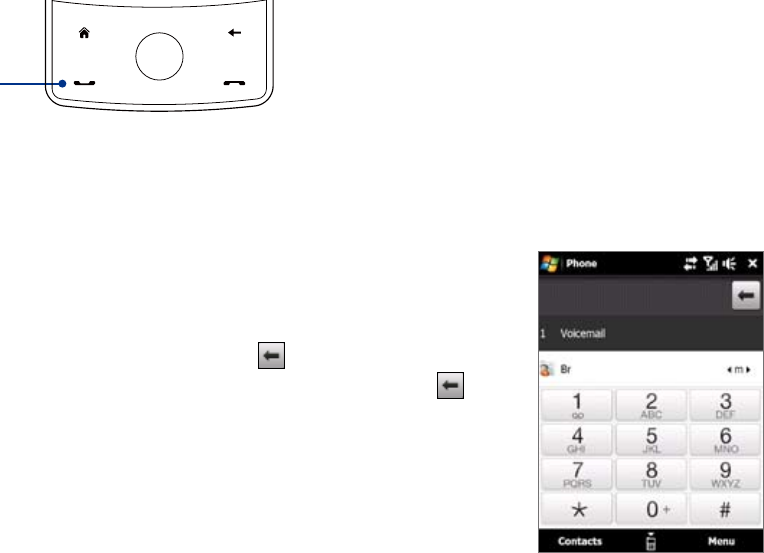
28 Using Phone Features
2.1 Using the Phone
Like a standard mobile phone, you can use your device to make, receive, and keep track of calls and send
messages.
The Phone screen
To open the Phone screen, do one of the following:
On the Home screen, tap Phone.
Press the TALK/SEND button.
TALK/SEND button
2.2 Voice Call
Make a call
To make a call from the Phone screen
1. On the Home screen, tap Phone.
2. Tap the keys on the keypad to enter the phone number.
Note If you tapped a wrong number, tap to erase each subsequent
digit of a number. To erase the entire number, tap and hold .
3. Press the TALK/SEND button to place the call.
Tip When in a call, use the VOLUME UP/DOWN buttons on the side of the device to adjust the phone volume.
Note After tapping 6 keys and the number you are dialing is not in your contacts, a Save to Contacts? button will
appear above the keypad. Tap it to save the number to your Contacts.
To make a call from Contacts
On the Home screen, tap Start > Contacts to open the Contacts screen.
Do one of the following:
Select the contact to call and then press TALK/SEND.
Note If the contact has more than one number stored, press Navigation right/left to select the number you
want to call before pressing TALK/SEND.
Tap the contact to open the contact details and then tap the phone number you want to call.
Tap and hold the contact you want to call and then from the menu, select Call Work, Call Home, or Call
Mobile.
To make a call from the TouchFLO 3D Home screen
Refer to Chapter 3 to learn how to make a call from the TouchFLO 3D Home screen.
To make an emergency call
Enter the international emergency number for your locale, and press the TALK/SEND button on your device.
•
•
•
•
•
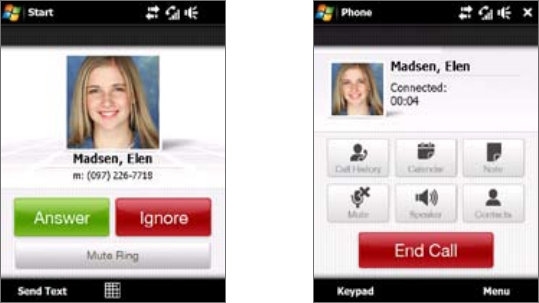
Using Phone Features 29
To make an international call
1. Tap and hold the number 0 key on the Phone screen until the plus (+) sign appears. The plus (+) sign
replaces the international prefix of the country that you are calling.
2. Enter the full phone number you want to dial, and press the TALK/SEND button on your device. The
full phone number includes the country code, area code (without the leading zero, if any), and phone
number.
To call voice mail
Number 1 is generally reserved for your voice mail. Tap and hold this button on the Phone screen keypad to
call voice mail and retrieve your voice mail messages.
Answer a call
When you receive a phone call, a message will appear, giving you the option to either answer or ignore the
incoming call. The TALK/SEND button will also flash when you receive a call.
To answer or reject an incoming call
To answer the call, tap Answer, or press the TALK/SEND button.
To reject the call, tap Ignore, or press the END button.
To mute the ringing sound without rejecting the call, tap Mute Ring.
Tip You can also place your phone face down to mute the ring without rejecting the call.
To reject a call and send a text message
When you reject a call, you can choose to automatically send a text message to the mobile phone of the caller.
1. On the Phone screen, tap Menu > Options > Advanced tab.
2. Select the Reject call with text message check box.
3. Change the default text message if needed, then tap OK.
When Reject call with text message is enabled, tap Send Text to reject the call and send the text message to
the caller.
To put a call on hold
Your device notifies you when you have another incoming call, and gives you the option of rejecting or
accepting the call. If you are already on a call and accept the new call, you can choose to switch between the
two callers, or set up a conference call between all three parties.
1. Tap Answer to take the second call, and put the first one on hold.
2. To end the second call and return to the first call, tap End Call or press END on your device.
To switch between two calls
Press the TALK/SEND button.
•
•
•

30 Using Phone Features
To turn on and off the Speakerphone
During a call, tap to toggle between turning on or off the speakerphone. The speakerphone icon
appears in the title bar when the speakerphone is on.
Tip You can also press and hold TALK/SEND to toggle between turning on or off the speakerphone.
Warning! To avoid damage to your hearing, do not hold your device against your ear when the Speakerphone is
turned on.
To mute the microphone during a call
Tap to toggle between turning on or off the microphone. When the microphone is turned off, the mute
icon appears on the screen.
To open Notes while in a call
Tap or pull out the stylus.
To vibrate the device when the call is established
You can set the device to vibrate once to alert you that the call has been established with the other party.
1. On the Phone screen, tap Menu > Options >Advanced tab.
2. Select the Vibrate device when connection is established check box and then tap OK.
End a call
When a call is in progress, tap End Call or press the END button to hang up.
To add a new phone number to Contacts after a call
If the phone number of the person who called is not in Contacts, you can choose to save the number after you
hang up.
1. On the Phone screen, tap Menu > Options > Advanced tab.
2. Select the Add new phone number to Contacts at end of call check box, then tap OK.
When you enable this option, a pop-up message appears after you end the phone call and lets you add the
phone number to Contacts.
To check a missed call
You will see the icon in the title bar when you missed a call. To check who the caller was, do one of the
following:
Tap the title bar, then tap and then tap View.
On the Phone screen, tap Menu > Call History and then tap .
Call History
Use Call History to check for missed calls, dialed numbers, and calls received. To open the Call History screen,
tap Menu > Call History on the Phone screen.
Speed Dial
Use Speed Dial to call frequently-used numbers with a single tap. For example, if you assign a contact to
the location 2 in Speed Dial, you can tap and hold the number 2 key on the Phone screen keypad to dial the
contact’s number.
To create a Speed Dial entry
1. On the Phone screen, tap Menu > Speed Dial.
2. Tap Menu > New.
3. Tap a contact, then select the phone number of the contact that you want assigned to the speed dial
key.
4. In Location, select an available key to use as the speed dial key.
•
•
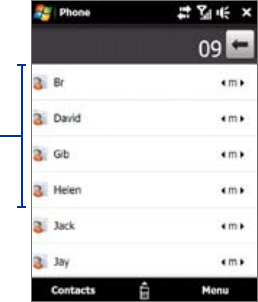
Using Phone Features 31
5. Tap OK.
Note When you assign a new phone number in an occupied speed dial key, the new phone number will replace the
existing one.
Tip To delete a Speed Dial entry, in the Speed Dial list, tap and hold the desired entry, then tap Delete.
Turn the phone function on and off
In many countries, you are required by law to turn off the phone while on board an aircraft.
To enable or disable the phone function
1. Tap Start > Settings > Connections tab > Comm Manager.
2. On the Comm Manager screen, tap the Phone button to enable or disable the phone function.
When enabled, the ON indicator is activated.
To enable or disable Airplane Mode
Another way to turn off the phone function is to switch your device to Airplane Mode.
When you enable Airplane Mode, all wireless radios on your device are turned off, including the phone
function and Bluetooth.
When you disable Airplane Mode, the phone function is turned back on and the previous state of Bluetooth is
restored.
1. Tap Start > Settings > Connections tab > Comm Manager.
2. On the Comm Manager screen, tap the Airplane Mode button to enable or disable Airplane Mode.
When enabled, the ON indicator is activated.
2.3 Smart Dial
Smart Dial panel
Smart Dial makes it easy for you to dial a phone number.
When you start entering a phone number or contact
name, Smart Dial automatically searches and sorts the
contact entries in Contacts, and the phone numbers in
Call History (including incoming, outgoing, and missed
calls). You can then select the desired number or contact
from the filtered list to dial.
To find a contact name or number
You can just enter the first letter of the name or number of a contact. Smart Dial will search for contact
phone numbers and the first character of a contact name as well as from the character that appears after
a space, dash, or underscore in a contact name. For example, if you tap number “2” on the phone keypad,
which is associated with [a, b, and c] on the Phone keypad, contact names such as the following will be
considered matches: “Ben Miller”, “George Adams”, “John-Carter”, “Carter, Ellen”, “Dixon, Allan”, “Thomas_Clark”,
“JaneCampbell”.
If the matching list is long and you want to narrow down the search further, enter another letter. Using the
same example above, if you continue to tap “3” which is associated with [d, e, f], the matching list will be
narrowed down to the following names: “Ben Miller”, “George Adams”, “Carter, Ellen”, “Dixon, Allan”.

32 Using Phone Features
Make a call or send a text message using Smart Dial
1. On the Home screen, tap Phone.
2. Begin entering the first few numbers or characters. When you start entering a number or letter, the
Smart Dial panel will display matches found.
Tip Tap to close the phone keypad to see if there are more matching contacts.
3. In the Smart Dial panel, flick and slide your finger on the touch screen or press Navigation up/down to
browse the list or select a contact.
4. You can do one of the following:
Tap the contact to call the selected contact.
To send a text message to the selected contact, tap Menu > Send Text Message.
To call a different phone number associated with the selected contact, select the contact and then
press Navigation left/right to select the number to call.
•
•
•

Chapter 3
TouchFLO™ 3D
3.1 About TouchFLO™ 3D
3.2 Using the TouchFLO 3D Home Screen
3.3 Finger Gestures
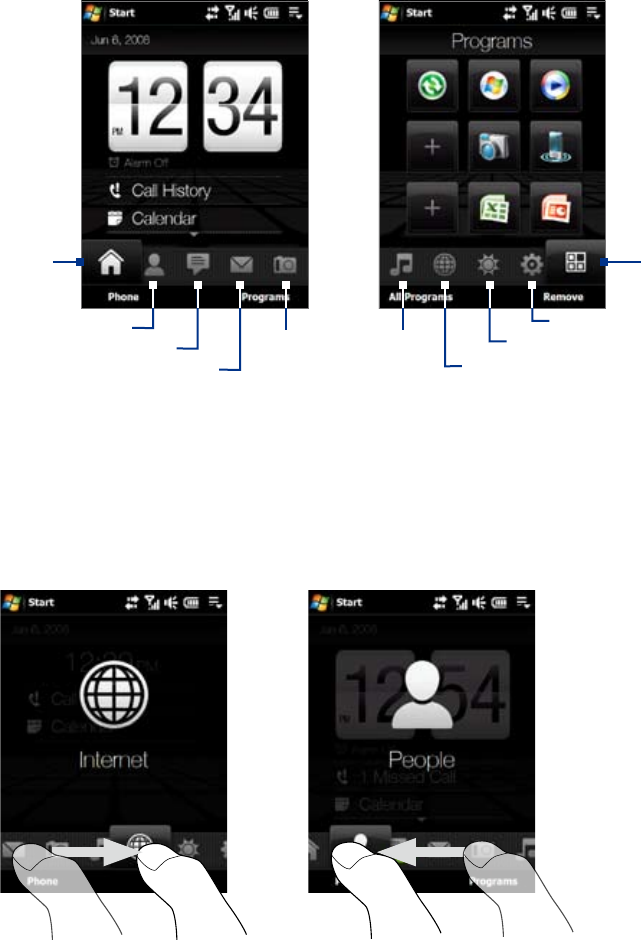
34 TouchFLO™ 3D
3.1 About TouchFLO™ 3D
TouchFLO™ 3D gives you touch control over your Windows Mobile-powered device. TouchFLO 3D provides
the following features:
A Home screen that allows finger-touch access to the most widely-used functions, such as People,
Messages, Mail, Music, Internet, and more.
Allows you to use finger gestures to navigate screens.
3.2 Using the TouchFLO 3D Home Screen
The TouchFLO 3D Home screen have the following tabs:
Home
People
Messages
Mail
Photos and
Videos
Music
Internet
Settings
Programs
Weather
To switch between the tabs of the Home screen
Do one of the following:
Touch or tap the desired tab on the Home screen.
Press Navigation right or left to move to the next or previous tab.
Press and hold your finger on the active tab, then slide your finger right or left over the tabs.
Release when you have selected the desired tab.
Note Apply some pressure when pressing and holding on the active tab to be able to slide over the tabs.
•
•
•
•
•
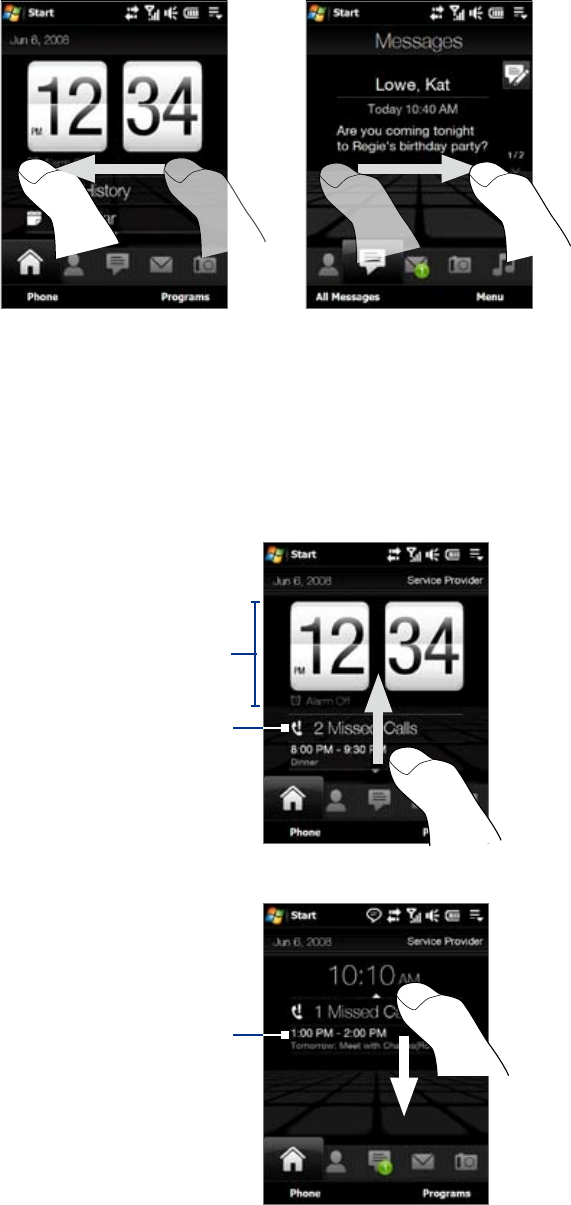
TouchFLO™ 3D 35
Swipe left across the screen to move to the next tab, and swipe right across the screen to move to the
previous tab.
Home
The Home tab displays the current date, a flip-style clock, and an Alarm icon that indicates whether the alarm
is on or off. Missed calls and your upcoming calendar appointments are also shown on the Home tab.
To select an item on the Home tab
Touch the item; or
Press Navigation up or down first to navigate to the item you want to select and then press ENTER.
Touch the date or the flip clock
to open the Clock & Alarms
screen where you can set the
date, time, and alarm.
(See Chapter 13 for details.)
Swipe downward on the screen
to change back to the flip clock.
One all-day appointment and
up to two timed appointments
can be displayed. Touch this
area to create, edit or view an
appointment.
(See “Calendar” in Chapter 12
for details.)
Home tab with smaller digital clock
Swipe upward on the screen to
display the smaller digital clock
and view more appointments.
Touch this area to view details
about missed calls in the Call
History.
(See Chapter 2 for details.)
Home tab with flip clock
•
•
•
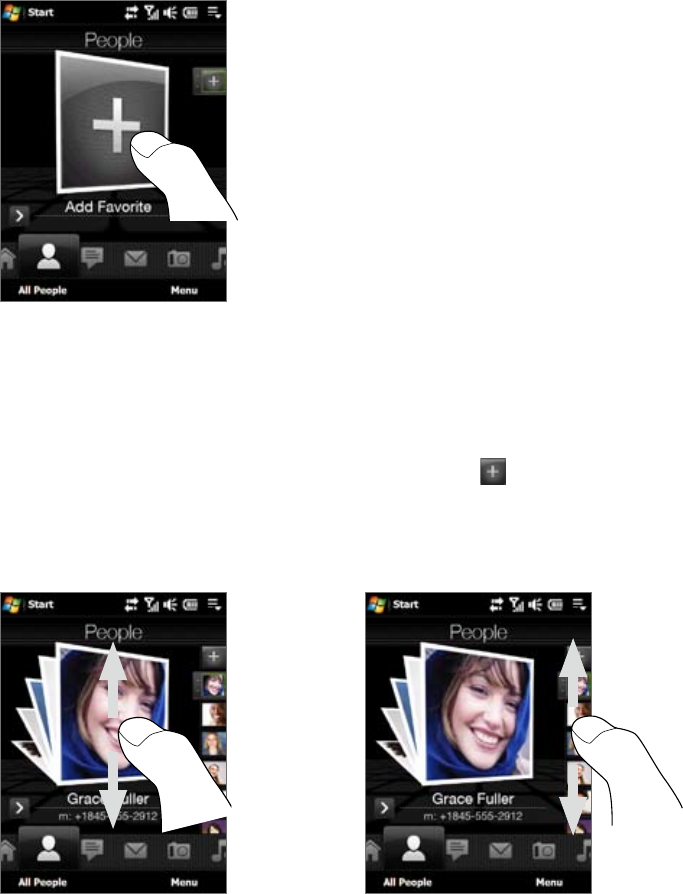
36 TouchFLO™ 3D
People
On the People tab, you can add favorite contacts who you most frequently communicate with. This allows
you to quickly make calls, send text messages, and send e-mails to your favorite contacts.
Tip You can add up to 15 favorite contacts on the People tab.
To add favorite contacts
You should already have created or synchronized contacts on your device before you can add them to the
People tab.
1. On the Home screen, slide your finger to the People tab.
2. Touch the small or big Plus icon, or touch Add Favorite.
3. On the Select a Contact screen, touch the name of the desired contact.
Tip To create a new contact, touch Menu > New Contact. See “Contacts” in Chapter 12 for details.
4. Select a phone number or e-mail address to associate to the favorite contact.
Note If there is no picture associated with the contact, the next screen prompts you to assign a picture to the
contact.
5. To add another favorite contact, touch the small Plus icon ( ) at the right side of the screen and
repeat steps 3 and 4.
To choose from your favorite contacts
Do any of the following:
To flip through the contact pictures
one at a time, swipe your finger up
or down the screen. You can also
press Navigation up or down to flip
through the contact pictures.
On the picture strip at the right side of the People
screen:
Touch the picture of the desired favorite contact; or
Press and hold on the currently selected contact
picture to display a slide-out bar, and then slide up
or down the picture strip. Release your finger when
the desired favorite contact is selected.
•
•
•
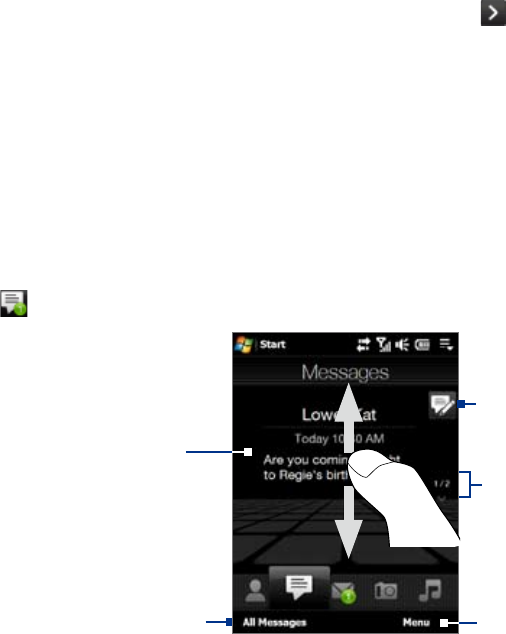
TouchFLO™ 3D 37
After selecting a favorite contact, touch the right arrow icon ( ), the phone number or e-mail address
shown below the contact picture to place a call, send a text message, or send an e-mail to the contact.
Touch the picture of the contact on the center screen to access his or her contact card. On the contact
card, you will see the last outgoing or incoming call as well as contact details such as phone numbers,
e-mail address, and more.
Tips • On the People tab, touch All People to access all contacts that are stored on your device.
• To remove the current favorite contact, touch Menu > Remove Favorite.
Messages
On the Messages tab, you can read text messages as they arrive and create a new text message. When there
are new incoming text messages, the icon on the Messages tab will show the number of new messages. For
example, indicates that there is a new message received.
To view the entire message
thread from the sender and
reply, touch the message on
the screen.
Touch All Messages to access
all text messages in your inbox
and other folders.
Touch this icon to create a new text
message.
To flip through received text messages,
swipe your finger upward/downward,
touch the Up/Down arrow on the
screen, or press Navigation up/down.
Touch Menu to remove the current
message and access more options.
For more information about working with text messages, see “Text Messages” in Chapter 6.
Mail
The Mail tab is where you send and receive e-mail messages. Including Outlook E-mail, you can add up to four
POP3/IMAP4 and Web-based e-mail accounts in this tab.
To add an e-mail account
1. On the Home screen, slide your finger to the Mail tab.
2. If this is your first time to add an e-mail account, touch New Account on the bottom-right side of the
screen.
3. Set up your e-mail account using the E-mail Setup wizard.
4. To add another e-mail account, touch Menu > Accounts > New Account and use the E-mail Setup
wizard to set up your account.
For detailed instructions on setting up e-mail accounts using the E-mail Setup wizard, see Chapter 6.
To check e-mail
When there are new e-mails, the icon on the Mail tab and the respective icons of the e-mail accounts will
show the number of newly received messages.
•
•
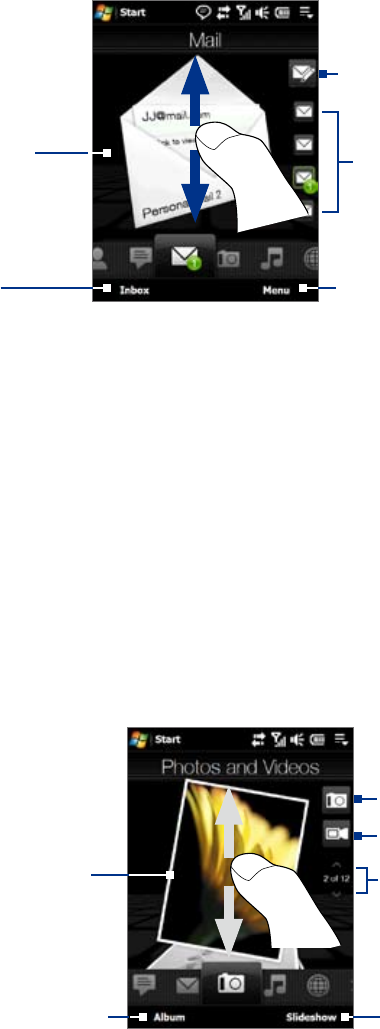
38 TouchFLO™ 3D
To browse through received
e-mails, swipe up or down on
the envelope image or press
Navigation up/down.
Touch the e-mail on the screen
to open and read the message.
•
•
Touch Inbox to access all
e-mail messages of the
currently selected account.
After selecting an e-mail account,
touch this icon to create and send a
new e-mail message.
These are your e-mail accounts.
Touch an icon to select an e-mail
account and view the new e-mails
received in that account.
Touch Menu to access more options.
For more information about working with e-mails, see Chapter 6 and 7.
Photos and Videos
The Photos and Videos tab lets you visually flip through your photos and video clips and view them in full
screen. From this tab, you can also activate the Camera so you can take pictures and record video clips.
The Photos and Videos tab displays pictures and video files from the current favorite album. By default, the
Camera Shots album which stores the pictures and videos that you captured using the device camera is set as
the favorite. You can change to another favorite album, if preferred.
To set an album as a Favorite
1. On the Photos and Videos tab, touch Album to open the Album program.
2. Touch Albums and then select one of the listed favorite albums.
3. Tap Menu > Set as Favorite. and then tap OK on the confirmation screen.
To view photos and videos
Touch the photo or video on
the screen to view or play it
in full screen.
Touch here to open the Album
program. (See “Viewing Photos
and Videos Using Album” in
Chapter 11 for details.)
Touch here to take a photo.
Touch Slideshow to view the
photos as a slideshow. If a video
is selected, touch Play.
To flip through photos and videos,
swipe upward/downward, touch the
Up/Down arrow, or press Navigation
up/down.
Touch here to shoot video.
Tips • For more information about viewing in full screen, see “View an image” and “Play back video” in Chapter 11. The
file formats that can be viewed on the Photos and Videos tab are the same as the Album program.
• To transfer media files from a computer and view them on the Photos and Videos tab, copy or synchronize them
to a folder under \My Device (the device memory) or \Internal Storage (the built-in storage).
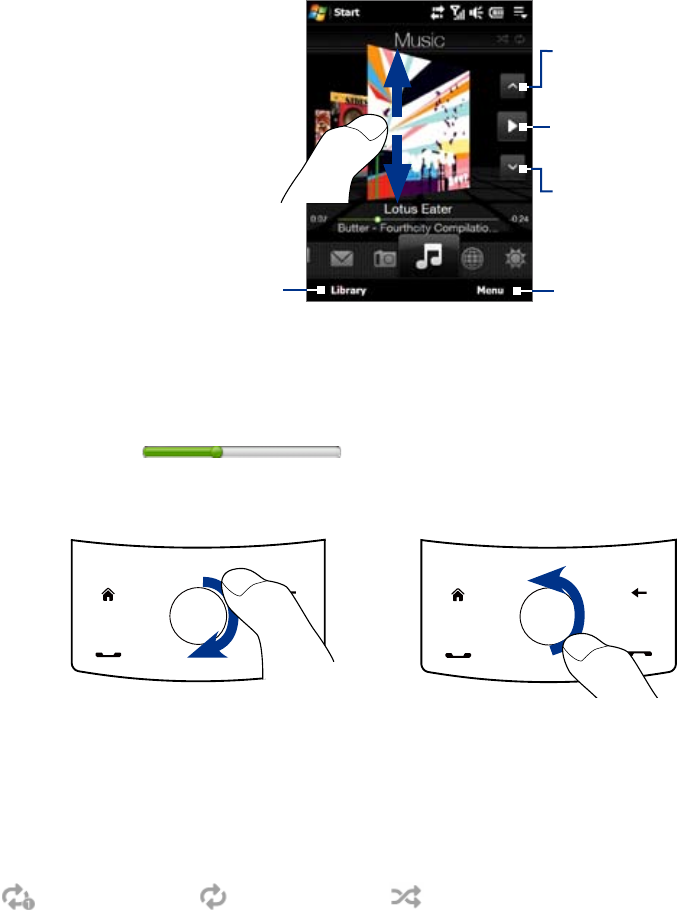
TouchFLO™ 3D 39
Music
The Music tab allows you to visually browse through albums and music tracks and play music. The albums
and music tracks that you see on the Music tab are from the Now Playing list of the Library.
Note Your device searches for all music files that have the following audio formats: MP3 (.mp3), WMA (.wma), AAC/AAC+
(.aac), and MPEG-4 (.m4a). It searches for music from the following locations:
Device: \My Music (including all subfolders)
\My Documents (including all subfolders)
Storage: \Internal Storage (including all subfolders)
To play music
On the Music tab, flip through albums and all the music in each album, then touch the Play icon on the
middle-right side of the screen to start playback.
Touch here to go to the previous
album or the previous music in
the current album.
Swipe upward/downward on the
screen or press Navigation up/
down to flip through albums and
the music or songs in an album.
Touch here to play or pause. You
can also press the ENTER button to
play or pause.
Touch here to go to the next album or
the next music in the current album.
Touch Menu to set music playback to
Repeat, turn Shuffle on or off, and more.
Touch here to access the Library.
To advance forward or backward in the music
Do one of the following:
Touch and hold on the thin bar below the album art to display the progress bar:
Drag your finger right or left on the progress bar to move forward or backward in the current music.
Slide your finger around the Navigation Control as follows:
To move backward in the music,
slide your finger counterclockwise.
Slide your finger clockwise to
advance forward in the music.
To set repeat and shuffle modes
Touch Menu > Repeat and choose whether to repeat once, repeat all, or do not repeat. To toggle shuffle
mode on and off, touch Menu > Shuffle and then select Shuffle On or Shuffle Off.
The icons on the upper-right side of the Music tab show whether repeat and shuffle modes are enabled.
Repeat [One] Repeat [All] Shuffle [On]
•
•
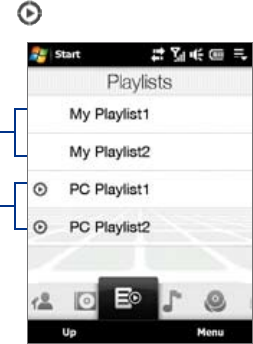
40 TouchFLO™ 3D
To browse and play music in the Library
The Library organizes music into categories, such as Now Playing, Artists, Albums, Genres, All Songs, and
more. When you add more albums or music tracks to your device, go to the Library to locate and play the new
albums or music tracks.
1. On the Music tab, touch Library to open the Library screen.
2. The tabs at the bottom of the Library screen correspond to the different categories. To browse music
under a certain category, slide to the tab that corresponds to the desired category.
3. Tap a music track to play it.
Note When you select a category in the Library such as Artists and play its music, the Now Playing list will be replaced
with the music tracks from that category.
To use playlists
You can group your favorite music into a playlist and then play back the playlist.
To create a new playlist:
1. Select the desired music on the Music tab or the Library.
2. Touch Menu > Add to Playlist.
3. Touch <New Playlist>, enter a Playlist name and then touch OK.
To add more music files to a playlist:
1. On the Playlists tab, touch a playlist to open it.
2. Touch Menu > Edit.
3. Touch Menu > Add.
4. Select the check boxes of the music you want to add to the playlist, or touch Menu > Select All to
choose all the music.
5. Touch OK three times and then touch Up to return to the Playlists tab.
To play back a playlist:
1. On the Playlists tab, touch a playlist to open it.
2. Touch the first song in the playlist. The Music tab starts playing the first song. After each song, the
next one in the playlist will be played.
Note Playlists are not automatically updated when music files have been deleted from the device memory or internal
storage.
There are two types of playlists that can be shown on the Playlists tab:
Custom playlists. Playlists that are created on the Music tab.
Windows Media® Player playlists. Playlists that are in Windows Media® Player Mobile’s Library (which
is synchronized with Windows Media® Player on your computer). They are indicated by the Windows
Media® Player icon ( ). These playlists cannot be edited.
Custom playlists
Windows Media®
Player playlists
Note If a Windows Media® Player playlist contains a combination of music, video and image files, only music files in the
playlist will be synchronized to your device and other media types will be filtered out.
•
•
•
•
•

TouchFLO™ 3D 41
Internet
On the Internet tab, you can open Opera Mobile™ to browse the Web and add Web favorites for one-touch
access to your favorite Web sites.
Touch here to browse the
Web using Opera Mobile.
Touch All Bookmarks to open
Opera Mobile and add, view or
delete Web favorites.
Swipe upward or press Navigation
down to scroll down the screen
and access more Web favorites.
For more information about using Opera Mobile, see Chapter 8.
Weather
The Weather tab shows you the current weather as well as weather information for the next five days of the
week.
To add a city
The Weather tab can display weather information of your local city and other added cities. Follow the steps
below to add a city on this tab.
Tip You can add up to 10 cities in the Weather tab.
1. On the Weather tab, touch Menu > Add Location.
2. The Select Country screen then appears. Flick your finger on the screen repeatedly in light, quick
strokes to continuously scroll down the list of countries. You can also slowly scroll through the country
list by dragging your finger upward on the screen. Touch the desired country to select it.
3. The Select City screen then appears. Flick your finger on the screen repeatedly in light, quick strokes
to continuously scroll down the list of cities. You can also slowly scroll through the city list by dragging
your finger upward on the screen. Touch the desired city to select it.
To view weather information
Your device automatically connects to the Internet via the data connection or Wi-Fi to download and display
weather information. The current temperature, temperature range, type of weather (sunny, cloudy, showers,
or others), and the time of day (daytime or nighttime) are shown on the Weather tab. To see the weather
information for the next five days of the week, touch the screen or touch 5-day at the bottom-left side of the
screen.
Touch the screen or touch 5-day
at the bottom to see the weather
information for the next five days
of the week.
Touch Menu to add or delete a
city, change the temperature to
Celsius or Fahrenheit, and more.
Shows the last weather update.
Touch this item to download the
latest weather information.
To switch between cities, swipe your
finger upward/downward, touch the
Up/Down arrow on the screen, or
press Navigation up/down.
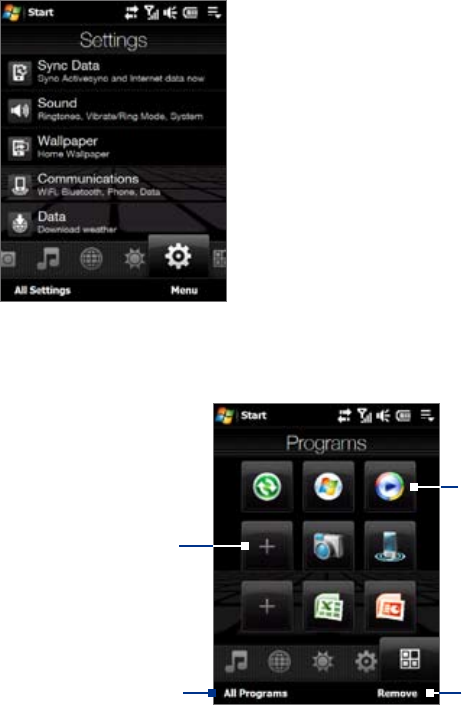
42 TouchFLO™ 3D
To choose download options
1. On the Weather tab, touch Menu > Settings.
Tip You can also slide to the Settings tab and then touch Data.
2. You can choose from the following options:
Download weather automatically. When this option is selected, weather information is
automatically downloaded from the AccuWeather Web site whenever you select the Weather tab,
if the data has not been updated within the last three hours. Weather data is also downloaded every
time an ActiveSync connection is established (through over-the-air or USB connections). Clear this
option if you prefer to manually download weather information.
Download weather when roaming. Select this option only if you want to allow automatic
download of weather data when roaming. This may incur additional costs.
Settings
The Settings tab allows you to synchronize information with your computer or the Exchange Server, change
sound settings such as the ring tone, and choose a different wallpaper for the Home tab. You can also easily
turn on and off the communications features of your device such as Wi-Fi, Bluetooth, and more.
Programs
The Programs tab allows you to add your favorite programs for one-touch access.
Touch a program icon to
open the corresponding
program.
Touch Remove to choose
which program to remove
from the Programs tab.
Touch an empty slot to
add a favorite program.
Touch All Programs to
access all the programs
of your device.
When you have filled up the screen with programs, scroll down the Programs tab to access more empty slots
and add more programs. To scroll down, press and hold on the screen and then drag your finger upward. You
can add up to 18 favorite programs.
To scroll back up, press and hold on the screen and then drag your finger downward.
Note To replace a slot with another program, you must delete the occupying program shortcut first and then add your
desired program.
•
•

TouchFLO™ 3D 43
3.3 Finger Gestures
You can use finger gestures to scroll, zoom and pan on the touch screen.
Finger scrolling
Finger scrolling can be used to scroll up and down Web pages, documents, and lists such as the contacts list,
file list, message list, calendar appointments list, and more.
When finger scrolling,
swipe or flick your finger
on the touch screen.
To scroll up and down
To scroll down, swipe your finger upward on the touch screen. To scroll up, swipe your finger downward
on the touch screen.
To auto-scroll, flick your finger upward or downward on the touch screen. Touch the screen to stop
scrolling.
To scroll left and right
To scroll towards the right, swipe your finger to the left.
To scroll towards the left, swipe your finger to the right.
To auto-scroll, flick your finger left or right. Touch the screen to stop scrolling.
Finger zooming
The type of finger gesture to use when zooming varies in different programs.
To zoom in on a Web page in Opera Mobile, tap your finger twice on the screen. See “Using Opera
Mobile” in Chapter 8 for details.
To zoom in on a photo in Album, make a full-circle swipe on the touch screen. See “Viewing Photos and
Videos Using Album” in Chapter 11 for details.
Finger panning
You can use finger panning to move to and view other parts of a zoomed
photo, Web page, document, or an e-mail. To pan, touch and hold on the
touch screen and then drag your finger in any direction.
Tip To enable or mute finger scrolling and panning sound, touch Start > Settings
> System tab > TouchFLO, and then select or clear the Enable sound when
finger scrolling and panning check box.
•
•
•
•
•
•
44 TouchFLO™ 3D

Chapter 4
Entering Text
4.1 Selecting an Input Method
4.2 Using the Full QWERTY
4.3 Using the Compact QWERTY
4.4 Using the Phone Keypad
4.5 Using Multitap and T9 Modes
4.6 Using Numeric and Symbol Mode
4.7 Using Block Recognizer
4.8 Using Letter Recognizer
4.9 Using Transcriber
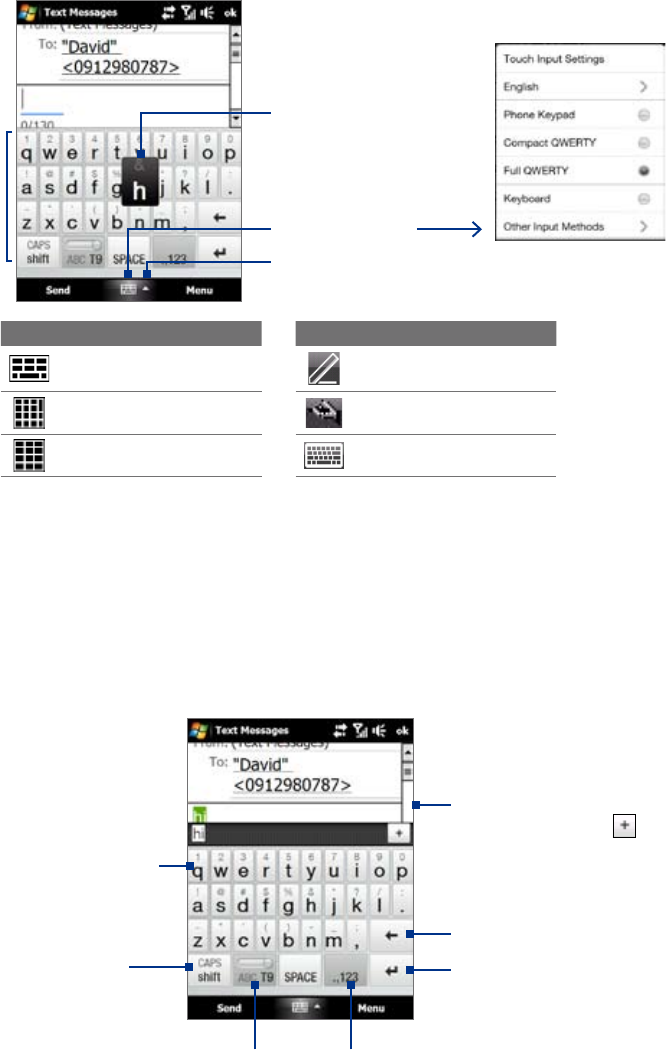
46 Entering Text
4.1 Selecting an Input Method
When you start a program or select a field that requires text or numbers, the Input Panel icon becomes
available on the menu bar.
Tap the Input Selector arrow (that appears next to the Input Panel icon) to open a menu where you
can select a text input method and customize input options. After selecting a text input method, the
corresponding Input Panel is displayed, which you can use to enter text.
Tip Select Other Input Methods to display more input methods.
To show or hide the Input Panel, tap the Input Panel icon.
Input Panel
(Full QWERTY)
Input Selector arrow
Input Panel icon
Text input methods
Key when pressed
Icon Input method Icon Input method
Full QWERTY Letter Recognizer or
Block Recognizer
Compact QWERTY Transcriber
Phone Keypad Keyboard
Notes • Some text input methods may not be available in certain language versions of the device.
• When in landscape mode, the Compact QWERTY and Phone Keypad are not available.
4.2 Using the Full QWERTY
The Full QWERTY is a full on-screen QWERTY keyboard layout similar to a desktop PC keyboard.
Tip You can also use the Windows Mobile on-screen keyboard which also has a QWERTY keyboard layout by selecting
Keyboard (or Other Input Methods > Keyboard) on the Text input method menu.
• Tap to enter letters or symbols.
• Tap and hold to enter a punctuation
mark, symbol, or number that
appears on top of a key
• Tap to enter an uppercase letter.
• Tap twice to turn on Caps Lock.
Tap to toggle between
using Normal or T9 mode.
Tap to open a keyboard layout that lets you easily
enter numbers and symbols.
See “Using Numeric and Symbol mode” for details.
Tap to create a new line.
Tap to delete the previous character.
Displays the word candidate list
in T9 mode. Tap a word to insert
it into your text. Tap to add a
word to the T9 dictionary.
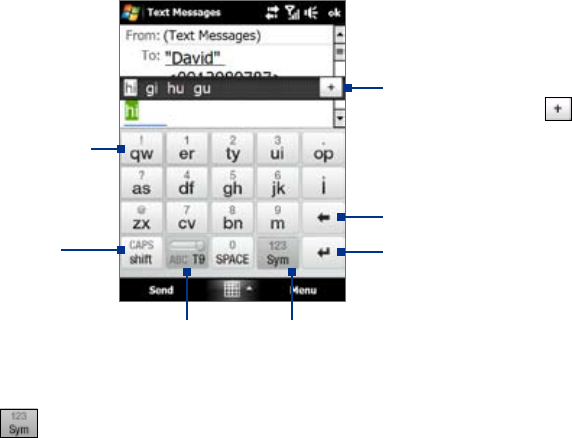
Entering Text 47
To enter text using the Full QWERTY
1. Start a program that accepts text input, such as Word Mobile.
2. Tap the Input Selector arrow, then tap Full QWERTY.
3. Start tapping keys on the keyboard as you would on a PC keyboard to enter your text. To learn how to
enter text using T9 mode, see “Using Multitap and T9 modes” in this chapter.
4.3 Using the Compact QWERTY
The Compact QWERTY is a type of on-screen keyboard which features 20 keys. With its large, touch-friendly
keys and enhanced features such as T9 predictive input, you can enter text faster and more accurately.
• Tap to enter letters or symbols.
• Tap and hold to enter a punctuation
mark, symbol, or number that
appears on top of a key
• Tap to enter an uppercase letter.
• Tap twice to turn on Caps Lock.
Tap to toggle between
using Multitap or T9 mode.
Tap to open a keyboard layout that lets you easily
enter numbers and symbols.
See “Using Numeric and Symbol mode” for details.
Tap to create a new line.
Tap to delete the previous character.
Displays the word candidate list
in T9 mode. Tap a word to insert
it into your text. Tap to add a
word to the T9 dictionary.
Tip You can tap and hold to immediately open the numeric keyboard.
To enter text using the Compact QWERTY
1. Start a program that accepts text input, such as Word Mobile.
2. Tap the Input Selector arrow, then tap Compact QWERTY.
3. Start tapping keys on the keyboard to enter your text. To learn how to enter text using Multitap or T9
mode, see “Using Multitap and T9 modes” in this chapter.
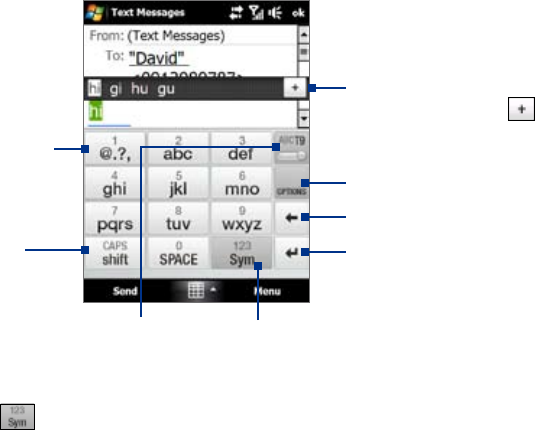
48 Entering Text
4.4 Using the Phone Keypad
The Phone Keypad is a 12-key on-screen keypad that has a layout similar to mobile phone keypads, plus
some additional keys. The Phone Keypad has large keys and enhanced input features such as T9 predictive
input, which makes it faster for you to enter text in your messages and documents.
Tap to open the input settings.
• Tap to enter letters or symbols.
• Tap and hold to enter a punctuation
mark, symbol, or number that
appears on top of a key
• Tap to enter an uppercase letter.
• Tap twice to turn on Caps Lock.
Tap to toggle between
using Multitap or T9 mode.
Tap to open a keyboard layout that lets you easily
enter numbers and symbols.
See “Using Numeric and Symbol mode” for details.
Tap to create a new line.
Tap to delete the previous character.
Displays the word candidate list
in T9 mode. Tap a word to insert
it into your text. Tap to add a
word to the T9 dictionary.
Tip You can tap and hold to immediately open the numeric keyboard.
To enter text using the Phone Keypad
1. Start a program that accepts text input, such as Word Mobile.
2. Tap the Input Selector arrow, then tap Phone Keypad.
3. Start tapping keys on the keyboard to enter your text. To learn how to enter text using Multitap or T9
mode, see “Using Multitap and T9 modes” in this chapter.
4.5 Using Multitap and T9 Modes
When using the on-screen keyboards, you can choose to enter text using Multitap or T9 mode.
Multitap mode
In Multitap mode (for Compact QWERTY and Phone Keypad), enter a character by tapping a key until the
desired character is displayed on the screen.
To enter the first letter that shows on a key, tap the key once. To enter the second letter, tap twice.
To enter a punctuation mark, symbol, or number that appears on top of a key, tap and hold the key.
T9 mode
T9 is a predictive text input mode which displays a word candidate list as you enter the first few characters so
you just select the word that you want.
To enter text using T9 mode
1. Start entering the first few letters of a word. As you enter each letter, predicted words will appear above
the keyboard.
2. Tap the desired word to immediately insert it to your text.
Note Navigate through the word candidate list if there are more words to choose from.
•
•
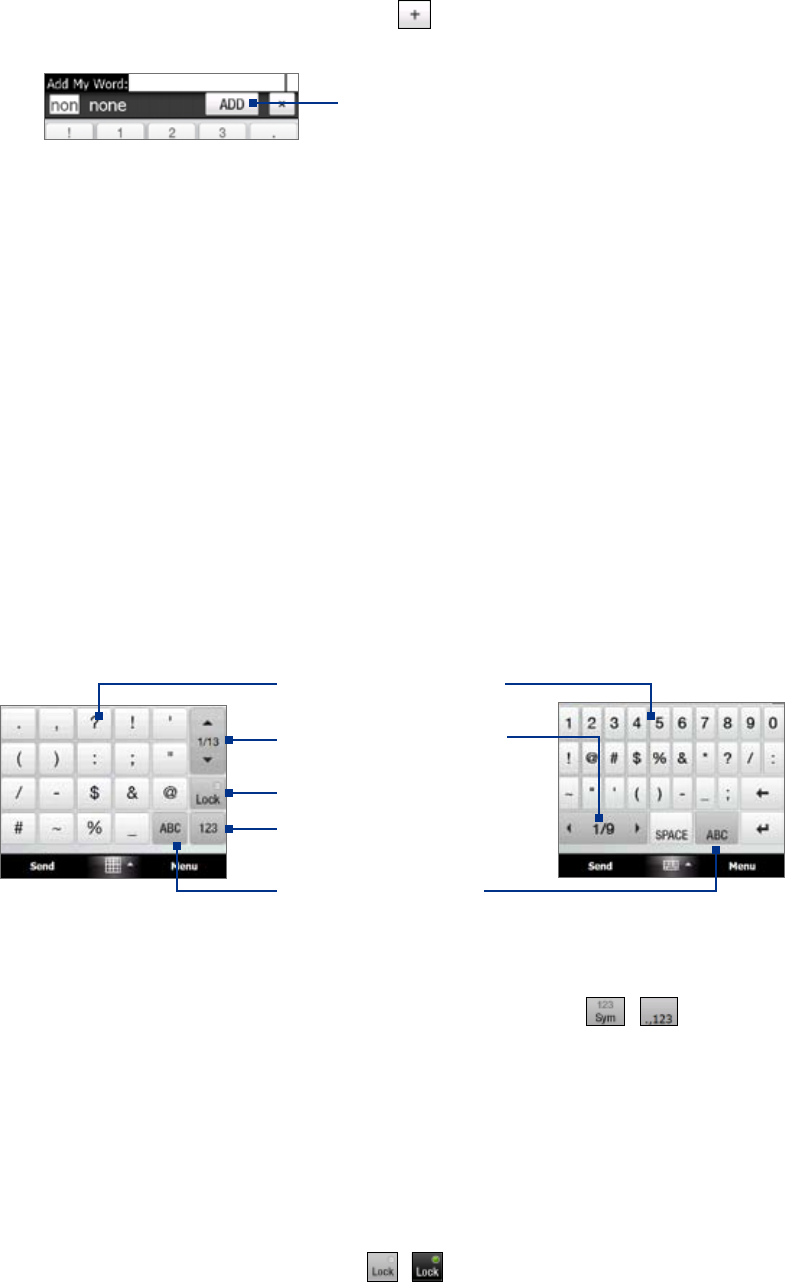
Entering Text 49
To add a word to the T9 dictionary
If the word that you have entered is not found in the dictionary, you can add it to the dictionary.
1. While in T9 mode, type a letter and then tap on right side of the word candidate list.
2. Type the word you want to add and then tap ADD.
Tap to not add the word.
To customize Touch Input settings
1. Tap the Input Selector arrow, then tap Touch Input Settings.
2. On the Touch Input Settings screen, select or clear the following options according to your preferences:
Spell Correction. Lets you correct typographical errors by selecting from a list of possible words
that reflect the characters of the keys you have tapped as well as characters of nearby keys.
Word Completion in T9 mode. Lets you select from a list of possible words based on the keys that
you have tapped and on the words available in the dictionary.
Word Completion in ABC mode. Lets you select from a list of possible combinations based on the
characters that appear on the keys that you tapped.
Auto-Substitution. Automatically inserts an apostrophe when you type common contracted
words (for example, “dont” automatically becomes “don’t”).
3. Tap Done.
4.6 Using Numeric and Symbol Mode
Switch to Numeric and Symbol mode to let you easily enter numbers and common symbols such as
parentheses, braces, currency signs, punctuation marks, special characters, and more. Numeric and Symbol
mode is available when using the Full QWERTY, Compact QWERTY, and Phone Keypad.
Tap a number or symbol to
insert it into your text.
Tap to go to the previous or
next page of symbols.
Tap to switch back to the
letter keyboard layout.
Tap to switch to the numeric
keyboard
See “To lock the keyboard in
Numeric and Symbol mode.”
Compact QWERTY
and Phone Keypad Full QWERTY
To switch to Numeric and Symbol mode
1. While using Full QWERTY, Compact QWERTY, or Phone Keypad, tap / .
2. Locate the number or symbol, then tap it to insert it into your text.
To lock the keyboard in Numeric and Symbol mode
You can lock the keyboard in Numeric and Symbol mode so you can continuously enter symbols and
numbers.
1. Tap the Input Selector arrow and then tap Other Input Methods > Options.
2. In the Input Method tab, select a Touch input method in the Input method list, then tap Options.
3. Clear the Turn on one-touch symbol entry check box.
Tip In Compact QWERTY and Phone Keypad, tap / to toggle between locking the keyboard in Numeric and
Symbol mode and switching back to the letter keyboard layout after tapping a symbol or number.
•
•
•
•

50 Entering Text
4.7 Using Block Recognizer
With Block Recognizer, you use a single stroke to write letters, numbers, symbols, and punctuation, which
are then converted into typed text.
To use Block Recognizer
1. From a program, tap the Input Selector arrow and then tap Other Input Methods > Block
Recognizer.
2. Write characters, numbers, and symbols in the designated writing area.
Enter letters by writing in the abc (left) area of the box.
Enter numbers by writing in the 123 (right) area of the box.
Enter symbols and punctuation by tapping the left or right area of the box (a gray dot appears),
then writing the desired character.
Tip For help with writing characters, tap the question mark near the writing area.
4.8 Using Letter Recognizer
With Letter Recognizer, you can write individual letters, numbers, and punctuation marks, which are then
converted into typed text.
To use Letter Recognizer
1. From a program, tap the Input Selector arrow and then tap Other Input Methods > Letter
Recognizer.
2. Write characters, numbers, and symbols in the designated writing area.
Enter uppercase letters by writing in the ABC (left) area of the box.
Enter lowercase letters by writing in the abc (middle) area of the box.
Enter numbers by writing in the 123 (right) area of the box.
Enter punctuation and symbols by writing the desired character in the 123 (right) area of the box.
Tip For help with writing characters, tap the question mark near the writing area.
4.9 Using Transcriber
Transcriber is a handwriting recognition program that enables you to write in cursive, print, or a combination
of both.
To write using Transcriber
1. Open a program that accepts user input, such as Word Mobile.
2. Tap the Input Selector arrow and then tap Other Input Methods > Transcriber. The Transcriber
introductory screen appears. Read the introduction and tap OK.
3. Position the cursor where you want text to appear.
4. Use the stylus to write anywhere on the screen. The handwriting will be converted to text shortly after
you lift the stylus from the screen.
To enter punctuation and symbols
Transcriber comes with an on-screen keyboard that provides an easy way to add punctuation or a special
symbol to existing text. To use this on-screen keyboard, tap on the Transcriber toolbar.
The keyboard remains visible until you tap the button again.
Tips • To reposition the keyboard, tap and hold the title bar, then drag to the desired location.
• When no text is selected, you can open the keyboard by using the gesture (draw a line straight down and
then straight up). For more information about using Transcriber gestures, see Help on your device.
•
•
•
•
•
•
•
Entering Text 51
To edit text
1. In a program, draw a line from left to right across the text you want to edit.
2. After you lift the stylus from the screen, the line disappears and the selected text will be highlighted.
3. Do either of the following:
Rewrite the text.
Use gestures to capitalize letters, insert a space, and so on. For information about using Transcriber
gestures, see Help on your device.
•
•
52 Entering Text

Chapter 5
Synchronizing Information
With Your Computer
5.1 About Synchronization
5.2 Setting Up Windows Mobile® Device Center
on Windows Vista®
5.3 Setting Up ActiveSync® on Windows XP®
5.4 Synchronizing With Your Computer
5.5 Synchronizing via Bluetooth
5.6 Synchronizing Music and Video
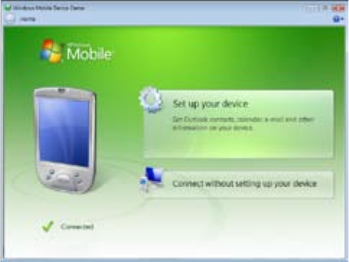
54 Synchronizing Information With Your Computer
5.1 About Synchronization
You can take information from your computer wherever you go by synchronizing them to your device. The
following types of information can be synchronized between your computer and your device:
Microsoft® Office Outlook® information, which include Office Outlook e-mail, contacts, calendar,
tasks, and notes
Notes, which are created using Microsoft® Office OneNote® 2007
Media, such as pictures, music, and video
Favorites, which are the bookmarked links to your favorite Web sites
Files, such as documents and other files
Before you can synchronize, you need to install and set up first the synchronization software on your
computer. For more information, see “Setting Up Windows Mobile Device Center on Windows Vista®” and
“Setting Up ActiveSync® on Windows XP®” in this chapter.
Ways to synchronize
After you have installed the synchronization software on your computer, connect and synchronize your
device with your computer by:
Using the supplied USB sync cable.
Upon connecting the sync cable to your device and your computer, the synchronization process
automatically starts.
Using Bluetooth.
You must first set up a Bluetooth partnership between your device and your computer before you
can synchronize information between them using Bluetooth. For more information about setting up
a Bluetooth partnership, see Chapter 9. For information about synchronizing through Bluetooth, see
“Synchronizing via Bluetooth” later in this chapter.
Try to synchronize regularly in order to keep information up-to-date in both your device and your computer.
Note You can also synchronize Outlook e-mail, contacts, calendar, and tasks on your device with the Exchange Server
at your work. For more information about setting up your device to synchronize with the Exchange Server, see
Chapter 7.
5.2 Setting Up Windows Mobile® Device Center on Windows Vista®
Microsoft Windows Mobile® Device Center is the replacement for Microsoft® ActiveSync® on Windows Vista®.
Note Some versions of Windows Vista® come with Windows Mobile Device Center already installed. If Windows Mobile
Device Center is not available on your Windows Vista®, you can install it from the Getting Started Disc that came
with your device.
Set up synchronization in Windows Mobile Device Center
When you connect your device to your computer and start Windows Mobile Device Center for the first time,
you are asked to create a Windows Mobile partnership with your device. To create a partnership:
1. Connect your device to your computer. Windows Mobile
Device Center configures itself, then opens.
2. On the license agreement screen, click Accept.
3. On the Windows Mobile Device Center’s Home screen,
click Set up your device.
Note Choose Connect without setting up your device
if you only want to transfer media files, check for
updates, and explore your device but not synchronize
Outlook information.
4. Select the items you want to synchronize, then click Next.
5. Enter a device name, then click Set Up.
When you finish the setup wizard, Windows Mobile Device Center synchronizes your device automatically.
Notice that Outlook e-mails and other information appear on your device after synchronization.
•
•
•
•
•
•
•
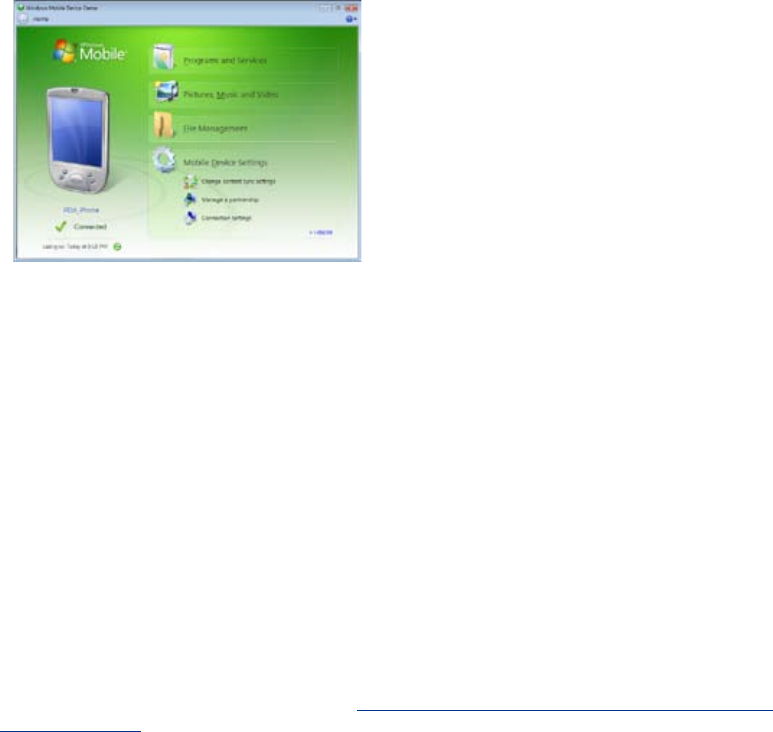
Synchronizing Information With Your Computer 55
Use Windows Mobile Device Center
To open Windows Mobile Device Center, click Start > All Programs > Windows Mobile Device Center on
your Windows Vista computer.
On Windows Mobile Device Center, you can do the following:
Click Mobile Device Settings to change synchronization settings.
When you click Pictures, Music and Video > XX new pictures/video clips are available for import, a
wizard guides you to tag and transfer photos from your device to the Photo Gallery on your computer.
Click Pictures, Music and Video > Add media to your device from Windows Media Player to
synchronize music and video files using Windows Media® Player. For more information, see “Using
Windows Media® Player Mobile” in Chapter 11.
Click File Management > Browse the contents of your device to view documents and files on your
device.
Note See Windows Mobile Device Center Help for more information.
5.3 Setting Up ActiveSync® on Windows XP®
The Getting Started disc that comes with your device contains Microsoft ActiveSync 4.5 or later. Follow the
steps in this section to install and set up ActiveSync on Windows XP or other compatible Windows systems.
Note For a list of compatible Windows systems, go to http://www.microsoft.com/windowsmobile/activesync/
activesync45.mspx.
Install ActiveSync
1. Place the Getting Started disc to the disc drive of your computer.
2. Click Setup and Installation.
3. Select the ActiveSync check box, then click Install.
4. Read the license terms, then click Accept.
5. When installation is completed, click Done.
6. On the Getting Started with Windows Mobile screen, click Close.
Set up synchronization in ActiveSync
1. Connect your device to your computer. The Synchronization Setup Wizard automatically starts and
guides you to create a synchronization partnership. Click Next to proceed.
2. To synchronize your device with your computer, clear the Synchronize directly with a server running
Microsoft Exchange check box, then click Next.
3. Select the information types that you want to synchronize, then click Next.
4. Select or clear the Allow wireless data connections check box according to your preference.
5. Click Finish.
When you finish the wizard, ActiveSync synchronizes your device automatically. Notice that Outlook e-mails
and other information appear on your device after synchronization.
•
•
•
•
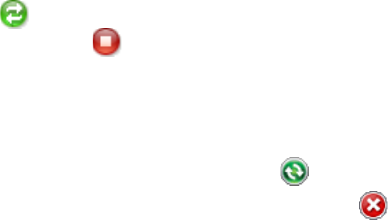
56 Synchronizing Information With Your Computer
5.4 Synchronizing With Your Computer
Connect and synchronize your device with your computer using the USB cable or Bluetooth connection.
Start and stop synchronization
You can manually synchronize either from your device or computer.
From your device
On the TouchFLO 3D Home screen, slide to the Settings tab and then touch Sync Data; or
Tap Start > Programs > ActiveSync, then tap Sync. To end synchronization before it completes, tap
Stop.
Tip To delete a partnership with one computer completely, disconnect your device from that computer first. In
ActiveSync on your device, tap Menu > Options, tap the computer name, then tap Delete.
From Windows Mobile Device Center
1. Click Start > All Programs > Windows Mobile Device Center.
2. Click at the lower left of the Windows Mobile Device Center. To end synchronization before it
completes, click .
From ActiveSync on your computer
When you connect your device to your computer, ActiveSync automatically opens on your computer and
synchronizes.
To manually start synchronization, click .
To end synchronization before it completes, click .
Change which information is synchronized
You can change the information types and the amount of information to synchronize for each type either on
your device or your computer. Follow the steps below to change synchronization settings on your device.
Note Before changing synchronization settings on your device, disconnect it from your computer.
1. In ActiveSync on your device, tap Menu > Options.
2. Select the check box for any items you want to synchronize. If you cannot select a check box, you might
have to clear the check box for the same information type elsewhere in the list.
3. To change synchronization settings for an information type, for instance, E-mail, select it and tap
Settings.
You can then set the download size limit, specify the time period of information to download, and more.
Notes • Some information types such as Favorites, Files and Media cannot be selected in ActiveSync Options on
your device. You can only select or clear these items from your computer’s Windows Mobile Device Center or
ActiveSync.
• A computer can have sync partnerships with many different Windows Mobile powered devices, but a device
can have sync partnerships with at most two computers. To ensure that your device will synchronize properly
with both computers, set up the second computer using the same synchronization settings you used on the first
computer.
• Outlook e-mail can be synchronized with only one computer.
Troubleshoot sync connection problem
In some cases, when the computer connects to the Internet or a local network, it may disconnect the
connection with your device in favor of the Internet or network connection.
If this happens, tap Start > Settings > Connections tab > USB to PC, then clear the Enable advanced
network functionality check box. This makes your computer utilize a serial USB connection with your device.
•
•
•
•
Synchronizing Information With Your Computer 57
5.5 Synchronizing via Bluetooth
You can connect and synchronize your device with the computer using Bluetooth.
Note To connect and synchronize your device with a computer via Bluetooth, your computer must have a built-in
Bluetooth or installed with a Bluetooth adapter or dongle.
To synchronize with a computer via Bluetooth
1. Set up Windows Mobile Device Center or ActiveSync on your computer to synchronize through
Bluetooth. See the program’s Help for instructions.
2. On your device, tap Start > Programs > ActiveSync.
3. Make sure that Bluetooth on both your device and the computer are turned on and set to visible mode.
See “Bluetooth Modes” in Chapter 9 for details.
If this is the first time you have connected to this computer via Bluetooth, you must first complete the
Bluetooth wizard on your device and set up a Bluetooth partnership between your device and the
computer. For more information about creating a Bluetooth partnership, see “Bluetooth Partnerships”
in Chapter 9.
4. Tap Menu > Connect via Bluetooth. Make sure the Bluetooth function of both your device and the
computer are turned on and set to visible mode.
Note To conserve battery power, turn off Bluetooth when not in use.
5.6 Synchronizing Music and Video
If you want to carry your music or other digital media along with you while you travel, set up Windows Media®
Player on your computer to synchronize music and video with your device.
Other than selecting the Media information type to be synchronized, all media synchronization settings must
be set in Windows Media® Player. Before media can be synchronized, you must do the following:
Install Windows Media® Player Version 11 on your computer. (Windows Media® Player 11 works only in
Windows XP or later versions).
Connect your device to the computer with a USB cable. If your device is currently connected using
Bluetooth, you must end that connection before media can be synchronized.
Set up a sync partnership between your device and your computer’s Windows Media® Player.
For more information about using Windows Media® Player Mobile, see Chapter 11.
•
•
•
58 Synchronizing Information With Your Computer

Chapter 6
Exchanging Messages
6.1 Messaging
6.2 Text Messages
6.3 Types of E-mail Accounts
6.4 E-mail Setup Wizard
6.5 Using E-mail
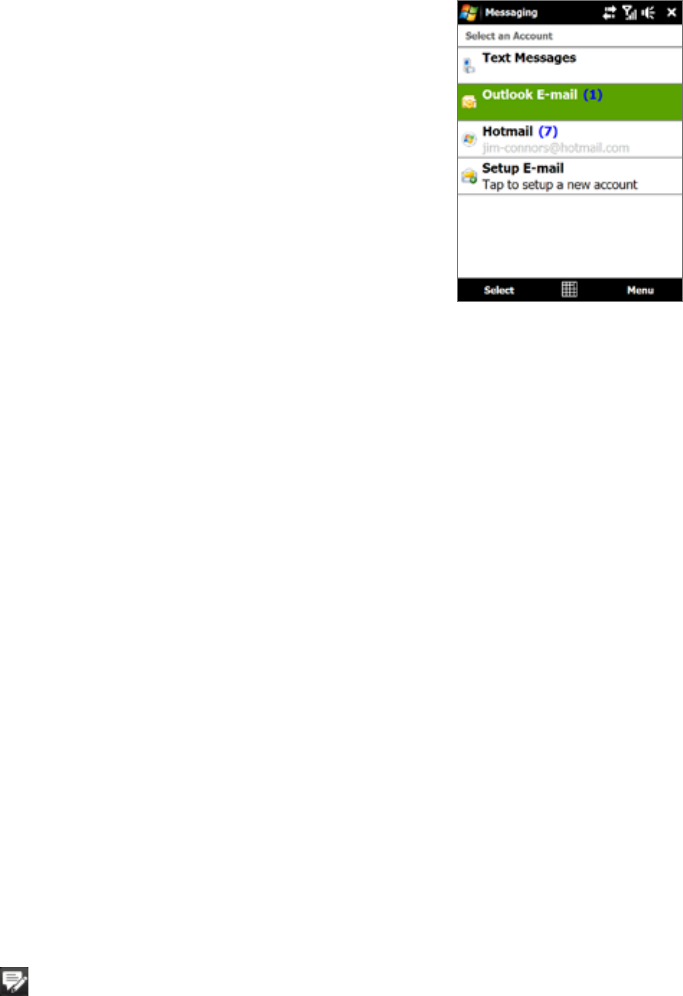
60 Exchanging Messages
6.1 Messaging
Messaging is a central location where you will find all types of messaging accounts, which include text
messages (SMS) and e-mail accounts.
To select a messaging account
Account Picker screen
Do one of the following:
On the TouchFLO 3D Home screen, slide to the Mail tab and then
touch Menu > Accounts > Accounts. The Account Picker screen then
opens where you can select an account.
Tip You can also tap Start > Messaging to access the Account Picker
screen.
While you are in a message list of a certain account, for example Text
Messages, tap Menu > Go To to switch to other types of messaging
accounts.
To configure message account settings
Tap Menu > Options on the Account Picker screen; or
Tap Menu > Tools > Options while you’re in a message list.
•
•
•
•
To automatically add a signature in outgoing messages
You can automatically add your name and other information as your signature in outgoing SMS and e-mail
messages:
Note You need to specify your signature for each type of messaging account.
1. Tap Start > Messaging, then tap Menu > Options.
2. Tap Signatures.
3. Select a messaging account in which to add a signature.
4. Select the Use signature with this account check box.
5. In the provided text box, enter the information that will be displayed as your signature.
6. If you want the signature to be added whenever you reply or forward messages, select the Use when
replying and forwarding check box, then tap OK.
7. Repeat the steps to add a signature to other messaging accounts.
6.2 Text Messages
Send short text messages (SMS) up to 160 characters long to other mobile phones.
Create a new text message
Depending on your preference, there are a number of alternative ways you can create a new text message.
From the TouchFLO 3D Home screen
1. On the Home screen, slide to the Messages tab.
2. Touch the New icon ( ) on the upper right side of the screen.
Tip To send a text message to a favorite contact, first select the photo of the desired contact in the People tab to open
his or her contact card and then touch Send text message. For more information about working with favorite
contacts, see “People” in Chapter 3.
From the Account Picker screen
1. Tap Start > Messaging > Text Messages.
2. Tap Menu > New.
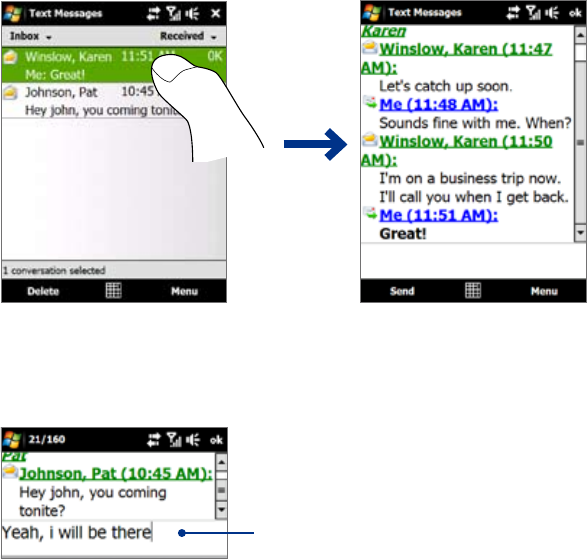
Exchanging Messages 61
From the Contacts screen
1. Tap Start > Contacts.
2. Tap the contact’s name to open his or her contact card.
3. Touch Send text message.
Compose and send a text message
After creating a new text message, follow the steps below to enter your message and then send it.
1. To add recipients,
enter their mobile phone numbers in the To field, separating them with a semicolon.
Y
ou can also tap To or tap Menu > Add Recipient to add mobile phone numbers from Contacts.
2. Enter your message.
Tip To choose from preset messages, tap Menu > My Text and tap a desired message. To check the
spelling, tap Menu > Spell Check.
3. Tap Send.
Tips • For more information about entering text and symbols, see Chapter 4.
• If you want to know when a text message is received, before sending the message that you are composing, tap
Menu > Message Options, then select the Request message delivery notification check box.
• To always receive a delivery notification, tap Menu > Tools > Options in the text message list, tap Text
Messages, then select the Request delivery notifications check box.
Manage text messages
Text messages that are sent to and received from a contact (or number) are grouped as a single thread in
your inbox. Threaded SMS lets you see exchanged messages (similar to a chat program) with a contact on the
screen.
To reply to a text message
1. In the Text Messages inbox, tap a message thread to open it.
2. At the bottom of the screen, type your reply message and then tap Send.
Enter your reply message here
To delete a message in the thread
1. In the Text Messages inbox, tap a message thread to open it.
2. Use the Navigation Up or Down control to select a message in the thread that you want to delete.
3. Tap Menu > Delete.
62 Exchanging Messages
To delete all messages in a thread
1. In the Text Messages inbox, select a message thread using the Navigation Up or Down control.
2. Tap Delete.
6.3 Types of E-mail Accounts
You can set up the following types of e-mail accounts on your device:
Outlook e-mail that you sync with your computer or the Exchange Server.
E-mail account that you have from an Internet Service Provider (ISP) or other e-mail provider.
Web-based e-mail accounts such as Gmail®, Yahoo!® Mail Plus, AOL®, and others.
Work account that you access using a VPN connection.
Set up your device to synchronize Outlook e-mail with the computer
If you have installed the synchronization software on your computer and created a partnership with your
device, then your device is ready to send and receive Outlook e-mail.
If you have not yet installed the synchronization software nor created a partnership, do so by following the
procedures in Chapter 5.
Tip To set up your company e-mail account so that you can access Outlook e-mail messages wirelessly, you must set
up your device to synchronize via an over-the-air connection with your company’s Exchange Server. For more
information about synchronizing with your company e-mail server, see Chapter 7.
Add an e-mail account
To add a new e-mail account, you can do one of the following:
On the TouchFLO 3D Home screen, slide to the Mail tab and then touch Menu > Accounts > New
Account; or
Tap Start > Messaging > Setup E-mail.
The E-mail Setup wizard then opens and lets you enter your e-mail account settings. See “E-mail Setup Wizard”
in this chapter for details.
6.4 E-mail Setup Wizard
Windows Mobile’s E-mail Setup wizard walks you through the process of setting up your e-mail account. It
has an Auto Setup feature which can automatically set up your e-mail account based on the e-mail address
and password that you enter, if your e-mail provider settings are preconfigured on your device. If the settings
are not found on your device, Auto Setup then attempts to retrieve the settings online for which you may be
charged when your device connects to the Internet and downloads them. If it cannot find the e-mail settings
online, you need to enter them manually.
Note For more information about setting up your company Outlook e-mail account, see Chapter 7.
Set up an Internet e-mail account
Set up a POP3 or IMAP4 e-mail account on your device if you have an e-mail account from an Internet service
provider (ISP) or other e-mail service provider, or a Web-based account such as Gmail, Yahoo! Mail Plus,
or AOL. You can also add a work account that you access using a VPN server connection as a POP3/IMAP4
account.
1. Add a new e-mail account. See “Add an e-mail account” for instructions.
2. Enter your E-mail address and the Password for your e-mail account and select the Save password
option. Tap Next.
3. If e-mail provider settings are found preconfigured on your device, the E-mail Setup wizard shows a
successful message. Tap Next.
If the settings are not found on your device, select the Try to get e-mail settings automatically from
the Internet checkbox to find and download e-mail server settings from the Internet and then tap
Next.
•
•
•
•
•
•

Exchanging Messages 63
4. Enter Your name and the Account display name and then tap Next.
Note If the E-mail Setup wizard was unsuccessful in finding and downloading settings from the Internet,
select Internet e-mail from the Your e-mail provider list on the next screen. You will be asked to enter
e-mail server settings. See “To specify e-mail server settings” for details.
5. In the Automatic Send/Receive list, choose how frequent you want e-mail messages to be
automatically sent and downloaded on your device.
Note Tap Review all download settings to select download options, set the e-mail format as HTML or plain
text, and more. For more information, see “To customize download and format settings."
6. Tap Finish.
To specify e-mail server settings
If Auto Setup is unsuccessful, contact your ISP or e-mail provider for the Incoming mail server and Outgoing
mail server settings so you can enter them on your device.
Other options that you can select include the following:
Select the Outgoing server requires authentication check box, if required by your provider.
If the outgoing e-mail server requires a different user name and password for sending e-mail, clear the
Use the same user name and password for sending e-mail check box. You will be prompted to enter
this information.
Tap Advanced Server Settings, then select the Require SSL check boxes if your e-mail provider
uses an SSL connection for more secured e-mail. From the Network connection list, select the data
connection that you use for connecting to the Internet.
To customize download and format settings
Before you tap Finish when setting up your POP3 or IMAP4 e-mail account, you can tap the Review all
download settings link at the bottom of the screen to choose download options, message format, and other
settings.
Options Description
Automatic Send/Receive You can select a time interval for connecting to the Internet automatically to
send and receive messages.
Download messages Set the number of days of messages that you want to be downloaded to your
device.
Send/receive when I click Send By default, messages are immediately delivered when you tap Send. If you prefer
to save outgoing messages to the Outbox folder first, clear the check box. (In
this case, you will need to manually send messages by tapping Menu > Send/
Receive).
Use automatic send/
receive schedule when roaming
This allows your device to data roam when there is a set time interval for
connecting to the Internet automatically. Since this may result in higher
connection costs, you may want to leave the check box cleared.
When deleting messages Choose whether to delete messages from the mail server when you delete them
on your device.
Message format Select HTML or Plain Text.
Message download limit Select the e-mail download size. If you have large volumes of e-mail, use a lower
size or select to download headers only.
•
•
•

64 Exchanging Messages
Set up a custom domain e-mail
When you are using an e-mail domain name that is hosted by a different e-mail provider (for example, your
e-mail address may be Benjamin@startup.com but Email.com hosts the e-mail account and provides e-mail
services), select the Custom Domain option in the E-mail Setup wizard to set up your e-mail account on your
device.
1. Add a new e-mail account. See “Add an e-mail account” for instructions.
2. Enter your E-mail address and the Password for your e-mail account and select the Save password
option. Tap Next.
3. Clear the Try to get e-mail settings automatically from the Internet and then tap Next.
4. In Your e-mail provider, select Custom domain and then tap Next.
5. Enter the domain of your e-mail provider and then tap Next.
6. The E-mail Setup wizard then tries to find the e-mail provider settings on your device or from the
Internet. If the settings are found, it shows a successful message. Tap Next.
7. Enter Your name and the Account display name and then tap Next.
Note If the E-mail Setup wizard was unsuccessful in finding the settings, you will be prompted to enter
e-mail server settings on the succeeding screens. See “To specify e-mail server settings” for details.
8. In the Automatic Send/Receive list, choose how frequent you want e-mail messages to be
automatically sent and downloaded on your device.
Note Tap Review all download settings to select download options, set the e-mail format as HTML or plain
text, and more. For more information, see “To customize download and format settings."
9. Tap Finish.
6.5 Using E-mail
After setting up e-mail accounts on your device, you can start sending and receiving e-mail messages.
Create a new e-mail message
Depending on your preference, there are two ways you can create a new e-mail message.
To start from an empty message
1. On the TouchFLO 3D Home screen, slide to the Mail tab.
2. Select the e-mail account you want to use on the right side of the screen.
Tip To choose from other e-mail accounts that are not displayed on the Mail tab, touch Menu > Accounts
> Accounts and then select an e-mail account from the Account Picker screen.
3. Touch the New Mail icon ( ) to create a new e-mail.
To send an e-mail to a favorite contact
1. On the TouchFLO 3D Home screen, slide to the People tab.
2. Swipe your finger on the screen to flip through the photos of your favorite contacts.
3. When the photo of the desired contact is displayed, touch the displayed photo and then touch Send
e-mail.
For more information about working with favorite contacts, see “People” in Chapter 3.
Tip You can also touch Start > Contacts, select a contact name, and then touch Send e-mail.
Compose and send an e-mail
After creating a new e-mail, follow the steps below to enter your message and then send it.
1. To add recipients, enter their e-mail addresses, separating them with a semicolon. You can also tap To if
you want to add e-mail addresses stored in Contacts.
2. Enter a subject and compose your message.
Tip To choose from preset messages, tap Menu > My Text and tap a desired message. To check the
spelling, tap Menu > Spell Check.
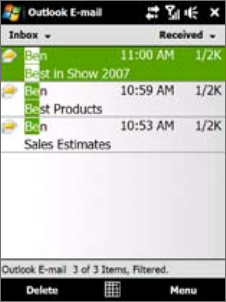
Exchanging Messages 65
3. Tap Send.
Tips • For more information about entering text and symbols, see Chapter 4.
• To set the message priority, tap Menu > Message Options.
• If you are working offline, e-mail messages are moved to the Outbox folder and will be sent the next time you
connect.
To add an attachment to a message
1. In the message that you are composing, tap Menu > Insert and tap the item you want to attach:
Picture, Voice Note, or File.
2. Select the file or picture you want to attach, or record a voice note.
Filter the Inbox message list
When the Inbox on your device is full of messages, you can filter your Inbox to display only the messages that
contain a particular sender or subject you are searching for.
To filter your Inbox
Enter the sender name or e-mail subject you want to look for. As you type characters, the message list narrows
down to the sequence of characters you have entered.
For example, entering “B”, then “E” narrows the list to only the e-mails that contain sender names and e-mail
subjects that start with “BE.”
View and reply to messages
To download a complete e-mail
By default, each e-mail received in the inbox on your device contains only the first few kilobytes of the
message. When you open an e-mail, it displays only the headers and part of the message. You must download
the whole e-mail to view the complete content.
To download a complete e-mail message, open the e-mail and then do one of the following:
Finger-scroll to the end of the message, and tap Get entire message and any attachments (POP3 e-
mail account) or tap Get the rest of this message (IMAP4 and Outlook e-mail accounts).
Tap Menu > Download Message.
Notes • The Fetch Mail feature, which is available for POP3 and IMAP4 Internet e-mail accounts, downloads an entire
e-mail without the need for you to perform a full synchronization. This limits the download to just the e-mail
message that you want and helps save data cost. Fetch Mail is also available for Outlook E-mail. See “Instant
download through Fetch Mail” in Chapter 7 for details.
• Download may take some time, depending on the speed of your Internet connection, size of the whole
e-mail, and whether file attachments are automatically downloaded.
•
•
66 Exchanging Messages
To download file attachments
POP3 e-mail account: File attachments of a POP3 Internet e-mail account are automatically
downloaded when you download a complete e-mail.
IMAP4 and Outlook e-mail accounts: File attachments appear below the subject of an e-mail
message. Tapping an attachment opens the attachment if it has been fully downloaded or marks it for
download the next time you send and receive e-mail.
You can set automatic download of file attachments. See “Customize e-mail settings” in this chapter for
details.
To reply to or forward a message
1. Open the message and tap Menu > Reply, Menu > Reply All, or Menu > Forward.
2. Enter your response, then tap Send.
Notes • You can receive and view HTML e-mails from any type of e-mail account. The HTML format is retained, without
layout shifting or resizing. HTML e-mail support in Outlook Mobile is available only if you are synchronizing your
device with Microsoft Exchange Server 2007.
• When replying using an Outlook e-mail account, you can customize ActiveSync to exclude addresses, including
your own, from being added to the recipient list. Tap Menu > Options in ActiveSync, select the E-mail item, tap
Settings, then tap Advanced. In the My e-mail addresses text box, enter e-mail addresses you want to exclude.
Synchronize e-mails
Synchronizing e-mails ensures that new e-mails are downloaded to the device Inbox folder, e-mails in the
Outbox folder are sent, and e-mails deleted from the server are removed from your device. The manner in
which you synchronize e-mails depends on the type of e-mail account you have.
To automatically synchronize an Outlook e-mail account
1. Connect your device to your computer through USB or Bluetooth. Otherwise, connect through Wi-
Fi or a data connection if you are synchronizing Outlook e-mail with the Exchange Server. For more
information, see Chapter 7.
2. Synchronization automatically begins, and your device sends and receives Outlook e-mail.
To manually synchronize your Outlook or Internet e-mail account
1. Select your Internet e-mail account. (See “To select a messaging account” in this chapter.)
2. Tap Menu > Send/Receive.
Customize e-mail settings
To change the download size and format for Outlook e-mail
1. Disconnect your device from the computer.
2. Tap Start > Programs > ActiveSync.
3. Tap Menu > Options, select E-mail, then tap Settings.
4. On the E-mail Sync Options screen:
Under Message format, select HTML or Plain text.
Under Download size limit, select the desired e-mail size.
5. Close ActiveSync and reconnect your device to the computer.
To change the download size and format for Internet e-mail
1. Tap Menu > Options on the Account Picker screen, or tap Menu > Tools > Options while you’re in a
message list.
2. Tap your POP3 or IMAP4 Internet e-mail account.
3. Tap Download Size Settings.
Under Message format, select HTML or Plain text.
Under Download size limit, select the desired e-mail size.
4. Tap Done.
•
•
•
•
•
•

Exchanging Messages 67
To automatically receive attachments on Outlook e-mails
1. Tap Start > Programs > ActiveSync.
2. Tap Menu > Options.
3. Tap E-mail > Settings, then select Include file attachments.
To automatically receive attachments on IMAP4 e-mails
1. Tap Menu > Options on the Account Picker screen, or tap Menu > Tools > Options while you’re in a
message list.
2. Tap the name of your IMAP4 e-mail account.
3. Tap Download Size Settings.
4. In Download attachments, select a download size or select All attachments.
5. Tap Done.
To store attachments on the internal storage
1. Tap Start > Messaging.
2. Tap Menu > Options > Storage tab.
3. Select the When available, use this storage card to store attachments check box.
68 Exchanging Messages

Chapter 7
Working With Company E-mails
and Meeting Appointments
7.1 Synchronizing with the Exchange Server
7.2 Working With Company E-mails
7.3 Managing Meeting Requests
7.4 Finding Contacts in the Company Directory
70 Working With Company E-mails and Meeting Appointments
7.1 Synchronizing with the Exchange Server
To keep up-to-date with your company e-mails and meeting schedules while you’re out of the office, you can
connect your device to the Internet through Wi-Fi or a data connection and synchronize with your company’s
Exchange Server.
Set up an Exchange Server connection
Before you can synchronize or access information on the Exchange Server, you need to set up an Exchange
Server connection on your device. You need to get the following information from your network administrator
and enter them on your device:
Exchange Server name (must be Outlook Web Access server name)
Domain name
User name and password that you use at work
If you have not synchronized your device with your computer, follow these steps to set up an Exchange Server
connection.
1. Add a new e-mail account. See “Add an e-mail account” in Chapter 6 for instructions.
2. Enter the E-mail address and Password for the e-mail account and select the Save password option.
Tap Next.
3. Clear the Try to get e-mail settings automatically from the Internet option and tap Next.
4. In Your e-mail provider, select Exchange server and tap Next.
5. Tap Next again.
6. Select the Attempt to detect Exchange Server Settings automatically option and tap Next.
7. Enter the Domain name and tap Next.
8. In Server address, enter the Exchange Server address and tap Next.
9. Select the items that you want to sync with the Exchange Server.
Tips • To change synchronization settings of an information item, for example, E-mail, select the item, then
tap Settings.
• To change the rules for resolving synchronization conflicts, tap Menu > Advanced.
10. Tap Finish.
Notes • If you synchronized e-mails with your computer before, open ActiveSync on your device, then tap Menu >
Add Server Source to set up an Exchange Server connection. When prompted to select information types for
synchronization, you must first clear the E-mail check box under the Windows PC item before you can select E-
mail under Exchange Server.
• To change Exchange Server settings, open ActiveSync on your device, then tap Menu > Configure Server.
Start synchronization
Before you start synchronizing with the Exchange Server, make sure your device has been set up with a Wi-
Fi or data connection to the Internet so that you can synchronize over the air. For more information about
connections, see Chapter 8.
After you finish setting up an Exchange Server connection, your device automatically starts synchronization.
To manually start synchronization, you can do one of the following:
On the TouchFLO 3D Home screen, slide to the Settings tab and then touch Sync Data; or
Tap Start > Programs > ActiveSync and then tap Sync.
Note If you connect your device to your office computer via a USB or Bluetooth connection, you can use this connection
to the computer to “pass through” to the network and download Outlook e-mails and other information to your
device.
•
•
•
•
•
Working With Company E-mails and Meeting Appointments 71
7.2 Working With Company E-mails
Your device gives you instant access to your company e-mails and lets you manage your messages easier.
Direct Push, Fetch Mail, Remote e-mail search, and e-mail flags are just some of the tools you can use to
manage your e-mails.
Note Some messaging features depend on the Microsoft Exchange Server version used in your company. Check with
your network administrator for the availability of these features.
Automatic synchronization through Direct Push
Direct Push technology (push e-mail feature) enables you to receive new e-mails on your device as soon as they
arrive in your Inbox on the Exchange Server. Items such as contacts, calendar and tasks are also immediately
updated onto your device when these items have been changed or new entries have been added on the
Exchange Server. To make Direct Push work, you need to have a Wi-Fi or data connection on your device.
You need to perform a full synchronization between your device and the Exchange Server first before Direct
Push can be enabled.
Requirement The Direct Push feature works for your device only if your company is using Microsoft Exchange
Server 2003 Service Pack 2 (SP2) with Exchange ActiveSync or higher version.
You can turn on Direct Push in the Comm Manager or ActiveSync.
To turn on Direct Push in Comm Manager
1. To open the Comm Manager, slide to the Settings tab on the TouchFLO 3D Home screen and then
touch Communications.
2. On the Comm Manager screen, touch Microsoft Direct Push.
To turn on Direct Push in ActiveSync
1. Tap Start > Programs > ActiveSync and then tap Menu > Schedule.
2. Select As items arrive in the Peak times and Off-peak times boxes.
Note When Direct Push is off, you need to manually retrieve your e-mails.
Scheduled synchronization
If you do not want to use Direct Push, you can set a regular schedule for synchronizing Outlook e-mail and
information.
1. In ActiveSync on your device, tap Menu > Schedule.
2. Select a shorter time interval in the Peak times box for you to be able to receive e-mails more
frequently. (Peak times usually refer to your working hours when e-mail volume is high).
3. Select a longer interval in the Off-peak times box.
Tip To set the days and hours that make up your peak and off-peak times, tap the peak times link at the bottom of the
screen.
Instant download through Fetch Mail
The Fetch Mail feature downloads an entire e-mail immediately without the need for you to perform a full
Send/Receive action. This limits the download to just the e-mail message that you want and helps save data
cost.
Requirement Fetch Mail works for your device only if your company is using Microsoft Exchange Server 2007 or
higher.
1. On the TouchFLO 3D Home screen, slide to the Mail tab, select your Outlook account, and then tap
Inbox.
2. Open an e-mail message.
3. By default, only the first few words of the message is shown. To download the whole e-mail, finger-
scroll to the end of the message, then tap Get the rest of this message.
4. Wait for the remainder of the message body to download.
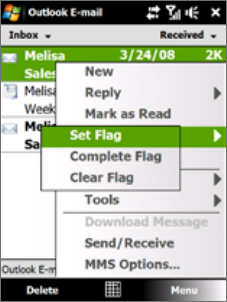
72 Working With Company E-mails and Meeting Appointments
Notes • For information about changing e-mail sync options such as setting the download size for e-mail, see "Customize
e-mail settings" in Chapter 6.
• When you receive an e-mail that contains a link to a document such as a PDF or Microsoft Office document
located on SharePoint or an internal file server, you can tap the link to view the document on your device. You
can view the document only if you have a Microsoft Outlook account that synchronizes with Microsoft Exchange
Server 2007 or later. Exchange Server must also be set up to allow access to SharePoint document libraries or
internal file servers.
Search for e-mails on the Exchange Server
You can access e-mails that are not available on your device by searching your Microsoft Exchange Server
mailbox. The search results are downloaded and displayed in a Search Results folder.
Requirement Your company must be using Microsoft Exchange Server 2007 or higher.
1. Tap Start > Messaging > Outlook E-mail.
2. Tap Menu > Tools > Search Server.
3. In the Look for text box, enter the search keyword.
4. Choose the date range of messages to search from.
5. In the Look in list, specify whether to search in the Inbox, Sent Items, or All Folders.
6. Tap Search.
Tip To clear the search results and return to the message list, tap Menu > Clear Results.
Flag your messages
Flags serve as a reminder for you to follow-up on important issues or requests contained in e-mail messages.
Flagging messages, which has been a useful feature on desktop Outlook E-mail, can also be done in Outlook
Mobile on your device. You can flag received e-mail messages on your device.
Requirement Flags are enabled only if e-mails are synchronized with Microsoft Exchange Server 2007 or higher.
Flags are disabled or hidden if e-mails are synchronized with earlier versions of Microsoft Exchange
Server.
To flag or unflag a message
1. Open Outlook on your device and access the Inbox.
2. Select a message or open a message.
3. Tap Menu > Follow Up and select one of the following options:
Set Flag Mark the message with a red flag to indicate that it needs follow up.
Complete Flag Mark the message with a check mark to indicate that the issue or request in the
e-mail is already completed.
Clear Flag Remove the flag to unmark the message.
Note E-mail message reminders are displayed on your device if the messages are flagged with reminders and
synchronized from the Exchange Server.
•
•
•
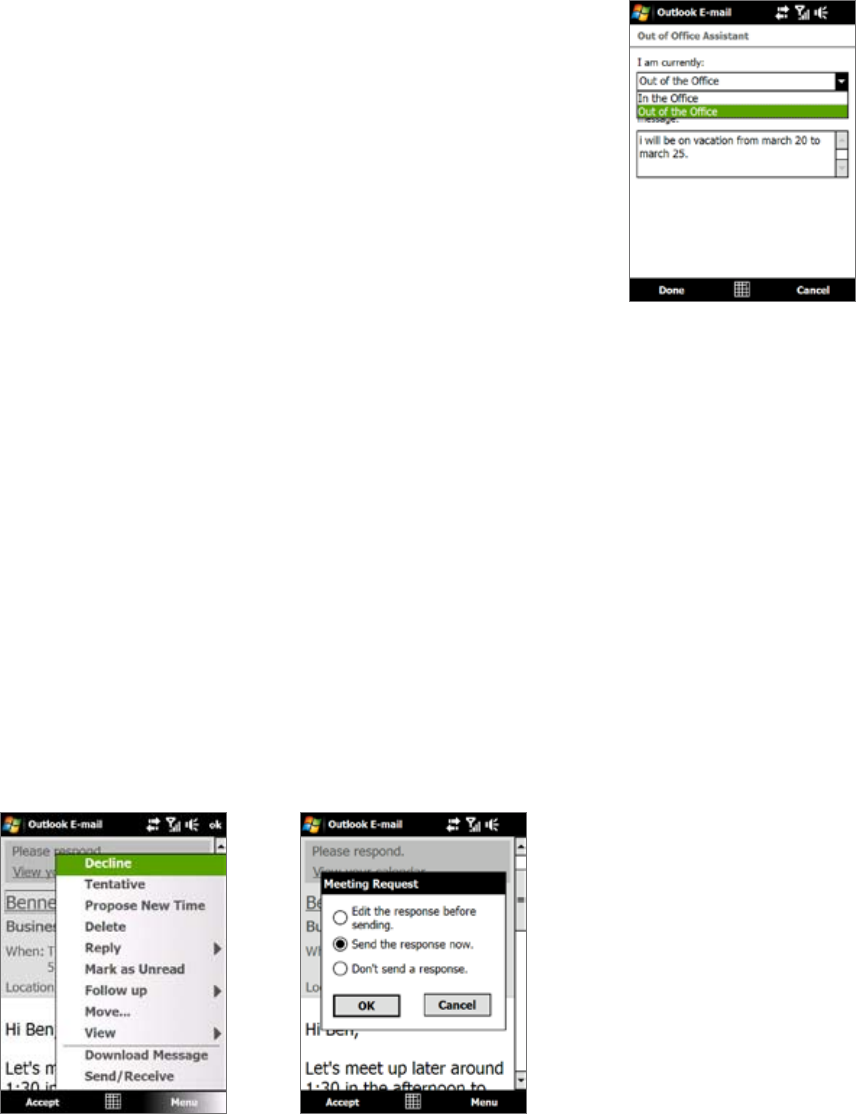
Working With Company E-mails and Meeting Appointments 73
Out-of-office auto-reply
Outlook Mobile allows you to retrieve and change your out-of-office status.
Just like desktop Outlook E-mail, Outlook Mobile automatically sends an
auto-reply message when you’re not available.
To send out-of-office auto-reply messages
1. Tap Start > Messaging > Outlook E-mail.
2. Tap Menu > Tools > Out of Office.
3. In the I am currently list, select Out of the Office.
4. Enter your auto-reply message, then tap Done.
7.3 Managing Meeting Requests
When you schedule and send meeting requests from your device, you can invite attendees to your meeting
and check their status to know about their availability.
When you receive a meeting request, you can reply by accepting or declining the request. The meeting
request also clearly indicates whether or not there are conflicting or adjacent meetings.
Requirement Your company must be using Microsoft Exchange Server 2007 or higher.
To reply to a meeting request
1. When you receive a meeting request e-mail, a notification will be displayed on your device. Open the
e-mail.
2. Tap Accept to reply and accept the meeting request, or tap Menu > Decline if you cannot attend the
meeting.
Tips • Before responding, you can check your availability during the time of the requested meeting by
tapping View your calendar.
• If the time of the meeting conflicts with your other appointments, a “Scheduling Conflict” status
appears on top of the e-mail.
3. Choose whether or not to edit your response e-mail before sending, then tap OK.
If you accepted the meeting request, it will automatically be added as an appointment in Calendar on your
device.
To view the list of meeting participants
1. Tap Start > Calendar.
2. Tap a meeting request that you sent and then tap Attendees. The required and optional attendees will
be listed.
Icons indicating whether each attendee has accepted or declined the meeting request will also be displayed.
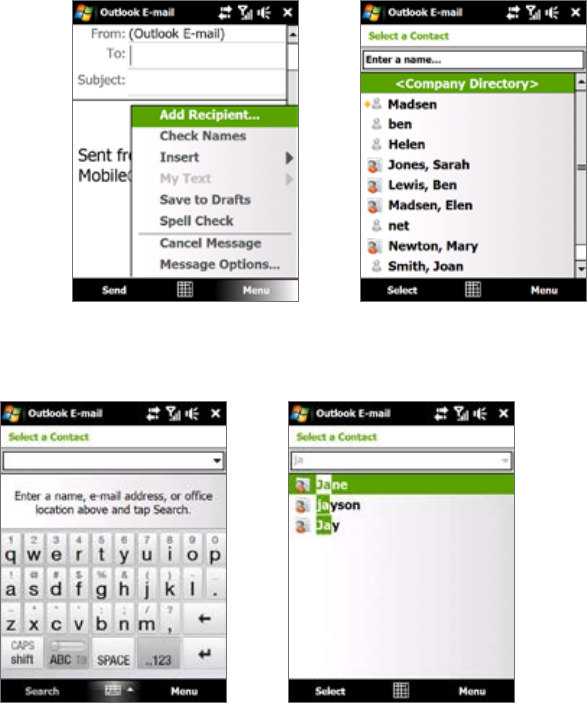
74 Working With Company E-mails and Meeting Appointments
Note To see the icon indicators in the attendees list, make sure Calendar is synchronized with the Exchange Server.
Tips • For information about creating a meeting request, see “To send a meeting request” in Chapter 12.
• To view an attendee’s contact information, tap the attendee’s name. If the attendee is included in your contacts
list, you will see the contact information immediately. If the attendee is not in your contacts list, tap Company
Directory to view the contact information.
7.4 Finding Contacts in the Company Directory
In addition to having contacts on your device, you can access contact information from your organization’s
Company Directory. By having over-the-air access to the Company Directory, you can easily send e-mail
messages and meeting requests to anyone in your company.
Requirement Access to the Company Directory is available only if your organization is running Microsoft Exchange
Server 2003 SP2 or higher, and you have completed your first synchronization with the Exchange
Server.
1. Synchronize with the Exchange Server.
2. Do any of the following:
In Contacts, tap Menu > Company Directory.
In a new e-mail message, tap the To box (or tap Menu > Add Recipient), then tap Company
Directory on the top of the list.
When creating a meeting request and selecting required and optional attendees in Calendar, tap
Company Directory.
2. Enter a partial or full contact name and tap Search. In the search results list, tap a contact to select it.
Note • You can save a contact from the Company Directory to your device by selecting the contact, then tapping Menu
> Save to Contacts.
• You can search on the following information as long as that information is included in the Company Directory:
First name, Last name, E-mail name, Display name, E-mail address, or Office location.
•
•
•

Chapter 8
Internet
8.1 Ways of Connecting to the Internet
8.2 Starting a Data Connection
8.3 Using Opera Mobile™
8.4 Using YouTube™
8.5 Using Windows Live™
8.6 Using Your Device As a Modem
(Wireless Modem)
8.7 Using RSS Hub
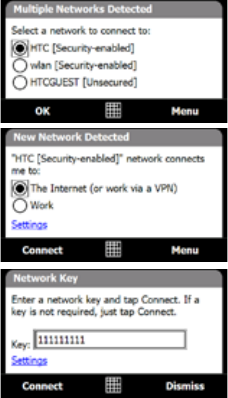
76 Internet
8.1 Ways of Connecting to the Internet
Your device’s networking capabilities allow you to access the Internet or your corporate network at work
through one of the following connections:
Wi-Fi
Dial-up
Note You can also add and set up the following connections:
• VPN: A VPN connection is used to access your corporate network by using an existing Internet connection.
• Proxy: A Proxy connection is used to access the Internet using an existing connection to your corporate or WAP
network.
Wi-Fi
Wi-Fi provides wireless Internet access over distances of up to 300 feet (100 meters).
To use Wi-Fi on your device, you need access to a wireless access point or “hotspot”.
Note The availability and range of your device’s Wi-Fi signal depends on the number, infrastructure, and other objects
through which the signal passes:
To turn Wi-Fi on and off
1. On the Home screen, slide to the Settings tab.
2. On the Settings screen, tap Communications > Wi-Fi to enable/disable the wireless function.
When enabled, the On indicator is activated and available wireless networks will be detected.
To connect to a wireless network
After Wi-Fi is turned on, your device scans for available wireless networks in your area.
1. The network names of the detected wireless networks are displayed on a
pop-up message window. Tap the desired wireless network, then tap OK.
Note When you select an open (unsecured) network, you will be
automatically connected to the network after tapping OK.
You do not need to do steps 2 and 3.
2. On the next pop-up message window, do one of the following:
Tap The Internet if the wireless network connects your device to the
Internet.
Tap Work if the wireless network connects your device to a private
network.
3. Enter the key and then tap Connect.
•
•
Next time you use your device to detect wireless networks, you will not see the pop-up message windows
again, and you will not be prompted to enter the network key of the previously accessed wireless network
(unless you perform a hard reset which will erase custom settings on your device).
Note Wi-Fi networks are self-discoverable, which means no additional steps are required for your device to connect to a
Wi-Fi network. It may be necessary to provide a username and password for certain closed wireless networks.
•
•
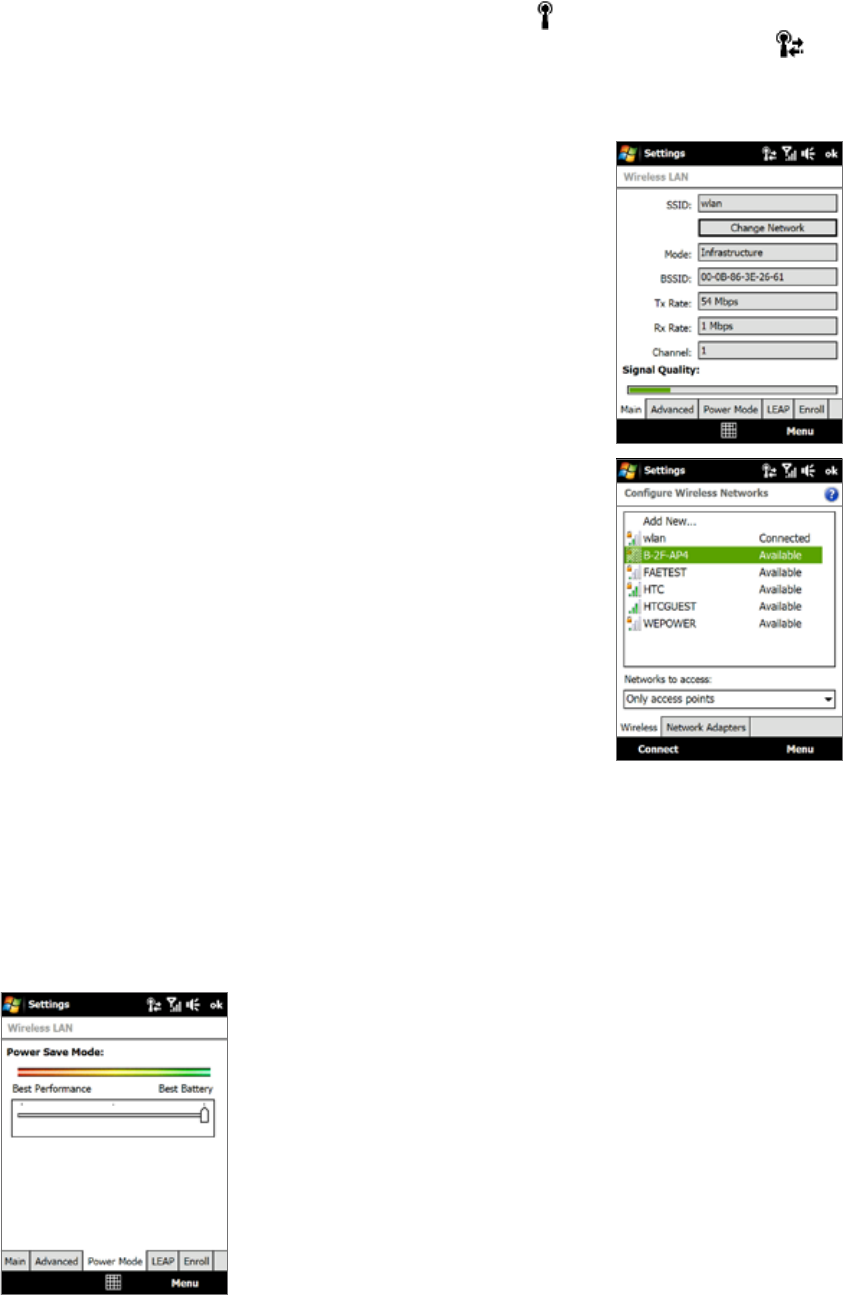
Internet 77
To check wireless network status
You can check the current wireless connection status from any of the following screens of your device:
Title bar. When you enable Wi-Fi on your device, the Wi-Fi ON icon appears on the title bar. After
Wi-Fi is turned on, your device scans for available wireless networks and the wireless signal icon
appears on the title bar. The arrows in this icon move back and forth while your device is scanning for a
wireless network signal. Once your device successfully connects to a wireless network, the arrows stop
moving.
Wireless LAN screen. On the Home screen, slide to the Settings tab
and then tap Menu > Wireless Networks. On the Main tab, you will
see the wireless network that your device is currently connected to.
The configuration and signal quality of the wireless network are also
shown.
•
Configure Wireless Networks screen. On the Home screen, slide
to the Settings tab and then tap All Settings. In the Connections
tab, tap Wi-Fi. This screen displays the wireless networks currently
available. To connect to a wireless network in the list, tap and hold on
the desired network, then tap Connect. Tap a wireless network in the
list to view or change its connection settings. You can also add new
wireless networks, if available, by tapping Add New.
•
To save battery power while connected to a wireless network
Using Wi-Fi quickly consumes battery power. Turn off Wi-Fi when not in use. You can also enable power saving
settings.
1. On the Home screen, slide to the Settings tab.
2. On the Settings screen, tap Menu > Wireless Networks > Power Mode tab.
3. On the Power Mode tab, move the Power Save Mode slider to a position that optimizes performance
with the least power consumption.
For example, move the slider to the left (Best Performance) to
have the optimal wireless network performance; move to the
right (Best Battery) to obtain the maximum battery usage.
•
78 Internet
8.2 Starting a Data Connection
After setting up a data connection on your device, you can now connect your device to the Internet. The
connection is started automatically when you begin using a program that accesses the Internet such as Opera
Mobile.
To manually start a data connection
If you have set up multiple types of data connections on your device, you can manually start a connection.
1. On the Home screen, slide to the Settings tab and then tap All Settings.
2. On the Connections tab, tap Connections.
3. Tap Manage existing connections.
4. Tap and hold the name of the desired connection, then tap Connect.
To disconnect active data connections
1. Tap Start > Settings > Connections tab > Comm Manager.
2. Tap the Data Connection button.
Note You cannot reconnect a data connection in Comm Manager.
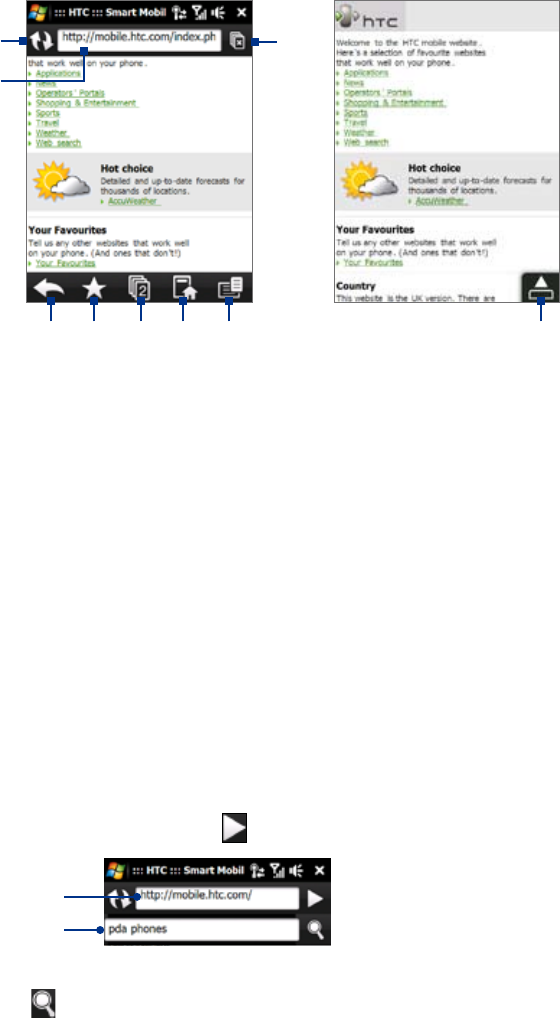
Internet 79
8.3 Using Opera Mobile™
Opera Mobile™ is a full-featured Internet browser, optimized for use on your device.
Note You can also use Internet Explorer® Mobile to browse the Web. To open Internet Explorer Mobile, tap Start >
Internet Explorer.
1
2
3 4 5 6 7
8
9
1Refresh. Tap to reload the Web page being viewed.
2Address bar. Enter the URL of the Web site here.
3Back. Tap to go back to the previous Web page viewed.
4Favorites. Tap to go to the Favorites screen where you can add a favorite, edit favorite Web pages, and
send the favorite URL link via one of the Messaging accounts.
5Tabs. Tap to add a new browsing tab or switch to another existing browsing tab.
6Home. Tap to go to the Home page.
7Menu. Tap to open a list where you can change Opera Mobile settings, check downloads, view History,
and more.
8Close tab. Tap to close the current tab. This is only enabled if you have more than one tab opened.
9Exit Full Screen mode. When browsing the Web, Opera Mobile automatically switches to Full screen
mode. Tap to show the address and Menu bars again.
To open Opera Mobile
On the Home screen, slide to the Internet tab and then tap Browser.
To go to a Web site
1. On the Opera Mobile screen, tap the address bar.
2. Enter the URL address and tap .
Search field
Address bar
Tip When you tap the address bar, a search field also appears. Quickly search the Web by entering the search item and
tapping .
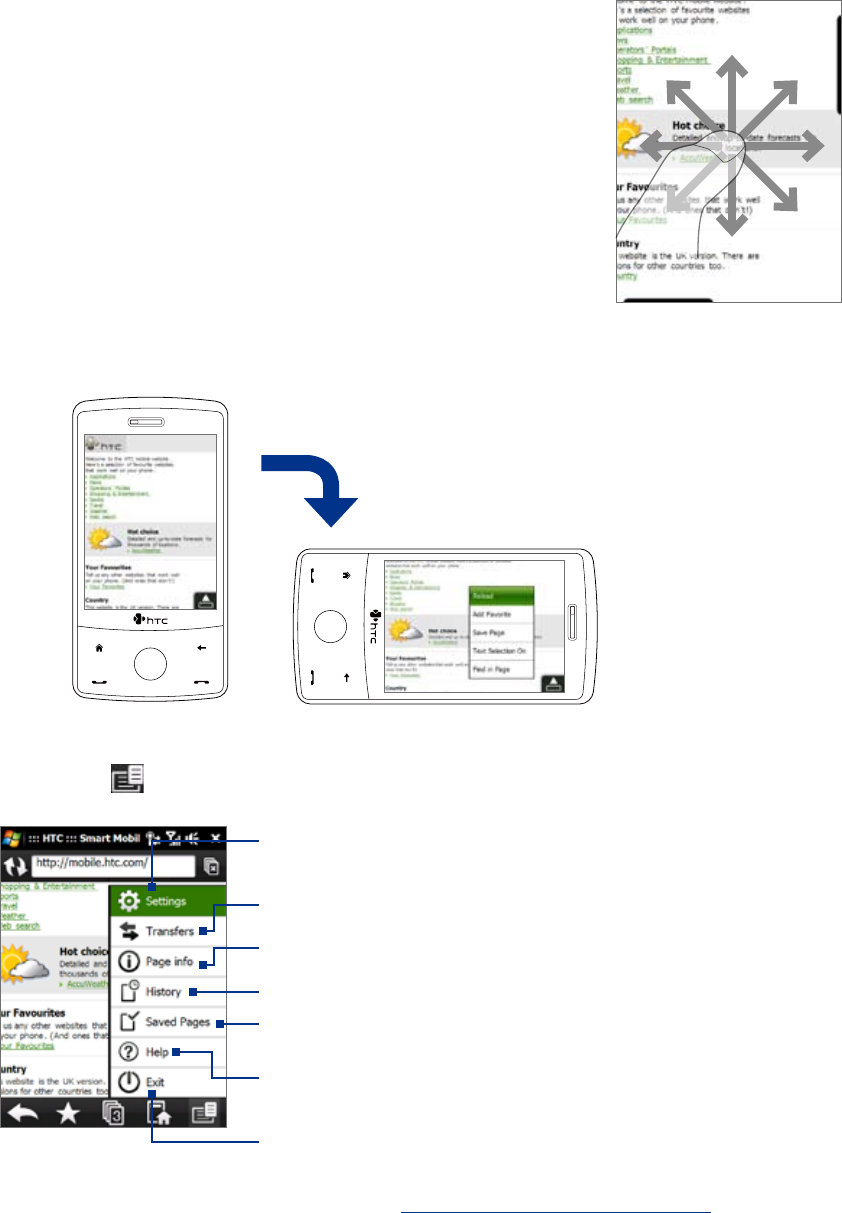
80 Internet
View Web pages
While browsing Web pages, use finger gestures to pan and zoom on the Web
page. To zoom in, tap your finger twice on the screen. To zoom out, tap your
finger twice on the screen again.
Tip Touch and hold an empty area on a Web page to open a shortcut menu that
lets you go back to the previous page, reload the page, add the page as a
Favorite, and more. You can also tap and hold a link or image on a Web page to
open a menu with different options.
To change the screen orientation
Change the screen orientation by simply turning your device sideways.
Opera Mobile menu
On the menu bar, tap to open the menu.
Tap to open the Settings screen where you
can set the default home page, change display
settings, set privacy settings, and more.
Tap to view items being downloaded. You can
also resume or stop current downloads.
Tap to view information about the Web page
you are browsing.
Tap to see web pages that you have viewed.
Tap to open the Opera Mobile help file.
Tap to close Opera Mobile completely.
Opera Mobile will not run in the background.
Tap to manage and view web pages that
you have saved.
Note For more information about using Opera Mobile, go to: http://www.opera.com/products/mobile/
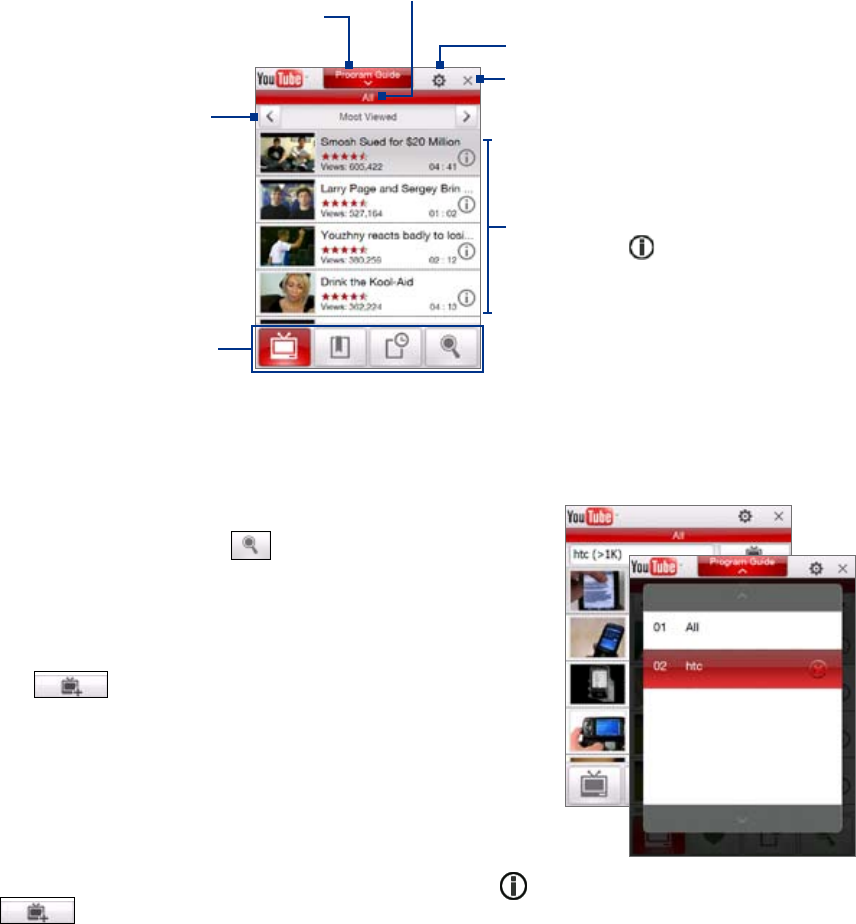
Internet 81
8.4 Using YouTube™
YouTube™ lets you browse, search, and watch video clips from the YouTube server.
Note You need an active connection to use YouTube. If you are using a data connection, your data connection bill may
increase significantly due to large file sizes of the videos.
To open YouTube
Tap Start > Programs > YouTube.
Tap to open the Program Guide list.
The Program Guide list only appears
if you are subscribed to a channel.
Displays the current program
channel being viewed.
Tap to close the YouTube.
Tap the arrows to filter the
list by Most Viewed, Top
Rated, and Featured.
Displays the available videos for the
selected program channel. Tap a video
to watch it. Tap to view details
about the video.
Tap to switch between the
different YouTube screens.
Tap to set video playback quality.
Browse for videos
The Program Guide list lets you change the program channel so you can browse different types of videos
available on the YouTube server. By default, there is only one channel in the Program Guide.
To add a new program channel into the Program Guide list
1. On the YouTube screen, tap .
2. On the Search screen, enter the channel you want to add to
the Program Guide list.
3. Tap Search. YouTube searches for the channel and then
displays the available videos from it.
4. Tap and then on the confirmation screen, tap OK.
The channel you just subscribed to will now be shown when
you tap Program Guide.
Tip You can also add a YouTube user as a program channel. To add, tap in any of the YouTube screens and then tap
.
To change the program channel
1. On the Videos screen, tap Program Guide at the top of the screen.
2. On the Program Guide list, select a channel.
3. The video list refreshes to display the available videos for the newly selected channel.
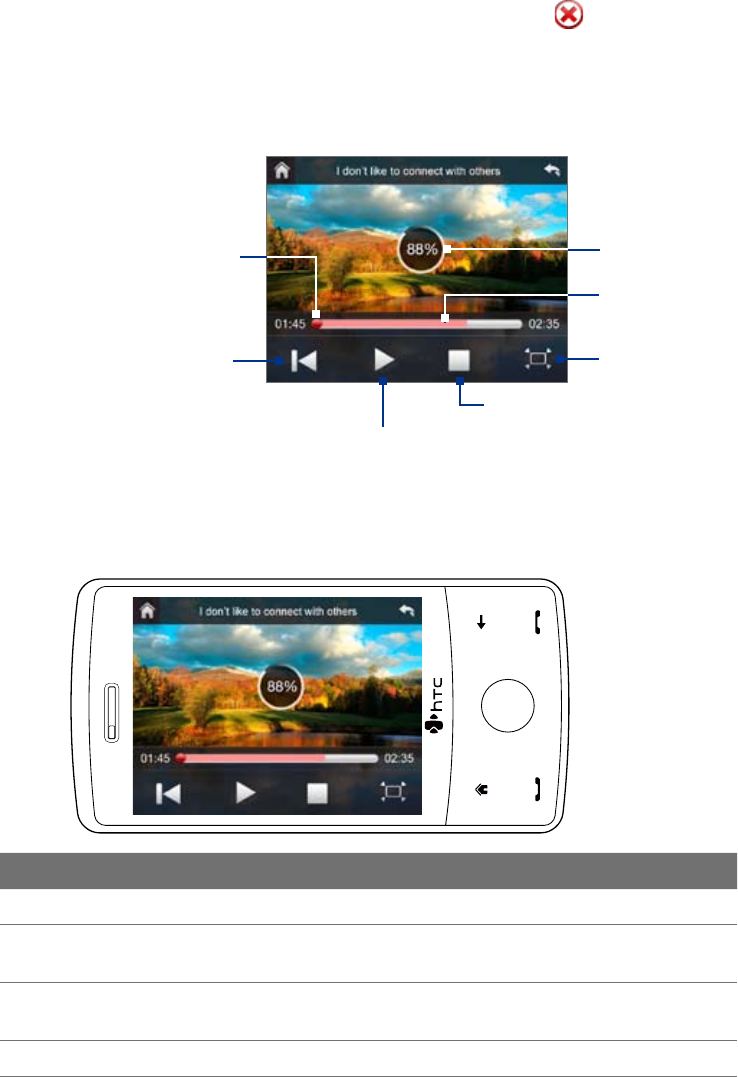
82 Internet
To delete a program channel from the Program Guide list
You can only delete program channels that you have added to the Program Guide list.
1. On the Videos screen, tap Program Guide.
2. Scroll down to the channel you want to delete and then tap .
3. On the confirmation screen, tap Yes.
Watching videos
In the Videos, Bookmarks, or History screen, tap a video to launch the YouTube Video Player.
Tap to go back to the
beginning of the video. .
Tap to toggle between playing
and pausing the video.
Tap to stop the video playback.
Tap to resize the video to fit the screen.
Tap again to go back to actual size.
Drag to go forward or
backward in the video.
Buffered video
Download progress
Tip To adjust the volume, press the VOLUME CONTROLS on the side of the device.
Navigation Control
This control Does this
ENTER Toggle between playing and pausing video playback.
Navigation Right
(Landscape orientation) Press and hold to go forward in the video.
Navigation Left
(Landscape orientation) Press and hold to go back in the video
VOLUME BUTTONS Press to adjust the volume.
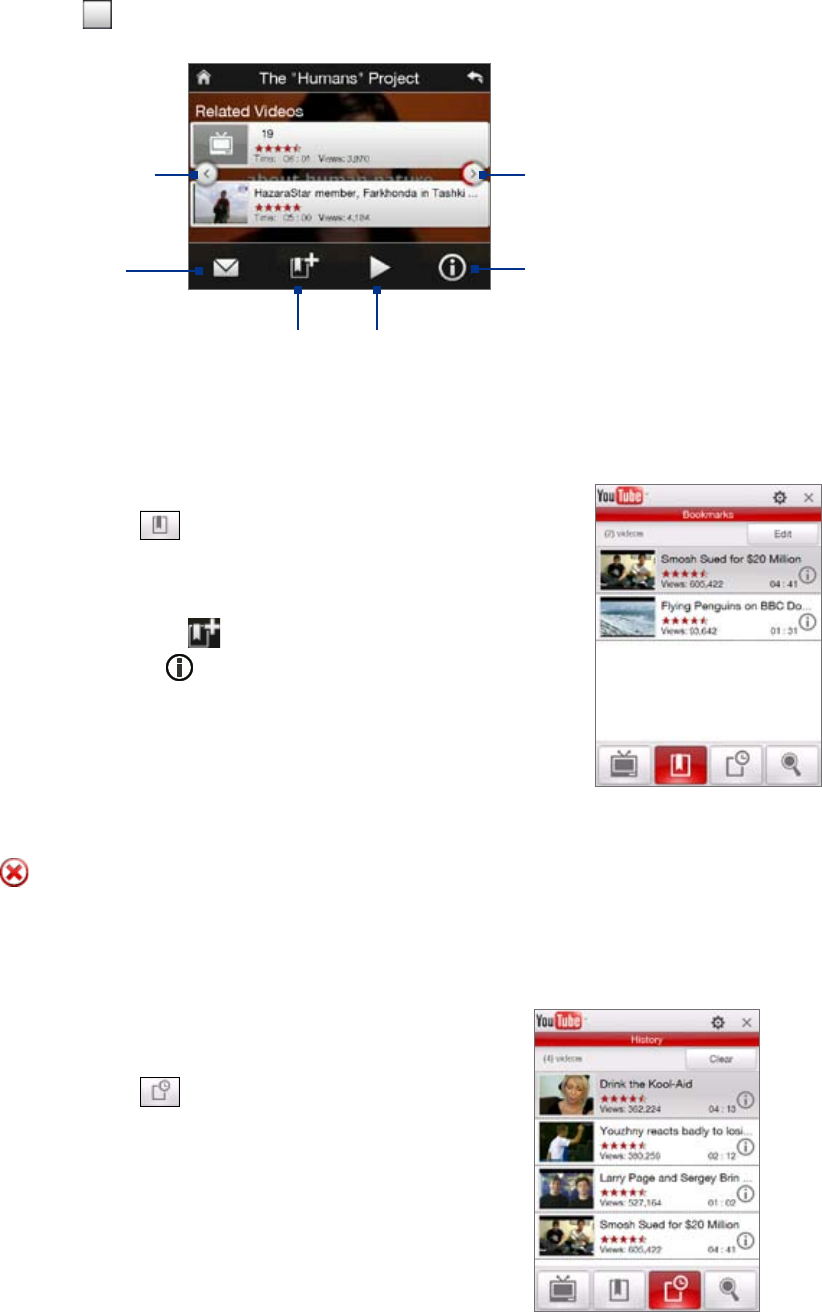
Internet 83
When you tap Stop ( ) or finish watching the entire video, you are presented with options on what you can
do next.
Tap to send the link to the
video you just watched to
another person using one of
the Messaging accounts.
Tap to add the video
to your Bookmarks.
Tap to play back
the video again.
Tap to view details about the
video you just watched.
Tap to go to the next page of
related videos. If no action is taken,
it automatically goes to the next
page after 10 seconds.
Tap to go back to the previous
page of related videos.
Bookmarks
You can store frequently viewed videos into Bookmarks for quick access.
To view Bookmarks
On the YouTube screen, tap . Tap a video to watch it.
To add a video into Bookmarks.
Do one of the following:
After watching a video, tap .
On the list of videos, tap on the video you want to add to Bookmarks
and then tap Bookmark.
•
•
To delete a video from Bookmarks
1. On the Bookmarks screen, tap Edit.
2. Tap on the video you want to remove from Bookmarks.
3. On the confirmation screen, tap Yes.
4. Tap Done.
History
View recently watched videos on the History screen.
To view History
On the YouTube screen, tap . Tap a video to watch it.
Note To clear the History list, tap Clear.
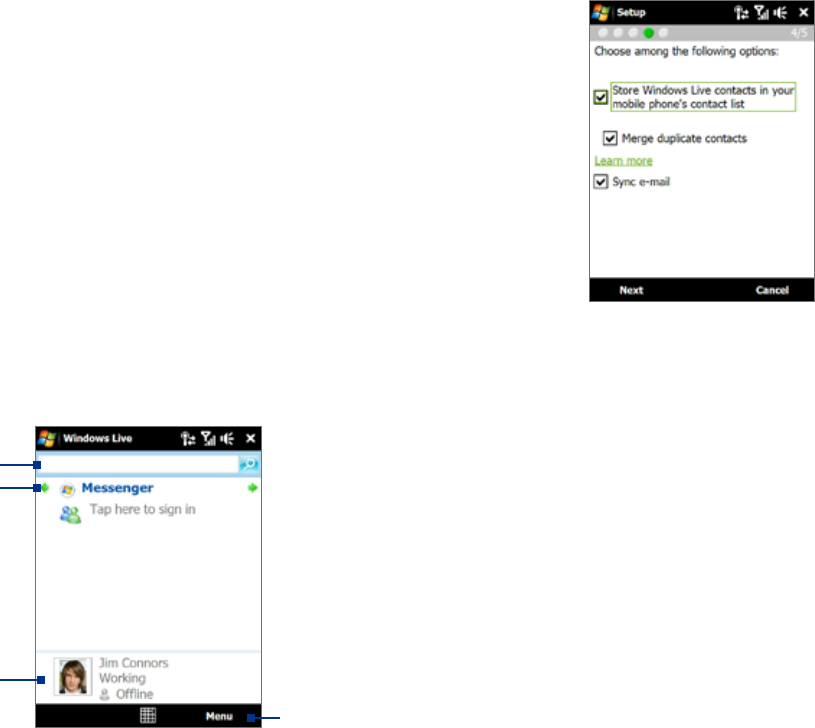
84 Internet
8.5 Using Windows Live™
Windows Live™ gives you a full Internet experience on your device. Windows Live™ helps you to find
information, pursue your interests, and get in touch with friends and family on the Internet easier.
Windows Live™ offers the following key features:
Live Search Bar, which lets you search for information on the Web.
Live Messenger, the next generation of MSN Messenger Mobile.
Live Mail, the next generation of Hotmail.
Live Contacts, your address book for storing Live Mail, Live Messenger and Hotmail contacts.
Set up Windows Live™
The first time you use Windows Live™, sign in using your Windows Live™ ID, which is your Windows Live™ Mail
or Hotmail address, and password.
To set up Windows Live™ for the first time
1. Tap Start > Programs > Windows Live and then tap Sign in to Windows Live.
2. Tap the links to read the Windows Live™ Term of Use and the Microsoft Privacy Statement. After
reviewing them, tap Accept.
3. Enter your Windows Live™ Mail or Hotmail address and password, select the Save password checkbox,
then tap Next.
4. Tap Next.
5. Choose what information you want to sync online with your device.
If you select Store Windows Live contacts in your mobile phone’s
contact list, your Windows Live™ contacts will be added to the contact
list and to Windows Live™ Messenger on your device.
If you select Sync e-mail, your Windows Live™ Mail or Hotmail inbox
messages will be downloaded to your device.
6. Tap Next.
7. After synchronization is complete, tap Done.
The Windows Live™ interface
On the Windows Live™ main screen, you will see a search bar, navigation buttons, and an area where you can
show and customize your profile.
1Search bar
2Navigation buttons. Tap the left or right arrow
to switch between Windows Live™ Messenger,
Windows Live™ Mail, and Sync status.
3Tap to change the display name, picture, or
personal message.
4Tap Menu to access and change settings.
1
2
3
4
•
•
•
•
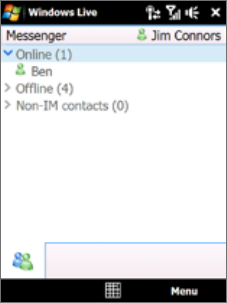
Internet 85
Windows Live™ Messenger
With this mobile version of Windows Live™ Messenger, you enjoy many of
the same cool features that you get from the desktop version, which include
the following:
Instant messaging via text and voice
Multiple conversations
Insert emoticons
Contact list with presence
Send and receive files including photos
Change status/display name
View contacts by online status, groups, and more
Send messages even when a contact is offline
•
•
•
•
•
•
•
•
Note Before you can use Windows Live™ Messenger, your device must be connected to the Internet. For information
about setting up an Internet connection, see “Ways of Connecting to the Internet” in this chapter.
Launch Messenger and sign in
To open Windows Live™ Messenger
Do one of the following:
Tap Start > Programs > Messenger.
On the Windows Live™ main screen, tap the left or right arrow until you see Messenger, then tap it.
To sign in and out
1. Tap Sign in on the Messenger screen.
2. If this is your first time to sign in, a message appears to inform you that your messenger contacts will
be added to the contact list on your device. Tap OK to add them. Signing in may take several minutes,
depending on your connection speed.
3. To sign out, tap Menu > Sign Out.
To start and end conversations
1. In the contact list, select a contact, then tap Send IM to open a message screen.
2. Enter your text message in the text entry area of the message screen.
3. To add an emoticon, tap Menu > Add emoticon then tap an icon from the list.
4. Tap Send.
5. To end a conversation with the current contact, tap Menu > End conversation.
Tips • To send a file, tap Menu > Send. You can choose to send a picture, voice clip or any file.
• To invite one or more contacts to the conversation, tap Menu > Options > Add participant.
• To send a voice message, tap Voice Clip on a message screen then start talking. After you have recorded a
message, tap Send.
Add Windows Live™ contacts
You can add new Windows Live™ contacts in Windows Live™ Messenger or in Contacts.
To add a Windows Live™ contact in Live Messenger
1. Tap Menu > Add new contact.
2. Enter the e-mail address of the contact, then tap OK.
To add a Windows Live™ contact in Contacts
1. On the Home screen, slide to the People tab and then tap All People.
2. Tap New, then tap Windows Live.
•
•
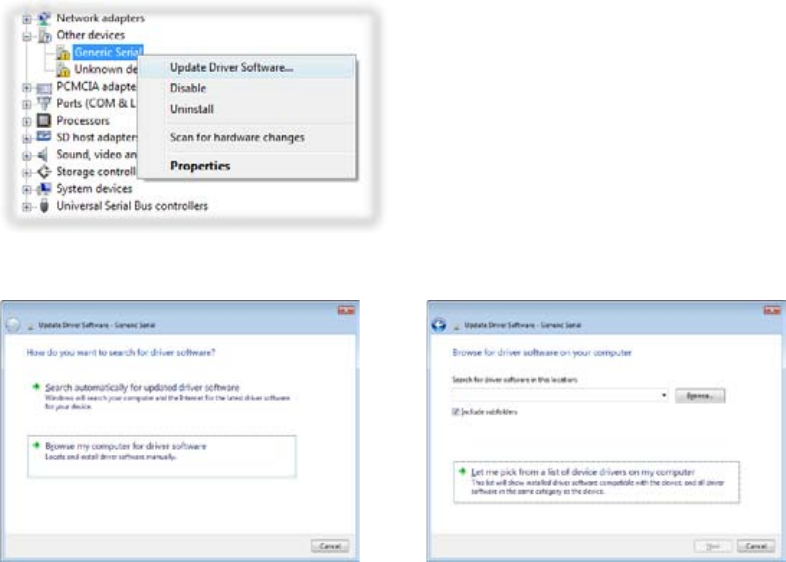
86 Internet
3. In the IM box, enter the e-mail address of the contact, which can be a Windows Live ID or any other
e-mail address.
Tip You can fill in other information about the contact, if desired. This is not necessary if you will
communicate with the contact only through Windows Live™ Messenger or Live Mail.
4. Tap OK.
5. Follow the remaining instructions to add the new contact to your Windows Live™ contact list.
8.6 Using Your Device As a Modem (Wireless Modem)
While traveling, you can use your Windows Mobile powered device as a modem for your notebook. Wireless
Modem allows you to use your device as a USB modem.
Note When you activate Wireless Modem, ActiveSync will be disabled automatically.
Activate your device as a modem
Connect your device to your notebook using the USB cable, then follow the steps below to activate your
device as a modem.
1. On your device, tap Start > Programs > WModem.
2. Tap Menu > Start.
3. The next thing to do is to add your device as a modem onto your notebook.
Add your device as a modem to your notebook
After you tap Menu > Start on the Wireless Modem screen of your device, your notebook will automatically
detect that your device has been connected. The Found New Hardware dialog box will then appear on your
computer.
To add your device as a modem to a Windows Vista notebook
1. Click Cancel to close the Found New Hardware dialog box.
2. Open the Control Panel, then click Device Manager.
3. Right-click Generic Serial, then click Update Driver Software.
4. Click Browse my computer for driver software, then click Let me pick from a list of device drivers
on my computer.
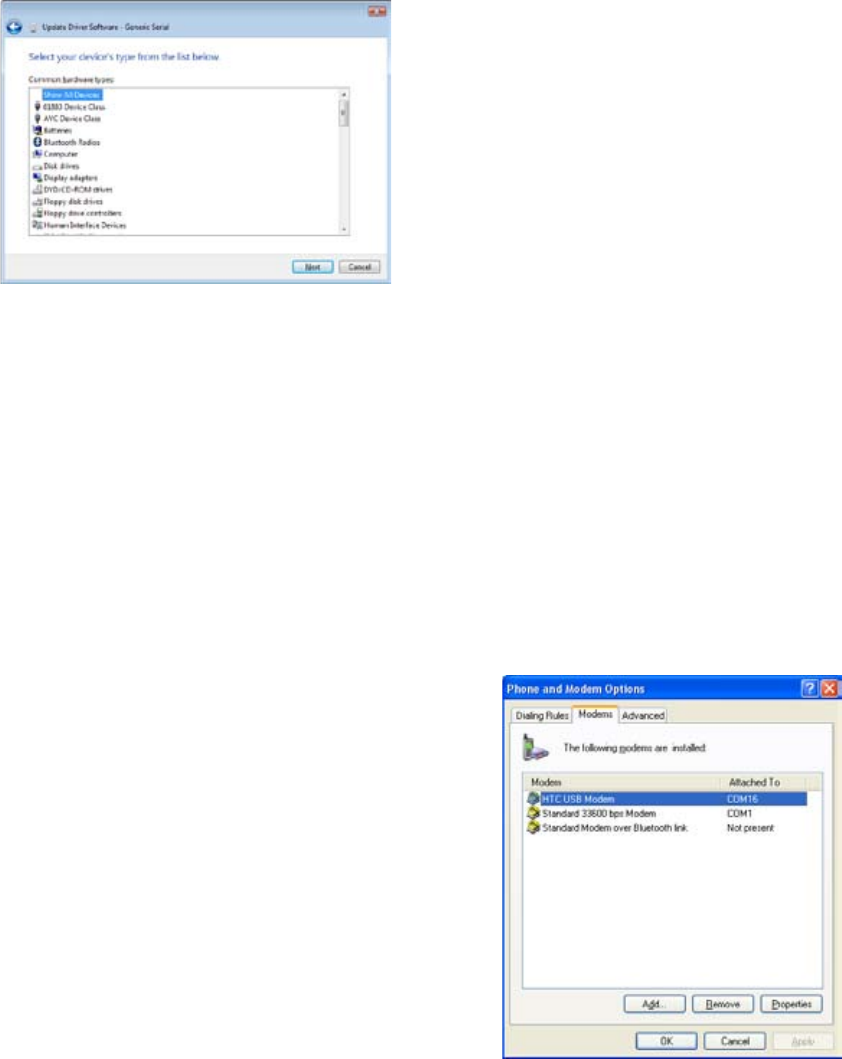
Internet 87
5. Click Show All Devices, then click Have Disk and browse the Getting Started Disc to locate the USB
modem driver for your device.
6. HTC USB Modem will then be displayed. Select this modem driver then click Next.
7. If you see the Update Driver Warning message, simply click Yes to continue with the installation.
8. In the Windows Security dialog box, click Install this driver software anyway to continue with the
installation.
9. Wait for the installation of the HTC USB Modem to complete, then tap Close.
To add your device as a modem to a Windows XP notebook
1. In the Found New Hardware dialog box, select Install from a list or specific location (Advanced) and
click Next.
2. Select Search for the best drivers in these locations.
3. Insert the Getting Started Disc into your CD drive. Select the Include this location in the search check
box. Click Browse and choose the CD drive and root folder where the modem driver is located, then
click Next.
4. Wait for the installation to complete, then click Finish.
5. Click Start > Settings > Control Panel.
6. Double-click Phone and Modem Options.
7. Click the Modems tab. Select the new modem from the
Modem list, then click OK.
8. You can now connect your computer to the Internet.
Follow the steps in “Dial up and connect to the Internet.”
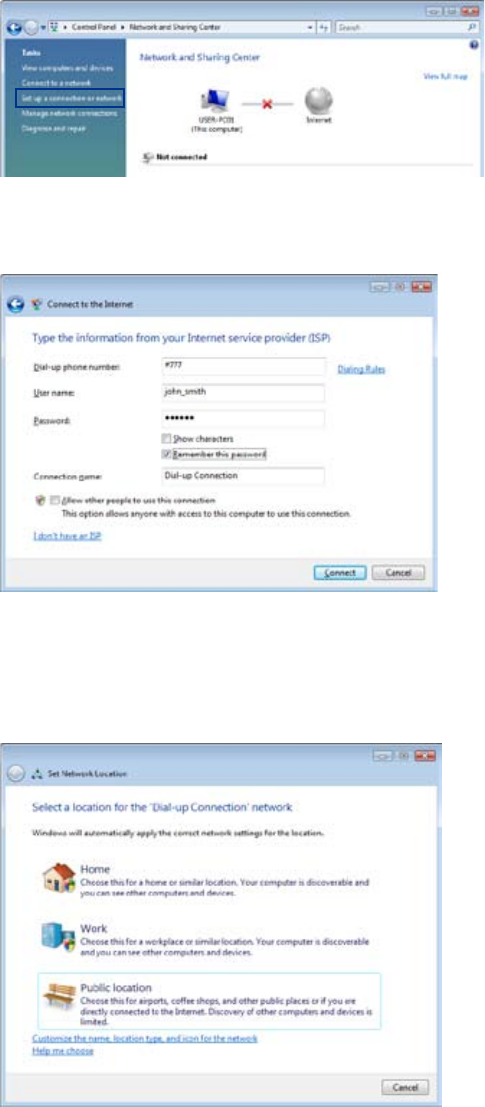
88 Internet
Create a modem dial-up connection
After your notebook recognizes your device as a modem, create a modem dial-up connection on your
notebook.
To set up a modem dial-up connection in a Windows Vista notebook
1. On your notebook, click Start > Control Panel.
2. Double-click Network and Sharing Center.
3. On the left-hand panel of the Network and Sharing Center, click Set up a connection or network.
4. Click Set up a dial-up connection then click Next.
5. Enter the following information: dial-up phone number (#777), your user name and password. Also
select the Remember this password check box.
6. When you have finished entering the information, click Connect. Your notebook then starts to dial up
to the Internet using your device as a modem.
7. When you see a dialog box that shows you are connected to the Internet, click Close.
8. In the Set Network Location dialog box, choose the type of location where you will use the dial-up
connection.
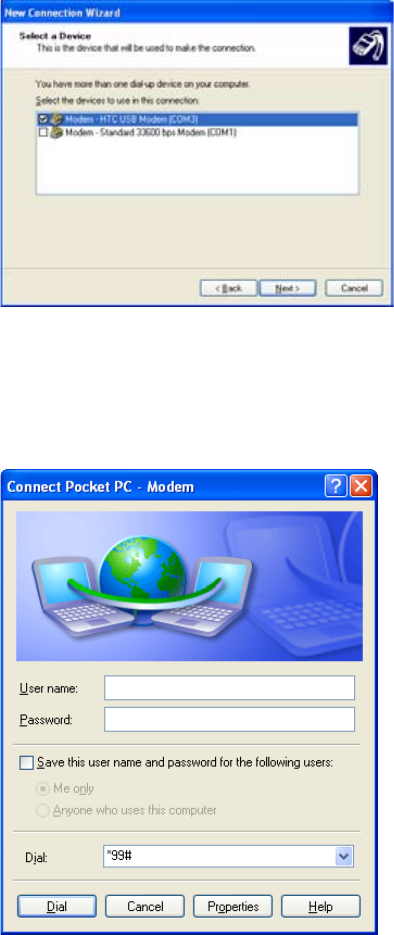
Internet 89
To set up a dial-up connection in a Windows XP notebook
1. On your computer, click Start > Settings > Control Panel.
2. Double-click Network Connections.
3. Click File > New Connection.
4. In the New Connection Wizard, click Next.
5. Click Connect to the Internet then click Next.
6. Select Set up my connection manually then click Next.
7. Select Connect using a dial-up modem then click Next.
8. Select the USB modem that you previously installed, then click Next.
9. Enter a descriptive name for this connection, then click Next.
10. Enter #777 as the dial-up phone number then click Next.
11. Under Internet Account Information, enter your user name and password then click Next.
12. Click Finish to exit the wizard.
13. The Connect dialog box then opens. Click Dial to dial up and connect to the Internet.

90 Internet
Dial up and connect to the Internet
Whenever you want to dial up to the Internet on your notebook using your device as a modem, tap Menu >
Start in Wireless Modem of your device, then do the following steps to connect to the Internet.
1. If Wireless Modem has not yet been activated on your device, select the type of connection (USB or
Bluetooth) then tap Menu > Start.
2. On a Windows Vista notebook, click Start > Connect to, select the name of the dial-up connection,
then tap Connect.
3. On a Windows XP notebook, click Start > Settings > Control Panel, double-click Network
Connections, then double-click the modem connection.
4. The Connect dialog box then opens. Click Dial to dial up and connect to the Internet.
To end the modem session
On the Wireless Modem screen, tap Done or tap Menu > Stop.
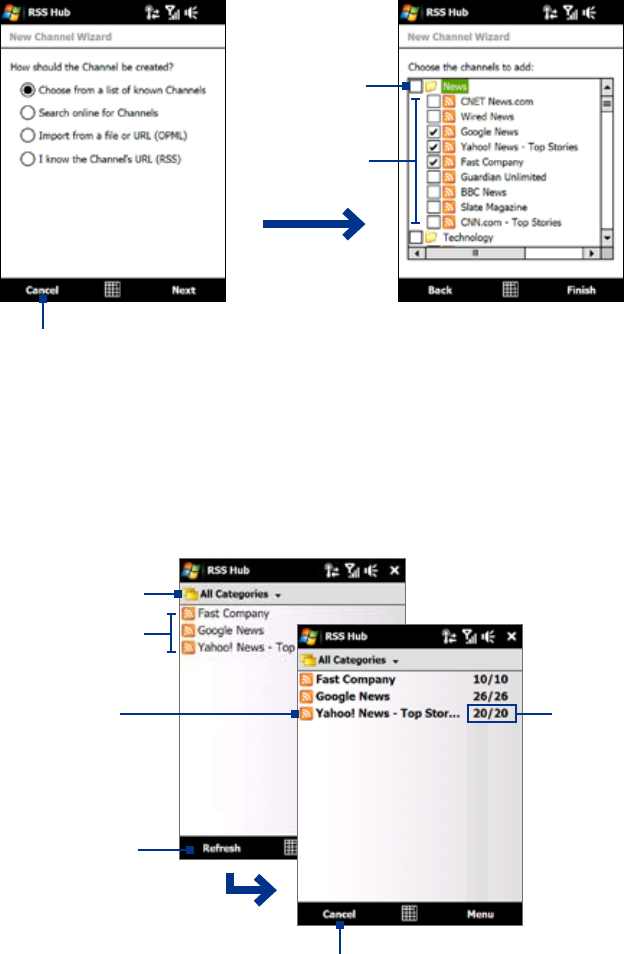
Internet 91
8.7 Using RSS Hub
RSS Hub is an RSS reader that keeps you up-to-date with the latest news from the Internet. It monitors
Internet news channels and downloads the most current news updates and podcasts so you are instantly
informed of breaking news and events.
For more information and tips on using RSS Hub, see Help on your device.
Note Make sure you have an active Internet connection (such as a data connection) before using RSS Hub.
Subscribe to and organize news channels
You must subscribe to news channels before you can receive RSS feeds.
To subscribe to news channels
1. Tap Start > Programs > RSS Hub, then tap Continue.
2. In the New Channel Wizard screen, select the Choose from a list of known Channels option, then tap
Next. A list of RSS channels is displayed.
Channels
Category
Tap to load pre-selected RSS channels.
Note If the RSS channel you want to subscribe to is not in the list of known channels, tap Back, then select
another option on the New Channel Wizard screen. For more information on these other options, see
the Help on your device.
3. Select the checkboxes of the RSS channels you want to subscribe to, then tap Finish.
Tip Channels are grouped by categories. If you want to select all channels in a category, select the category
check box.
4. The channel list appears. Tap Refresh to update the channels.
Tap to cancel channel updating
Channel is updated.
Tap it to view the headlines.
Tap to select the channel
category to display
Headline count
Tap to update the channels
Channel list
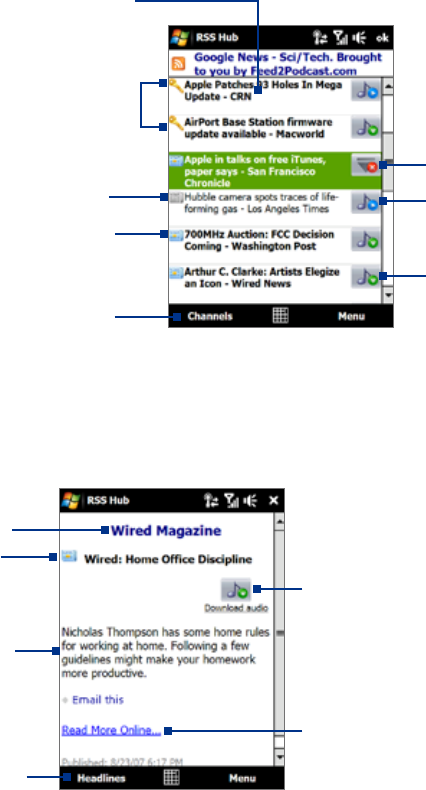
92 Internet
To add new channels
1. In the channel list, tap Menu > Channel > New to open the New Channel Wizard screen.
2. Select an option, then follow screen instructions to add new channels. For more information on New
Channel Wizard options, see Help on your device.
To filter the channels in the display
In the channel list, tap Menu > View, then select:
Updated to display only those channels with unread headlines.
All to display all subscribed channels.
Manage channel categories
To view all the channels in a particular category, tap All Categories in the upper left area of the channel list,
then tap the category you want to display.
To add a new category, tap Menu > Categories in the channel list to display all categories, then tap Menu >
New.
To rename or delete a category, tap Menu > Categories in the channel list to display all categories, select a
category, then tap Menu > Rename or Menu > Delete.
If you want to change the channel category, tap and hold the channel in the channel list, then tap Change
Category. Select a new category and tap OK.
View and organize headlines
Tap a channel in the channel list to display the headlines for that channel.
Tap a headline to open the
news summary screen
Headline or news summary
contains a keyword
Tap to download audio/video
file attachment
Audio/Video/Image file
attachment is downloading
Tap to play back or view the
file attachment.
New or unread headline
Headline has been read
Tap to return to the channel list
New or unread headlines display in bold and are marked with a blue newspaper icon. Headlines that have
been read are marked with a gray newspaper icon.
View the news summary
Tap a headline in the headline list to display the news summary.
Headline and
read status Audio/Video/Image file attachment.
Tap to download the file.
News summary
Tap to open the news item in Opera
Mobile. See “Using Opera Mobile” in
this chapter for details.
Channel name
Tap to return to
the headline list
•
•
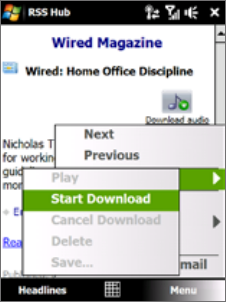
Internet 93
To change view options
In the news summary screen, tap Menu to change the text size, fit the text to the screen (text wrap), or enable
ClearType for better viewing.
To download, play, or save podcasts
1. When you see an audio or video file attachment in the news summary, do one of the following to
download the file:
Tap Menu > Podcasts > Start Download.
Tap the Download audio/Download video link below the audio/video file icon.
Tip To cancel the file download, tap Menu > Podcasts > Cancel Download, or tap Cancel download
below the audio/video file icon.
2. After downloading the file, do one of the following:
Tap Menu > Podcasts > Play or tap Play audio/Play video below the audio/video file icon to play
back the file.
Tap Menu > Podcast > Save to save a copy of the file to the device main memory or internal
storage.
To send the headline link via e-mail
1. In the news summary screen, tap Menu > Send Link via Email.
2. Messaging opens and displays the Account Picker screen. Tap the e-mail account you want to use to
send the headline link. A new e-mail message is then created with the headline link.
3. Specify the e-mail recipients, then send it.
Note For more information on how to compose e-mails, see “Using E-mail” in Chapter 6.
To view the next or previous news summary
In the news summary screen, tap Menu > Next or Menu > Previous, or press Navigation left or right.
For more information about the features and configuring RSS Hub, refer to the online help. To open the online
help, tap Start > Help while in RSS Hub.
•
•
•
•
94 Internet

Chapter 9
Bluetooth
9.1 Bluetooth Modes
9.2 Bluetooth Partnerships
9.3 Connecting a Bluetooth Hands-free
or Stereo Headset
9.4 Beaming Information
Using Bluetooth
9.5 Bluetooth Explorer and
Bluetooth File Sharing
9.6 Printing Files via Bluetooth

96 Bluetooth
9.1 Bluetooth Modes
Bluetooth is a short-range wireless communications technology. Devices with Bluetooth capabilities can
exchange information over a distance of about eight meters without requiring a physical connection.
Bluetooth on your device operates in three different modes:
On. Bluetooth is turned on. Your device can detect other Bluetooth-enabled devices, but not vice versa.
Visible. Bluetooth is turned on, and all other Bluetooth-enabled devices can detect your device.
Off. Bluetooth is turned off. In this mode, you can neither send nor receive information using Bluetooth.
Notes • By default, Bluetooth is turned off. If you turn it on, then turn off your device, Bluetooth also turns off. When you
turn on your device again, Bluetooth automatically turns on.
• Turn off Bluetooth when not in use to conserve battery power, or in places where using a wireless device is
prohibited, such as on board an aircraft and in hospitals.
To turn Bluetooth on and make your device visible
1. On the Home screen, slide to the Settings tab and then tap Menu > Bluetooth Devices > Mode tab.
2. Select the Turn on Bluetooth and Make this device visible to other devices check boxes.
3. Tap OK. The Title bar will show to indicate that the device is in Visible mode.
To turn off Bluetooth visibility after a certain period of time
You can automatically turn off Bluetooth visibility after a specified period of time.
1. On the Home screen, slide to the Settings tab and then tap Menu > Bluetooth Devices > Timeout
tab.
2. In Turn off Visible mode, select the time before your device’s Bluetooth visibility turns off. Tap OK.
9.2 Bluetooth Partnerships
A Bluetooth partnership is a relationship that you create between your device and another Bluetooth-enabled
device in order to exchange information in a secure manner.
To create a Bluetooth partnership
1. On the Home screen, slide to the Settings tab and then tap Menu > Bluetooth Devices > Devices tab.
2. Tap Add new device. Your device displays the names of other Bluetooth devices within range.
3. Tap the device name in the box, then tap Next.
4. Specify a passcode to establish a secure connection. The passcode can be 1 up to 16 characters.
5. Tap Next.
6. Wait for the paired device to accept the partnership. The receiving party needs to enter the same
passcode that you specified.
7. The name of the paired device is then displayed. You may edit and enter a new name for that device.
8. Select the check boxes of services that you want to use from the paired device, then tap Finish.
Note Creating a Bluetooth partnership between two devices is a one-time process. Once a partnership is created, the
devices can recognize the partnership and exchange information without entering a passcode again.
To accept a Bluetooth partnership
1. Ensure that Bluetooth is turned on and in visible mode.
2. Tap Yes when prompted to establish a partnership with the other device.
3. Enter a passcode (the same passcode that is entered on the device requesting the partnership) to
establish a secure connection. The passcode must be between 1 and 16 characters.
4. Tap Next.
5. Tap Finish. You can now exchange information with the paired device.
Tips • To rename a Bluetooth partnership, tap and hold the partnership’s name on the Devices tab of the Bluetooth
screen, then tap Edit.
• To delete a Bluetooth partnership, tap and hold the partnership’s name on the Devices tab, then tap Delete.
•
•
•

Bluetooth 97
9.3 Connecting a Bluetooth Hands-free or Stereo Headset
For hands-free phone conversations, you can use a Bluetooth hands-free headset such as a car kit with your
device. Your device also supports A2DP (Advanced Audio Distribution Profile) which allows you to use a
Bluetooth stereo headset for hands-free phone conversations and for listening to stereo music.
To connect a Bluetooth hands-free or stereo headset
1. Make sure that both your device and the Bluetooth headset are turned on and within close range,
and that the headset is visible. Refer to the manufacturer’s documentation to find out how to set the
headset in visible mode.
2. On the Home screen, slide to the Settings tab and then tap Menu > Bluetooth Devices > Devices tab
> Add new device.
3. Tap the name of the Bluetooth headset, then tap Next. The device will automatically pair the device
with the Bluetooth headset.
Windows Mobile will automatically try one of the preconfigured passcodes (0000, 1111, 8888, 1234) to pair
the Bluetooth headset with the device. If this fails, you have to enter the passcode delivered with your headset
manually.
Note If the Bluetooth stereo headset becomes disconnected, turn the headset on and repeat step 1 to 2 above. Tap and
hold the name of the Bluetooth stereo headset and tap Set as Wireless Stereo.
9.4 Beaming Information Using Bluetooth
You can beam information, such as contacts, calendar items, tasks, and files from your device to your
computer or to another Bluetooth-enabled device.
Note If your computer does not have built-in Bluetooth capability, you need to connect and use a Bluetooth adapter or
dongle on your computer.
To beam information from your device to a computer
1. Turn on Bluetooth on your device, and make your device visible. For information about this, see “To
turn Bluetooth on and make your device visible”.
2. Set Bluetooth on your computer to visible mode, create a Bluetooth partnership, then enable your
computer to receive Bluetooth beams.
Note If the Bluetooth adapter or dongle on your computer was installed using a third-party provided driver,
open the Bluetooth software that came with the Bluetooth adapter/dongle and enable the adapter/
dongle to be discovered by other devices. Refer to the Bluetooth adapter’s documentation for more
information.
If your computer has Windows Vista or Windows XP SP2 and your computer’s Bluetooth adapter is
supported by your Windows version, do the following steps:
a. On your computer, open Bluetooth Devices from the Control Panel, then click the Options tab on
the Bluetooth Devices window.
b. For Windows Vista, select Allow Bluetooth devices to find this computer. For Windows XP,
select Turn discovery on and Allow Bluetooth devices to connect to this computer.
c. Create a Bluetooth partnership between your device and computer. For information about
creating a partnership, see “Bluetooth partnerships”.
d. In the Options tab of Bluetooth Devices, select Show the Bluetooth icon in the notification
area.
e. To enable your computer to receive Bluetooth beams, right-click the Bluetooth icon in the
notification area at the bottom-right corner of your computer screen and select Receive a File.
You are now ready to beam.
3. On your device, select an item to beam. The item can be an appointment in your calendar, a task, a
contact card, or a file.
4. To beam a contact, tap Menu > Send Contact > Beam. To beam other types of information, tap Menu
> Beam [type of item].
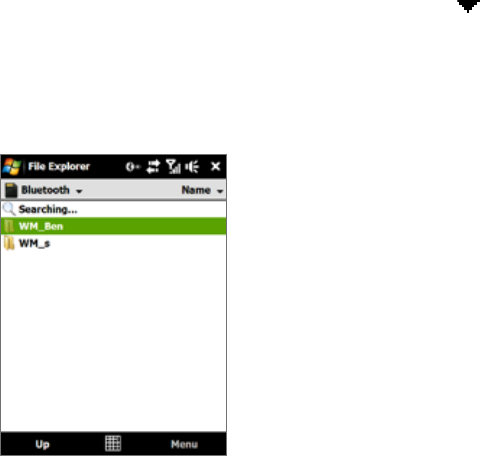
98 Bluetooth
5. Tap the device name to which you want to send the item.
6. If you beamed a calendar, task, or contact item to your computer and it is not automatically added to
Outlook, select File > Import and Export in Outlook to import it.
To beam information to a Bluetooth-enabled device such as another Windows Mobile-powered device, follow
steps 1 to 5 in the above procedure.
Tips • The default folder on your computer where beamed items are stored may be C:\Documents and Settings\your_
username\My Documents in Windows XP or C:\Users\your_username\My Documents in Windows Vista.
• For your device to receive Bluetooth beams, tap Start > Settings > Connections tab > Beam and make sure the
Receive all incoming beams check box is selected.
9.5 Bluetooth Explorer and Bluetooth File Sharing
Bluetooth Explorer searches for other Bluetooth devices that have file sharing enabled and lets you access
their Bluetooth shared folder. You can copy files from and to their shared folder, and create subfolders in it.
When you enable Bluetooth file sharing on your device, other Bluetooth-enabled devices will also be able to
access your Bluetooth shared folder.
To enable Bluetooth Explorer and Bluetooth file sharing on your device
1. On the Home screen, slide to the Settings tab and then tap Menu > Bluetooth Devices > FTP tab.
2. Select the Enable Bluetooth Explorer check box. This makes the \Bluetooth device folder visible in
the File Explorer.
3. Select the Enable File Sharing check box. You can use the default Bluetooth shared folder, or tap
Browse to use another folder as your shared folder.
4. Tap OK.
To use Bluetooth Explorer
1. Bluetooth Explorer is integrated with the File Explorer program. You can open it by tapping Start >
Programs > Bluetooth Explorer or by tapping the down arrow ( ) on the upper left of File Explorer
screen then tapping Bluetooth.
2. Bluetooth Explorer then scans for other Bluetooth devices that have file sharing enabled. From the list,
tap to select a Bluetooth device you want to connect to. You may need to enter a passcode in order for
you to connect to the selected device. If there are files contained in the Bluetooth shared folder on the
other device, you will be able to see them on the Bluetooth Explorer screen.
3. Select one or more files, then tap Menu > Edit and choose to cut or copy the files.
4. Tap Up twice.
5. Navigate to the folder where you want to paste the files on your device, then tap Menu > Edit > Paste.
Bluetooth 99
9.6 Printing Files via Bluetooth
Connect your device to a Bluetooth printer to print contact information, appointment details, images, and
other file types.
Note You can print files in the .txt, .jpg, .xhtml, .vcf, .vcs file formats.
Before you start printing, make sure to turn on the Bluetooth printer and to turn on Bluetooth on your device.
To turn on Bluetooth, tap Start > Settings > Connections tab > Comm Manager, then tap the Bluetooth
button.
To print contact information
1. On the Home screen, slide to the People tab and then tap All People.
2. Select the contact whose information you want to print.
3. Tap Menu > Print via Bluetooth > Menu > Search Devices. Your device starts to search for Bluetooth
devices.
4. Select the Bluetooth printer and tap Menu > Send File.
5. Set the printing options you want, then tap Print.
To print a calendar appointment
1. Tap Start > Calendar, then select (highlight) the appointment whose details you want to print.
2. Follow steps 3 to 5 in the “To print contact information” procedure.
To print a JPEG file
1. In Pictures & Videos, locate the JPEG file you want to print.
2. Tap and hold the JPEG image file and then on the menu, tap Print via Bluetooth.
3. Follow steps 3 to 5 in the “To print contact information” procedure:
To print a text file
1. In File Explorer, locate the text file you want to print.
2. Tap and hold the txt file and then on the menu, tap Print via Bluetooth.
3. Follow steps 3 to 5 in the “To print contact information” procedure:
100 Bluetooth

Chapter 10
Navigating on the Road
10.1 Guidelines and Preparation
for Using GPS
10.2 Downloading Satellite Data
via QuickGPS
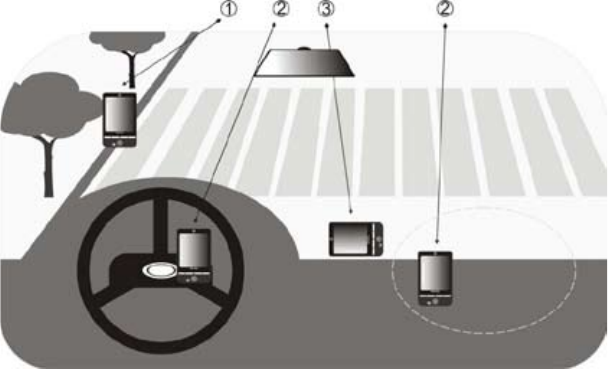
102 Navigating on the Road
10.1 Guidelines and Preparation for Using GPS
If you install a GPS software on your device, please follow these guidelines before and when using your device
as a GPS device.
Do not operate the GPS system while driving. The plotted GPS route is only for driving reference. It
should not interfere with actual driving behavior.
When using the device inside a vehicle, use the car holder to mount the device securely in place. Avoid
placing the device in the areas shown in the following diagram:
1 Do not place where it will block the driver’s vision.
2 Do not place where air bags could deploy.
3 Do not place anywhere in the vehicle without securing the device in the holder.
Please use the GPS system cautiously. Users shall be liable for any damages resulting from negligent
operation of the system.
The GPS signal cannot pass through solid non-transparent objects. Signal reception may be affected by
obstructions such as high-rise buildings, tunnels, bridges, forests, weather (rainy or cloudy days), etc. If
the vehicle’s visor contains metal, it will be difficult for the GPS signal to pass through.
Wireless communication products (such as mobile phones or radar-detecting devices) may interfere
with the satellite signal, resulting in unstable signal reception.
The Global Positioning System (GPS) is built and operated by the US Defense Department. The
Department is responsible for the accuracy and maintenance of the system. Any changes that the
Department makes may affect the accuracy and function of the GPS system.
Do not leave your device in a vehicle or expose the device to direct sunlight to avoid overheating the
battery, which could pose damage to the device or risk to the vehicle.
•
•
•
•
•
•
•
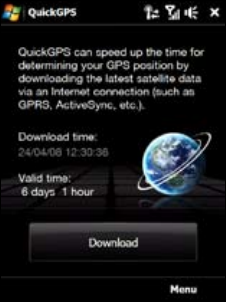
Navigating on the Road 103
10.2 Downloading Satellite Data via QuickGPS
Before you start using your device for GPS navigation, open the QuickGPS program first to download
ephemeris data (current satellite position and timing information) onto your device. This data is needed to
determine the GPS position of your current location.
QuickGPS downloads ephemeris data from a Web server, instead of from the satellites, using the Internet
connection on your device, which can be via Wi-Fi, ActiveSync or data connection. This significantly speeds up
the time for determining your GPS position.
To open QuickGPS
Tap Start > Programs > QuickGPS.
To download data
Tap Download on the QuickGPS screen.
On the screen, initially, you will see the Valid time of the downloaded data. As time passes, the remaining
days and hours of validity will be shown.
To speed up GPS positioning, download the latest ephemeris data when the validity of the data expires.
Download options
To configure download times, tap Menu > Options and choose from the available options:
Remind me when data expires. Enables your device to display a reminder message when the validity
of the ephemeris data has expired. When you see the reminder message, tap Menu to dismiss the
reminder or to set the snooze time so that you will be reminded again. Tap OK to open the QuickGPS
program and download the latest data.
Autodownload when data expires. Allows ephemeris data to be automatically updated onto your
device when the data has expired.
Autodownload when connected to PC via ActiveSync.
Allows ephemeris data to be automatically downloaded via ActiveSync to your device when your
device is connected to your computer. Your computer must be connected to the Internet in order to
download data.
Note The ephemeris data is stored on HTC Web servers. QuickGPS is preconfigured to connect to these servers.
•
•
•
104 Navigating on the Road

Chapter 11
Experiencing Multimedia
11.1 Taking Photos and Videos
11.2 Viewing Photos and Videos Using Album
11.3 Using Windows Media® Player Mobile
11.4 Using Audio Booster
11.5 Using MP3 Trimmer
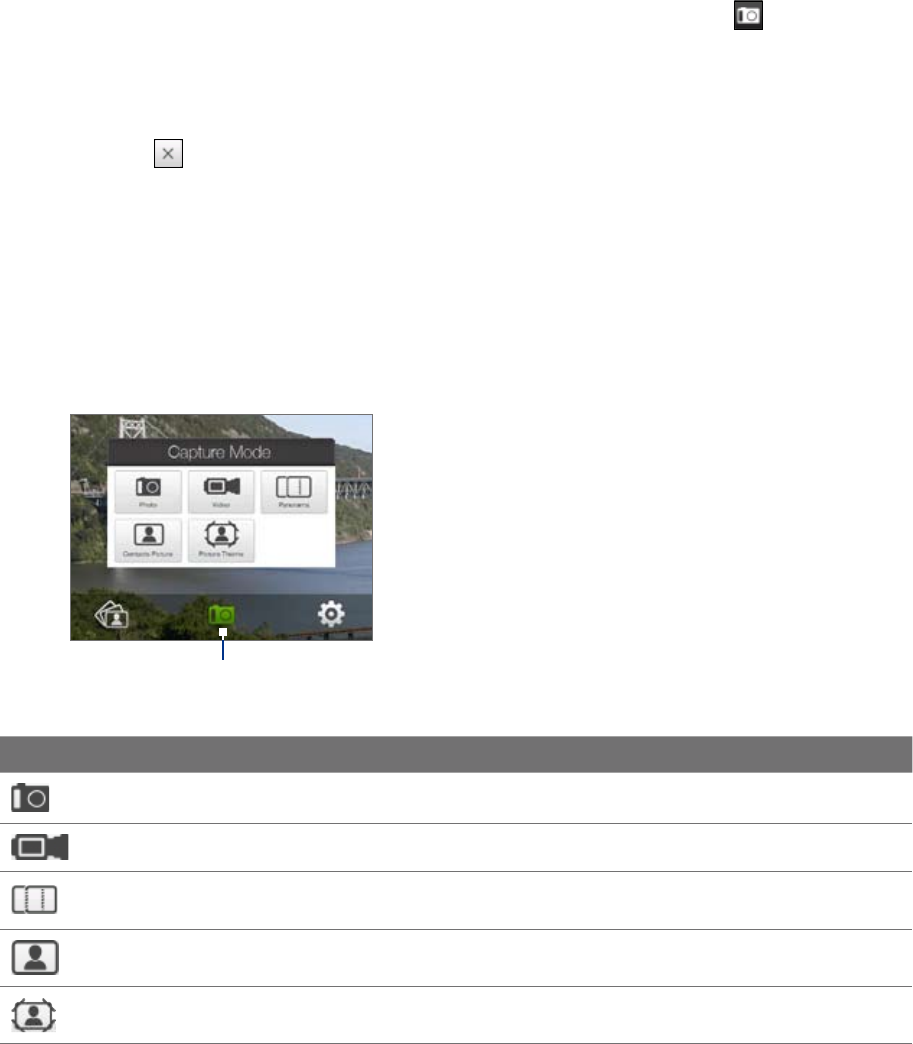
106 Experiencing Multimedia
11.1 Taking Photos and Videos
Use Camera to take photos and record video clips. You can either use the camera to take photos or shoot
videos.
To open the Camera screen
On the Home screen, slide to the Photos and Videos tab and then tap the camera icon ( ). The screen
orientation automatically switches to landscape mode when you open Camera.
Tip You can also tap Start > Programs > Camera to open the Camera program.
To exit the Camera
Tap the Exit icon ( ) on the Camera screen. Tap the screen to show the Camera screen icons.
Capture modes
The camera on your device allows you to capture pictures and video clips by using various built-in modes that
provide you flexibility in taking your shots.
To change the capture mode
Press Navigation left or right (Landscape orientation).
Tap the middle icon at the bottom of the screen (the icon displayed is based on the current Capture
mode). On the on-screen menu, tap the Capture mode you want to use.
Current Capture mode
You can select from the following capture modes:
Icon Capture Mode
Photo Captures standard still images.
Video Captures video clips, with or without accompanying audio.
Panorama Captures a sequence of still images continuously in one direction, and allows stitching of all the
images to create a panoramic view of a scenery.
Contacts Picture Captures a still image and gives you the option to immediately assign it as a Photo ID for a
contact.
Picture Theme Captures still images and places them within frames.
•
•
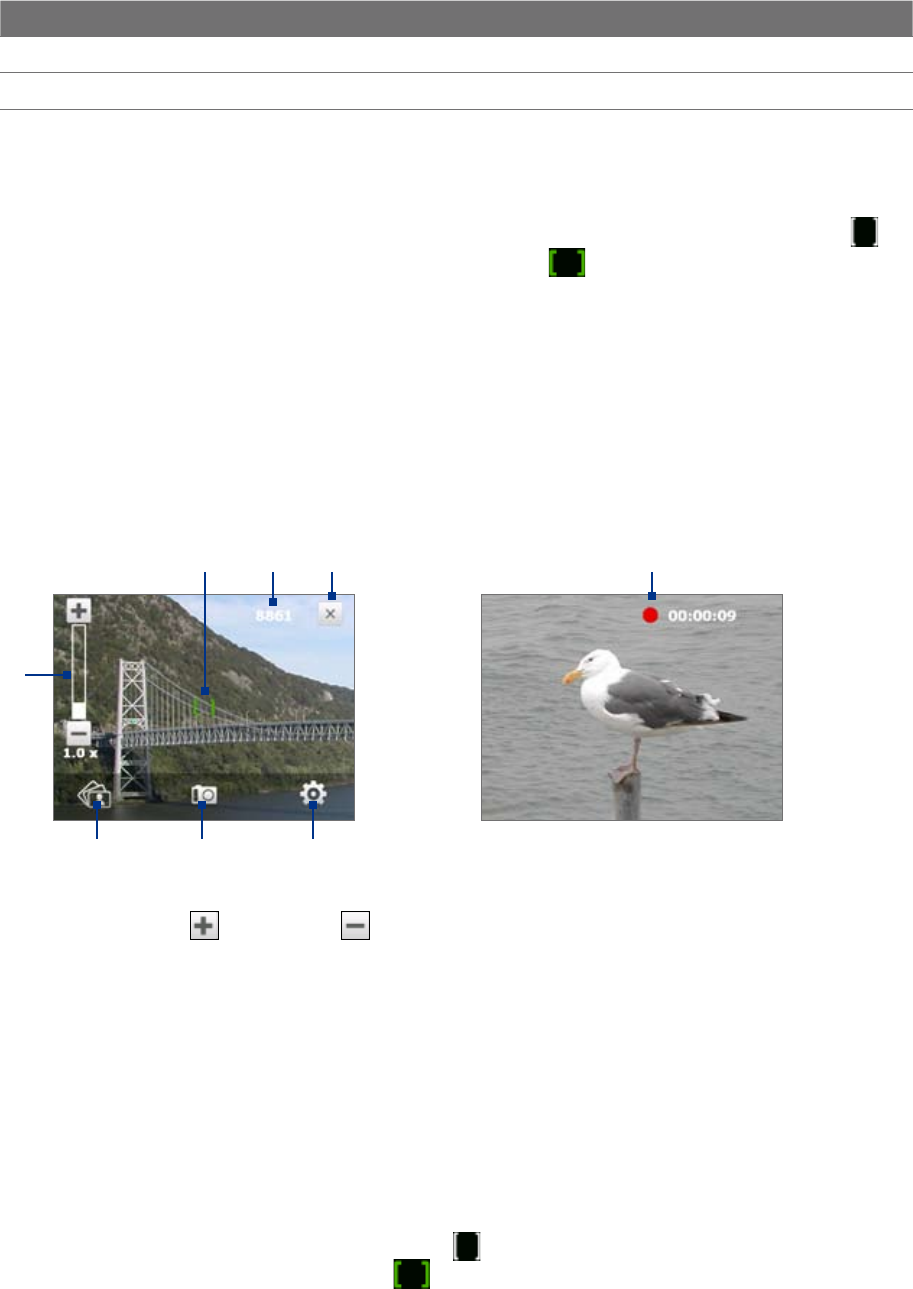
Experiencing Multimedia 107
Supported file formats
Using the available capture modes, the camera in your device captures files in the following formats:
Capture mode Format
Photo / Contacts Picture / Picture Theme / Panorama JPEG
Video H.263 (.3gp) ; MPEG-4 (.mp4)
Camera controls
The camera comes with an auto-focus function to let you capture sharp and crisp photos and videos of your
subjects. Depending on the Shoot Option you have chosen, you will need to either touch or press the ENTER
button to activate auto-focus. When auto-focus is activated, it is indicated by a flashing white bracket ( ).
When focus is set, the bracket changes to a steady green bracket ( ).
Note For more information about the different shoot options, see “Advanced Options” in this chapter.
By default, you only need to press the ENTER button once to activate auto-focus and to take the photo or start
capturing video. For example, in Photo mode, press ENTER to activate auto-focus; when focus is set, Camera
automatically takes the shot.
Notes • In Video mode, press ENTER again to stop recording.
• In Picture Theme or Panorama mode, press ENTER for each shot you need to take.
On-screen controls and indicators
Tap the screen to display the controls and indicators.
When capturing in Video mode
Photo, Video, and Contacts Picture modes
1
2 3 4
567 8
1 Zoom control. Tap to zoom in, or to zoom out.
Tip You can also press Navigation up/down (Landscape orientation) or slide your finger clockwise or
counterclockwise on the center Navigation Control to zoom in or out.
2 Album. Tap to open Album. See “Viewing Photos and Videos Using Album” for details.
3 Capture mode. Displays the current capture mode. Tap to open an on-screen menu where you can choose
the capture mode.
4 Menu. Tap to open the Camera Settings screen. See “Menu Panel” for details.
5 Exit. Tap to exit the Camera program.
6 Remaining information indicator. In Photo, Contacts Picture, Picture Theme, and Panorama modes, this
shows the remaining/available shots of pictures based on the current settings.
In Video mode, this shows the remaining duration that can be recorded. While recording video, this shows
the recorded duration.
7 Auto-focus indicator. Displays a flashing bracket ( ) when focusing. When focus is set, the flashing
bracket changes to a steady green bracket ( ).
8 Recording indicator. Flashes when recording a video.
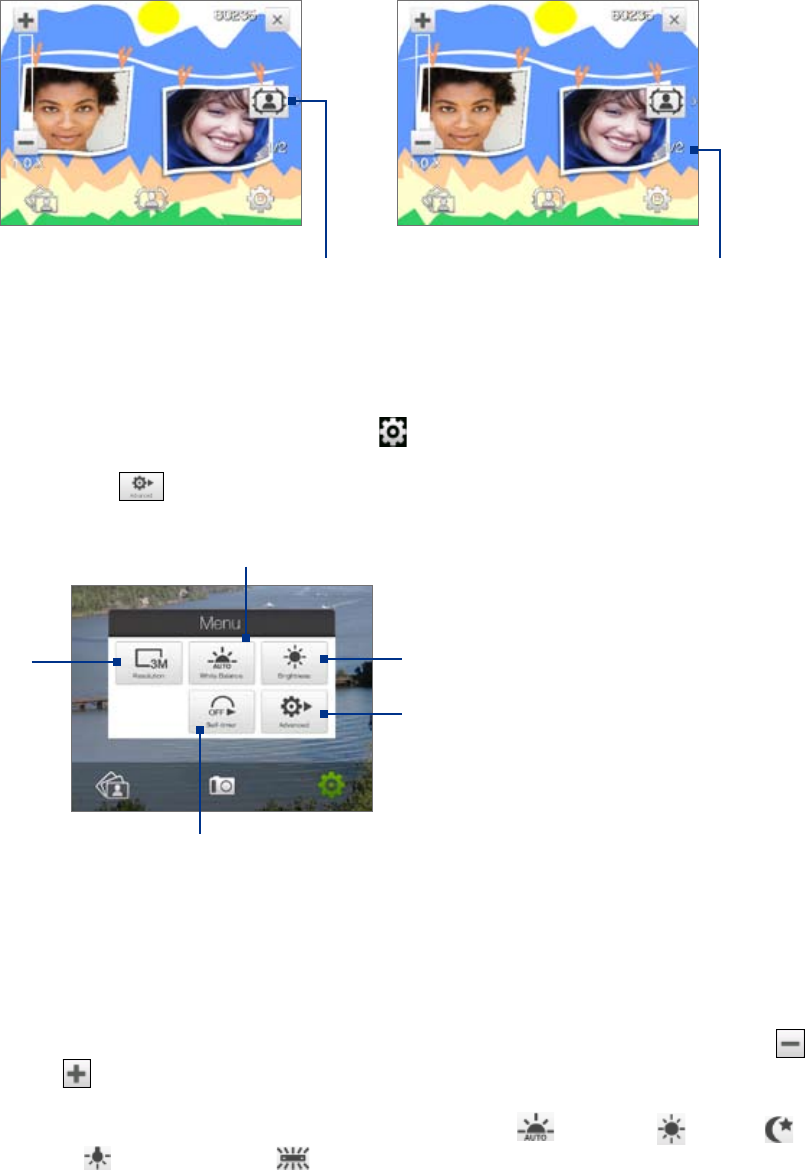
108 Experiencing Multimedia
Picture Theme mode
9 10
9
Template Selector icon. In Picture Theme mode, tap to toggle among different templates.
10
Progress indicator. In Picture Theme and Panorama modes, this shows the number of consecutive shots.
Menu Panel
The Menu Panel provides a quick way of adjusting most common camera settings and lets you access more
advanced camera settings. On the Camera screen, tap to open the Menu Panel. To adjust a setting, keep
tapping a button on the panel, for instance, Resolution, to cycle through the available settings. To access
advanced options, tap .
Note The available settings on the panel depend on the selected Capture mode.
1
2
3
4
5
1 Resolution. Tap to change the resolution (capture size). See the table in the following pages for the
supported resolutions.
2 Self-timer. Tap to set the self-timer to 2 seconds, 10 seconds, or Off when in the Photo or Contacts
Picture mode. When you press the ENTER button to capture a still image, it starts to count down, then
captures a still image after the time expires.
3 Advanced. Tap to open the advanced camera settings. See “Advanced Options” for details.
4 Brightness. Tap to open the Brightness bar at the bottom of the screen. On the Brightness bar, tap to
decrease, or to increase the brightness level. Tap outside the Brightness bar to apply the change.
5 White Balance. White balance enables the camera to capture colors more accurately by adjusting to
different lighting conditions. White balance settings include: Auto ( ), Daylight ( ), Night ( ),
Incandescent ( ), and Fluorescent ( ).
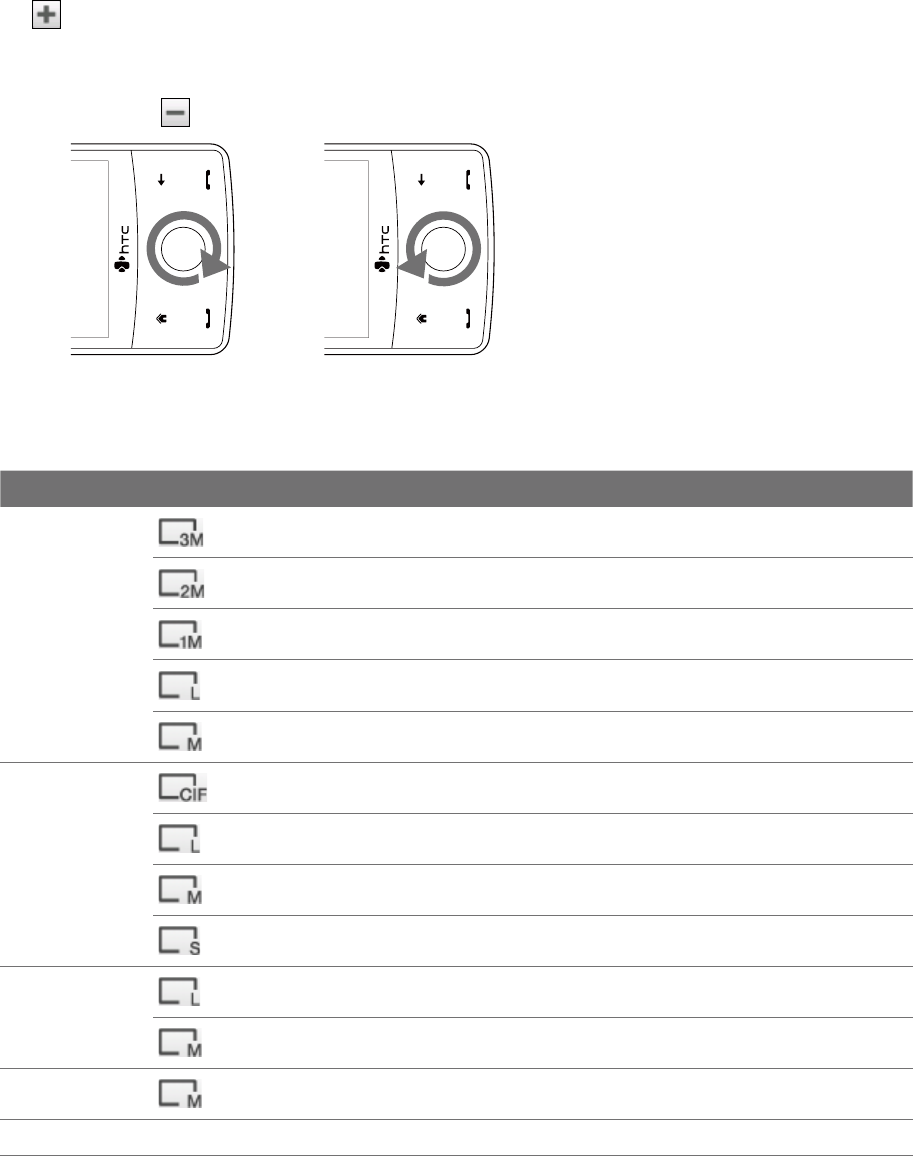
Experiencing Multimedia 109
Zooming
Before capturing a photo or a video clip, you can zoom in to make the object in focus move closer, or zoom
out to make the object move farther away.
To zoom in
Slide your finger around the Navigation Control clockwise, press Navigation up (Landscape orientation), or
tap .
To zoom out
Slide your finger around the Navigation Control counterclockwise, press Navigation down (Landscape
orientation), or tap .
Zoom OutZoom In
The camera zoom range for a photo or a video clip depends on the capture mode and resolution. Refer to the
table for more information.
Capture mode Resolution Zoom range
Photo
3M (2048 x 1536) 1.0x to 2.0x
2M (1600 x 1200) 1.0x to 2.0x
1M (1280 x 960) 1.0x to 2.0x
Large (640 x 480) 1.0x to 2.0x
Medium (320 x 240) 1.0x to 4.0x
Video
CIF (352 x 288) 1x and 1.5x
Large (320 x 240) 1x and 1.5x
Medium (176 x 144) 1x and 1.5x
Small (128 x 96) 1x and 1.5x
Panorama
Large (640 x 480) 1x and 2x
Medium (320 x 240) 1x, 2x and 4x
Contacts Picture Medium (240 x 320) 1.0x to 4.0x
Picture Theme Determined by the current template Depends on the size of the selected template
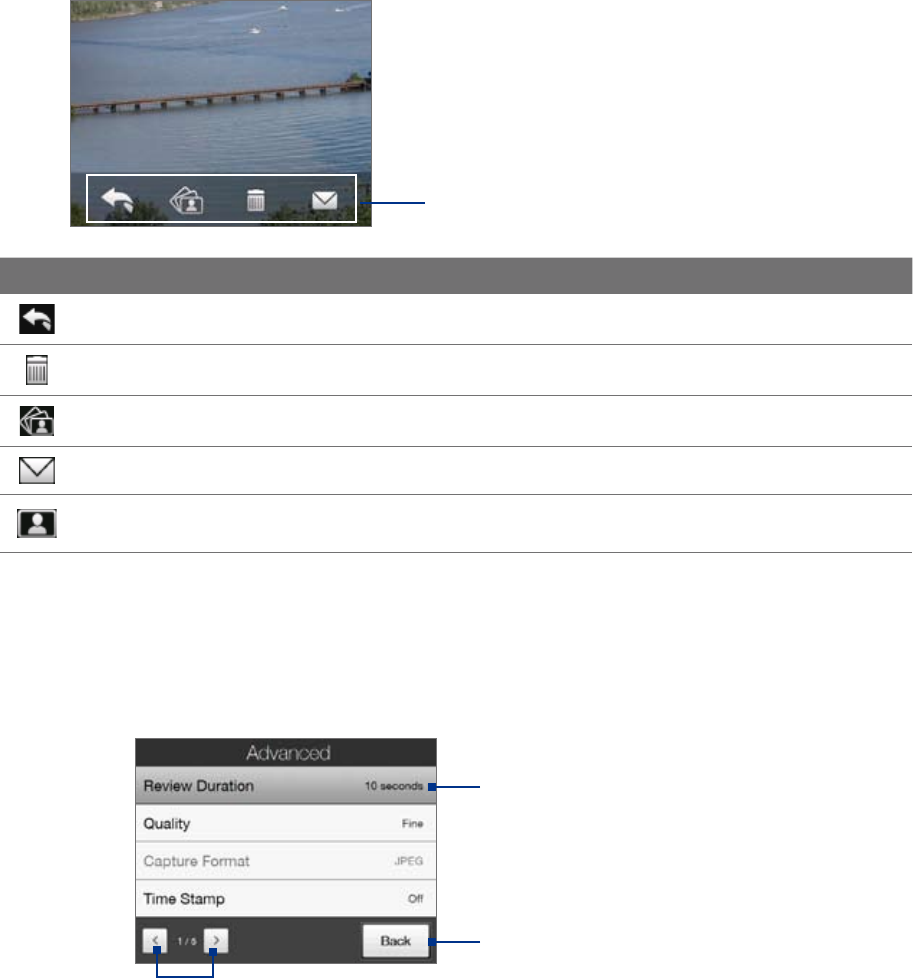
110 Experiencing Multimedia
The Review screen
After capturing, the Review screen lets you view, send, or delete the photo or video clip by tapping an icon at
the bottom of the screen.
Review screen icons
Icon Function
Back Return to the live Camera screen.
Delete Delete the captured image or video.
View View the captured image or video in the Album program.
Send Send the captured image or video via e-mail.
Assign to Contact After capturing in Contacts Picture mode, tap this icon to assign the photo to a selected
contact.
Advanced Options
The Advanced Options let you adjust options for your selected capture mode and set Camera program
preferences. Access the Advanced Options by tapping Advanced on the Menu Panel.
You can either tap on-screen or press Navigation up/down (Landscape orientation) to navigate through the
Advanced Options screen.
Tap to go through the different
Advanced Camera Settings screens.
Tap to go back to the Camera screen.
Tap an item to change the setting.
Quality. Select the JPEG image quality level for all captured still images. Choose from Basic, Normal,
Fine, and Super Fine.
Capture Format. Select the desired file format.
Time Stamp (Photo mode). Choose whether or not to include the shooting date and time on captured
photos.
Storage. Select where you want to save your files. You can either save the files to the main memory or
to the internal storage.
Keep Backlight. Turn the backlight on or off. This overrides your device backlight settings while you are
using the camera.
•
•
•
•
•
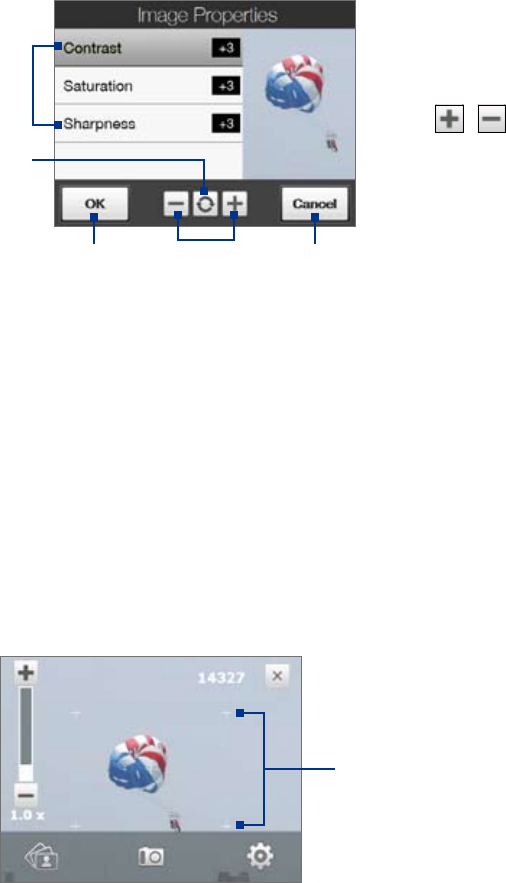
Experiencing Multimedia 111
Shutter Sound. Choose whether or not you want the camera to make a shutter sound when you press
the ENTER button.
Shoot Option. The camera comes with an auto-focus feature that is activated when the ENTER button is
either touched or pressed.
Touch and Press. Requires you to touch the ENTER button to activate the auto-focus; when focus is
set, press the ENTER button to take the shot.
Touch. Requires you to touch the ENTER button to activate autofocus; when focus is set, Camera
automatically takes the shot.
Full Press. Requires you to press the ENTER button to activate auto-focus; when focus is set, Camera
automatically takes the shot.
Review Duration. Set a time length for displaying the captured image/video on the Review screen.
Select No Limit if you do not want to impose a time limit. Select No Review to immediately return to
the live Camera screen after capturing and saving.
Image Properties. This option lets you adjust the capture properties, such as Contrast, Saturation, and
Sharpness.
1Tap a property to adjust.
2Tap to reset all properties to their
default values.
3Tap to save the settings.
4Tap / or press NAVIGATION
left/right (Landscape orientation) to
increase/decrease the value.
5Tap to close the submenu without
applying and saving the changes.
1
2
53 4
Effect. Choose a special effect such as Grayscale, Sepia, or others, to apply to your photos or video clips.
Metering Mode. Select a metering mode to allow the camera to measure the amount of light and
calculate the best-fit exposure value before capturing. Choose either Center Area to measure light
using the center area of the subject, or Average to measure light using the area around the subject.
Prefix. When Default is selected as the prefix, the file name of each new captured file is set to “IMAGE”
or “VIDEO” followed by a sequential number, for example: IMAGE_001.jpg. You may also choose to name
files using either the current Date or Date & Time as the prefix.
Counter. To reset the file naming counter back to 1, tap Reset.
Flicker Adjustment. When taking indoor shots, flicker on the camera screen may be caused by
inconsistencies between the vertical scan rate of the camera display and the flicker frequency of
fluorescent lighting. To reduce flicker, you can change the flicker adjustment setting to Auto or to the
proper frequency (50Hz or 60Hz) of the power in the country where your device is being used.
Grid (Photo mode). Choose whether or not to show a grid on the Camera screen. Showing a grid helps
you frame and center your subject easily and accurately.
Grid marks
Record with Audio (Video mode). Select On to record audio with the captured video clips, or select Off
to capture video without audio.
•
•
•
•
•
•
•
•
•
•
•
•
•
•
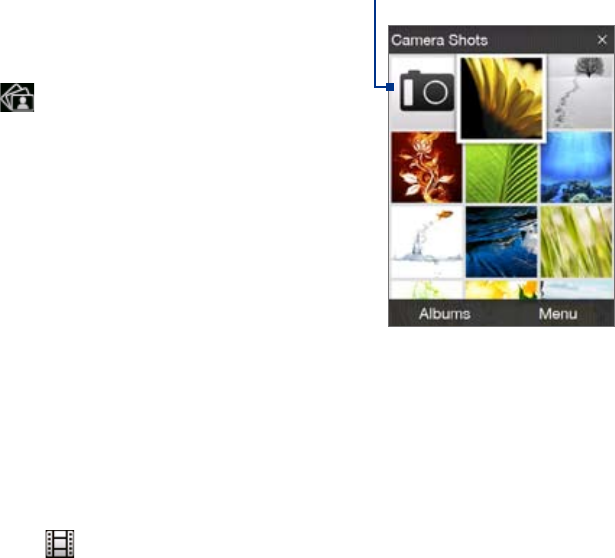
112 Experiencing Multimedia
Template (Picture Theme mode). Select a template.
Recording Limit (Video mode). Set the maximum duration or file size for recording video.
Template Folder (Picture Theme mode). By default, templates are stored in the \My Documents\
Templates folder on the device’s Main Memory. If you transferred some templates to the internal
storage (via File Explorer), set this option to Main + Card to specify that templates are located in both
the main memory and the internal storage.
Show Reminder (Contacts Picture mode). Select On if you want the Camera to always display a
message that confirms whether or not to assign the captured picture to a contact.
Help. Tap to open the Camera program help file.
About. Tap to display version and copyright information.
11.2 Viewing Photos and Videos Using Album
Use Album to view images and videos in your device. Album offers a host of features that let you rotate
images, view your images as a slideshow, use images as contact pictures, and more.
Note Album can only display files in the BMP, GIF, PNG, JPG, Animated GIF, 3GP, MP4, and WMV formats.
Tap to open the Camera program.
To open Album
Do one of the following:
On the Home screen, slide to the Photos and Videos tab and tap
Album.
In the Camera program, tap .
Tap Start > Programs > Album.
Note When you open Album from the Camera program, the screen
orientation of Album is switched to landscape mode.
•
•
•
Select a photo or video to view
1. On the main Album screen, tap Albums and then select the album to view. The contents of the album
are then displayed on the main Album screen.
2. Browse through the files by sliding your finger upward or downward.
3. Do one of the following:
Tap an image to view it in full screen mode. See “View an image” for details.
Tap a video file (files with the icon) to play back the video file. See “Play back video” in this
chapter for details.
Select a still image and then tap Menu > Slideshow to view the images in the album as a
slideshow. Animated GIF and video files will not be played back in the slideshow. See “To view still
images as a slideshow” in this chapter for details.
•
•
•
•
•
•
•
•
•
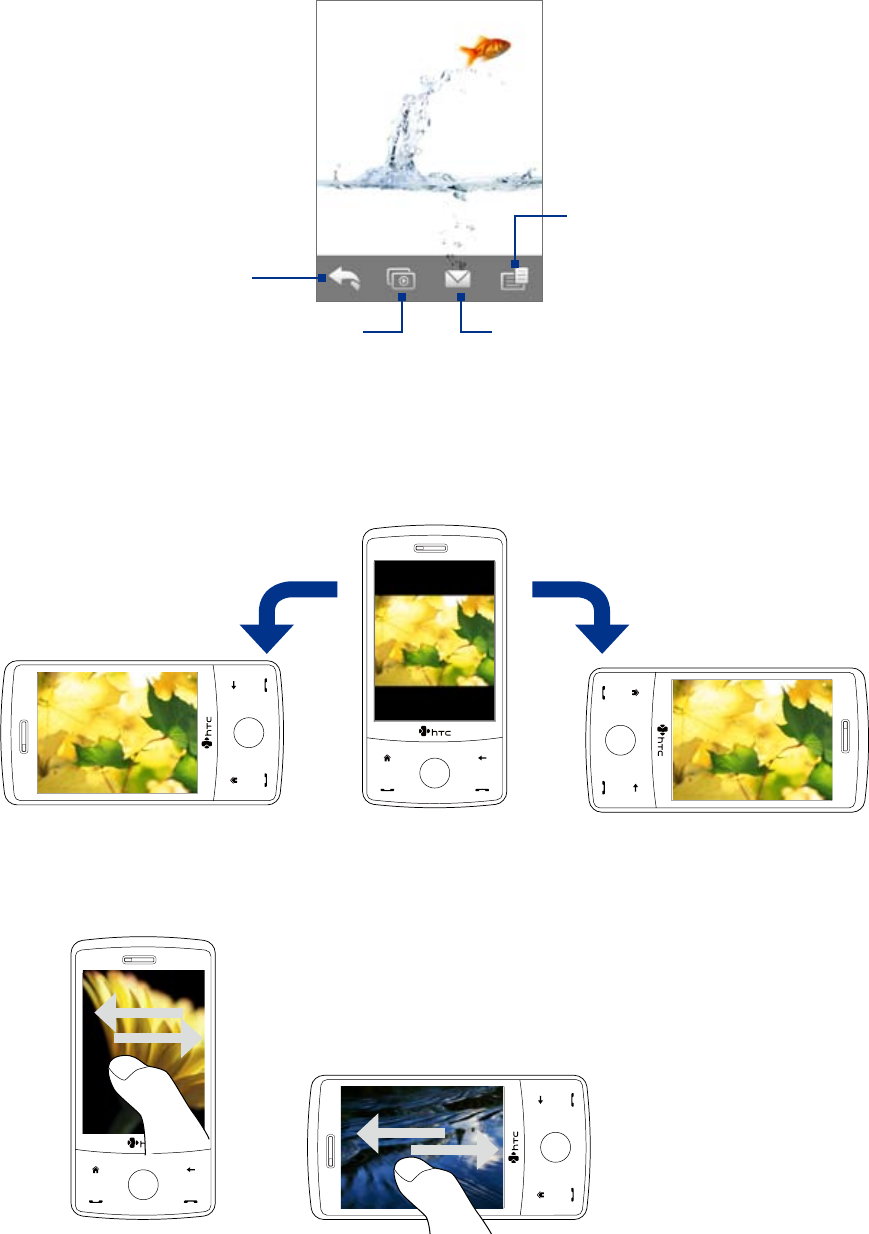
Experiencing Multimedia 113
View an image
While viewing an image in full screen, tap the screen or press ENTER to open the on-screen menu.
Tap to go back to the main
Album screen, Photos and
Videos tab, or Camera.
Tap to start the slideshow. Tap to send the image using one
of the Messaging accounts.
Tap to open a menu where you can
save the screen image as a photo for
a contact, save the current image as a
new file, delete the image, and view
file properties.
Tip You can delete multiple files at once by selecting Menu > Delete Items on the main Album screen and then
selecting the files to delete.
To rotate the image
While viewing images, you can automatically rotate the image by simply turning your device sideways.
To view the next or previous image
When viewing images in Portrait or Landscape mode, go to the next image by swiping your finger across the
screen from right to left. Go back to the previous image by swiping your finger from left to right.
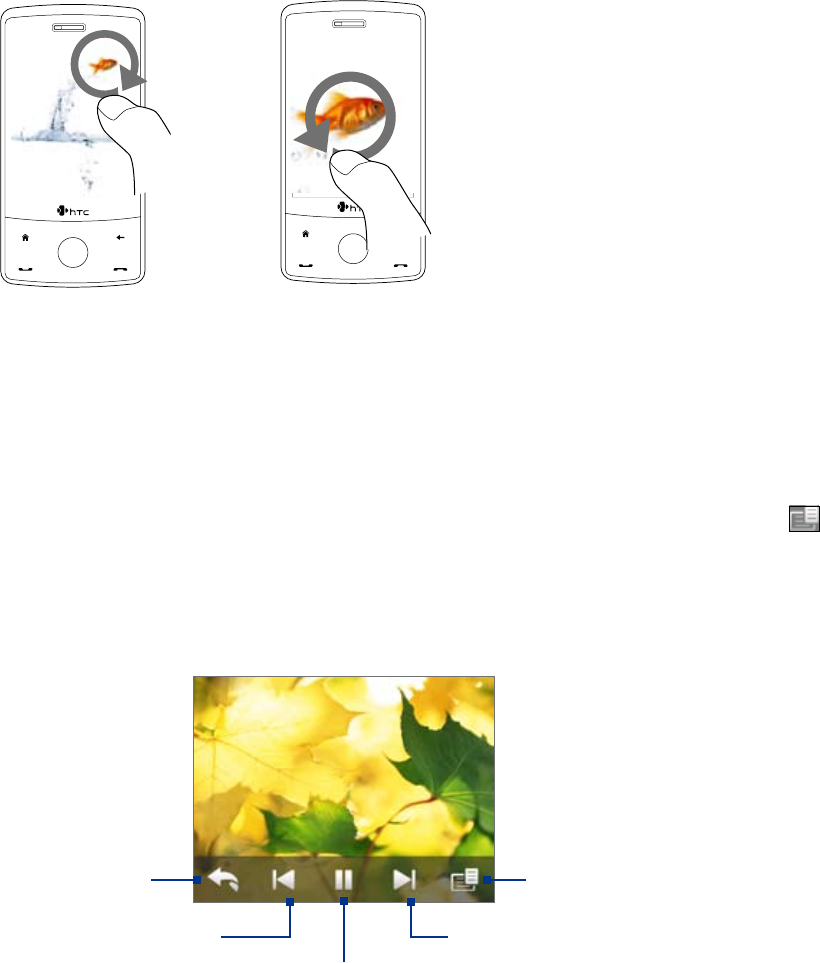
114 Experiencing Multimedia
To zoom in or out of an image
While viewing an image, make a full circle motion on the screen with your finger.
Slide your finger clockwise on
an area to zoom in on that area.
Slide your finger counter-clockwise
to zoom out.
Tips • When you zoom in on an image, double tap the screen to automatically zoom out and fit the image to the
screen.
• When you zoom in on an image, tap and hold the screen so you can pan the image.
• You can also zoom in and out of the image by sliding your finger around the Navigation Control clockwise/
counterclockwise.
• When you zoom in on an image, tap the screen to open the on-screen menu. On the on-screen menu, tap
and then select Save Screen Image to save the image on-screen as a new file.
To view still images as a slideshow
While viewing the slideshow, tap the screen to show playback controls.
Tip The screen orientation automatically switches to landscape mode when viewing a slideshow.
Tap to go back to the
previous image.
Tap to open the slideshow
options where you can
set the transition effect
to use, time per slide, and
orientation of the images.
Tap to return to the main
Album screen or the Photos
and Videos tab.
Tap to play or pause the
slideshow playback.
Tap to go to the
next image.
Tip If the images are in your favorite album, you can start the slideshow from the Photos and Videos tab on the Home
screen. On the Photos and Video tab, tap Slideshow.
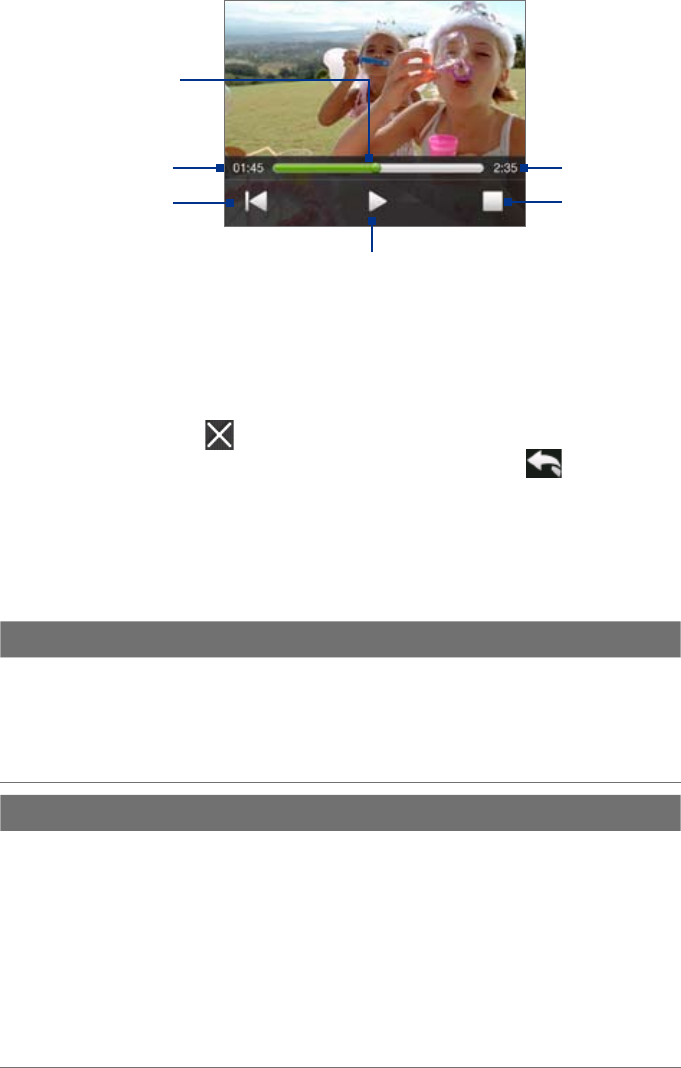
Experiencing Multimedia 115
Play back video
While playing back video, tap the screen to show the playback controls.
Tap to go back to the
beginning of the video.
Tap to play or pause
video playback.
Tap to stop video playback.
Drag to go forward or
backward in the video.
Elapsed time Total duration
Tip If the video is in your favorite album, you can start the video playback from the Photos and Videos tab on the
Home screen. On the Photos and Video tab, tap Play.
Close Album
Close Album by tapping on the main Album screen. When viewing files in full screen mode, tap the screen
to show the on-screen menu or playback controls and then tap to go back to the main Album screen.
11.3 Using Windows Media® Player Mobile
Windows Media® Player Mobile plays digital audio and video files that are stored on your device or on a
network, such as on a Web site.
Video File Formats Supported File Extensions
Windows Media Video
MPEG4 Simple Profile
H.263
H.264
Motion JPEG
.wmv, .asf
.mp4
.3gp, .3g2
.mp4, .3gp, .3g2, .m4v
.avi
Audio File Formats Supported File Extensions
Windows Media Audio
WAVE
MP3
MIDI and SP MIDI
AMR Narrow Band
AMR Wide Band
AAC, AAC+, and eAAC+
MPEG4 audio
QCELP
EVRC
.wma
.wav
.mp3
.mid, .midi, .rmi
.amr, .3gp
.awb,.3gp
.aac, .mp4, .m4a, .3gp
.m4a
.qcp, .3g2
.qcp
To open Windows Media® Player Mobile
Tap Start > Programs > Windows Media.
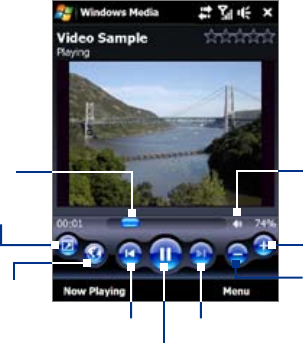
116 Experiencing Multimedia
About the controls
Play/Pause
Full screen
Visit WindowsMedia.com
Tap and drag to jump to
any part of the video or
audio
Skip to the beginning of
the current file or to the
previous file
Skip to the next file
Mute/Unmute
Increase volume
Decrease volume
About the screens and menus
Windows Media® Player Mobile has three primary screens:
Playback screen. The screen that displays the playback controls (such as Play, Pause, Next, Previous,
and Volume) and the video window. You can change the appearance of this screen by choosing a
different skin.
Now Playing screen. The screen that displays the Now Playing playlist. This special playlist indicates the
current file being played and any files that are “queued up” to play next.
Library screen. The screen that lets you quickly find your audio files, video files, and playlists. It contains
categories such as My Music, My Videos, My TV, and My Playlists.
At the bottom of each screen, you can open a Menu. The commands on this menu vary, depending on which
screen you are viewing. For more information about the commands in these menus, see Help on your device.
Synchronize video and audio files
Use the latest version of Windows Media® Player on your computer to synchronize digital media files from
your computer to your device. This ensures that protected files and album art (for skins) are copied to your
device correctly.
To synchronize content to your device automatically
1. On your computer, open Windows Media® Player, then connect your device to your computer.
2. In the Device Setup Wizard, select Yes, search my computer now.
Note If you have previously opened Windows Media® Player and searched for media on your computer, you
will not be prompted to search your computer in Step 2.
3. On the Device Setup dialog box, enter a name for your device and click Finish. Windows Media starts
synchronizing the music files in the PC with the device.
4. Click Stop Sync and then on the left panel of Windows Media® Player, right-click the name of your
device and click Set Up Sync.
5. Select the playlist(s) that you want to sync between your computer and device, then click Add.
Note On the Device Setup dialog box, make sure that the Sync this device automatically check box is
selected.
6. Click Finish.
The files will begin synchronizing to your device. The next time you connect your device to your computer
while Windows Media® Player is running, synchronization will start automatically.
•
•
•
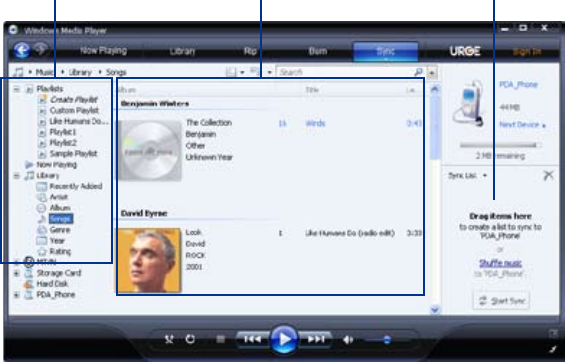
Experiencing Multimedia 117
To synchronize content manually to your device
1. If you have not set up media synchronization between your device and computer, follow steps 1 to 3 in
“To synchronize content to your device automatically”.
2. Click the Sync tab on the Windows Media® Player of your computer. Select a Playlist or a Library on the
left panel of the Windows Media® Player.
3. From the Content List, drag the media files that you want to sync to your device and drop them to the
Sync List.
Playlists and Library List Sync ListContent List
4. Click Start Sync to start synchronizing the selected files to your device.
Notes • Use Windows Media® Player 11 or higher on your computer to synchronize media files to your device.
• Audio files copy faster if Windows Media® Player is configured to automatically set the quality level for audio files
copied to your device. For more information, see the Windows Media® Player Help.
Play media
Use the Library to find and play songs, videos, and playlists that are stored on your device or internal storage.
To update the Library
1. If you are not on the Library screen, tap Menu > Library.
2. On the Library screen, tap the Library arrow (near the top of the screen), then tap the media storage
that you want use, for example, internal storage.
3. In most cases, Windows Media® Player Mobile automatically updates the library. However, you can
manually update the library to ensure that it contains new files that you recently copied to your device
or internal storage. Tap Menu > Update Library to manually update the library list.
To play video and audio files on your device
1. Select a category (for example, My Music or My Playlists).
2. Tap and hold the item that you want to play (such as a song, album, or artist name), then tap Play.
Tips • To play a media file that is stored on your device but is not in a library, on the Library screen, tap Menu > Open
File. Tap and hold the item that you want to play (such as a file or a folder), then tap Play.
• To play a media file from the Internet or a network server, tap Menu > Library then tap Menu > Open URL.
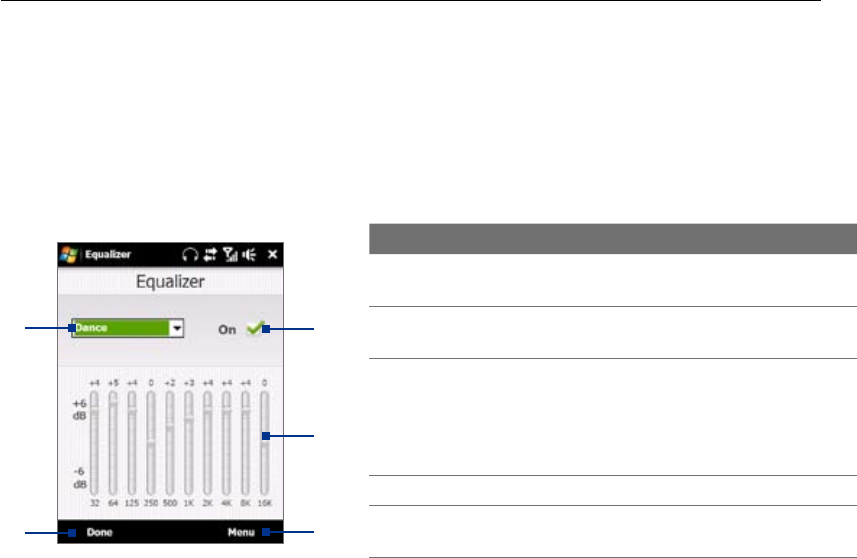
118 Experiencing Multimedia
Playlists
In Windows Media® Player Mobile, you can create a new playlist by saving the current Now Playing playlist and
giving it a new name.
To save a new playlist
1. If you are not on the Library screen, tap Menu > Library.
2. Tap to select a category (for example, My Music or My Playlists).
3. Select a media file that you want, then tap Menu > Queue Up. This adds the file to the Now Playing list.
Repeat this step until you have added all desired media files to the Now Playing list.
Note You cannot select multiple files simultaneously.
4. After adding the media files, tap Menu > Now Playing.
5. On the Now Playing screen, tap Menu > Save Playlist.
6. Enter the playlist name, then tap Done.
7. To play back the playlist you created, tap My Playlists in the Library, select your playlist, then tap Play.
Troubleshooting
If you encounter a problem while using the Windows Media® Player Mobile, a number of resources are
available to help you troubleshoot the issue.
For more information, see the Troubleshooting Windows Media® Player Mobile page at the Microsoft Web site
(http://www.microsoft.com/windows/windowsmedia/player/windowsmobile/troubleshooting.aspx).
11.4 Using Audio Booster
Audio Booster optimizes sound for a better listening experience. It provides preset moods, such as hip hop,
jazz, rock, etc., and several enhancement presets that suit different types of music.
To access Audio Booster
Tap Start > Programs > Audio Booster.
This control Does this
1On Select the check box to enable or disable
the equalizer.
2Frequency
band
Drag the sliders to adjust the frequency.
3Menu • Tap Menu > Cancel to exit Audio Booster
without applying the modified settings:
• Tap Menu > Save as Preset or Delete
Preset to save or delete preset equalizer
settings.
4Done Tap to apply the modified settings.
5Equalizer
presets
Tap to choose the Equalizer preset to use.
5
4
1
2
3
To use a Equalizer preset
Tap the list box then select a desired preset.
To create a custom equalizer preset
1. Adjust the frequency bands to your desired values by dragging the equalizer controls. The selected
values are indicated on top of the sliders.
2. Save your equalizer settings as a preset by tapping Menu > Save as Preset.
3. Enter a preset name and then tap Done. The preset you created will be added to the list box.
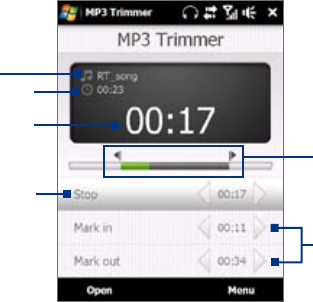
Experiencing Multimedia 119
To delete a custom equalizer preset
1. Tap the list box then select the Equalizer preset you want to delete.
2. Tap Menu > Delete Preset.
Note You can only delete custom equalizer presets. Equalizer presets that are pre-installed cannot be deleted.
11.5 Using MP3 Trimmer
Use MP3 Trimmer to trim MP3 files. You can choose to save it as a new file or set it as a ring tone.
Play/Stop
Mark in / Mark out points
Mark the part of the music that will be used as
the ring tone. Drag the left handle to mark the
start time (mark-in point), then drag the right
handle to mark the end time (mark-out point).
Mark in / Mark out
For more precise marking, you can also tap
these controls to step backward/forward
one step and mark it.
Title
Duration
Playback
time
To trim the MP3 file
1. Tap Start > Programs > MP3 Trimmer.
2. Tap Open to find the MP3 file in the device.
3. On the MP3 Trimmer screen, use the stylus to adjust the Mark in point and Mark out point.
After you set the Mark in point, the song will play back starting from the Mark in point.
After you set the Mark out point, the song will play back starting from 5 seconds before the Mark out
point.
4. Tap Play to play back the trimmed song.
5. Tap Menu and select to whether set the file as the default ring tone, save the file to the ring tone folder,
or save it using another file name.
Tip If you only want to save the song to the ring tone folder for future use, tap Save to Ring Tone Folder. Later on, you
can tap Start > Settings > Personal tab > Phone to set it as your ring tone.
120 Experiencing Multimedia

Chapter 12
Programs on your Device
12.1 Programs on your Device
12.2 Adding and Removing Programs
12.3 Adobe® Reader® LE
12.4 Calendar
12.5 Contacts
12.6 Comm Manager
12.7 Microsoft® Office Mobile
12.8 Notes
12.9 Tasks
12.10 Voice Recorder
12.11 ZIP
12.12 Sprite Backup
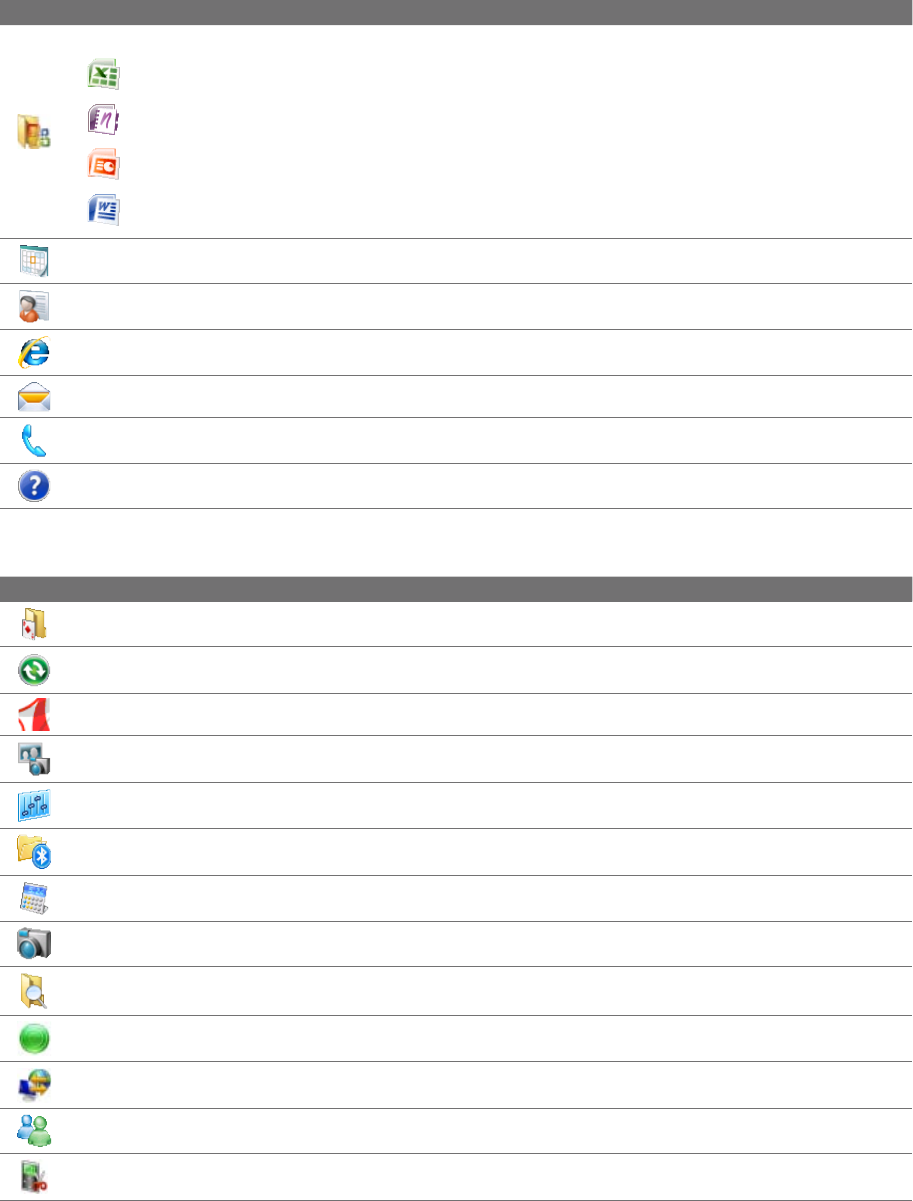
122 Programs on your Device
12.1 Programs on your Device
The following are programs you can find on your device or install from the Applications disc.
Programs in the Start Menu
Icon Description
Office Mobile Use the complete suite of Microsoft® Office applications for your mobile device.
Excel Mobile Create new workbooks or view and edit Excel workbooks.
OneNote Mobile Create notes with text, photos, and voice recordings.
PowerPoint Mobile View PowerPoint slides and presentations.
Word Mobile Create, view, and edit Word documents.
Calendar Keep track of your appointments and create meeting requests.
Contacts Keep track of your friends and colleagues.
Internet Explorer Mobile Browse Web and WAP sites as well as download new programs and files from the
Internet.
Messaging Send and receive e-mail and text messages.
Phone Make and receive calls, switch between calls, and set up conference calling. See Chapter 2 for details.
Help See Help topics for the current screen or program.
Programs screen
Icon Description
Games Play these pre-installed games: Bubble Breaker, Teeter and Solitaire.
ActiveSync Synchronize information between your device and a PC or the Exchange Server. See Chapter 5
and 7 for details.
Adobe Reader LE View PDF (Portable Document Format) files on your device.
Album View photos and videos that you captured using the device camera. See Chapter 11 for details.
Audio Booster Enhances your music experience by providing you with controls for adjusting equalizer, 3D
sound, treble, and bass settings. See Chapter 11 for details.
Bluetooth Explorer Search for other Bluetooth devices that have file sharing enabled and access their
Bluetooth shared folder. See Chapter 9 for details.
Calculator Perform basic arithmetic and calculations, such as addition, subtraction, multiplication, and
division.
Camera Take photos and shoot video clips with accompanying audio. See Chapter 11 for details.
File Explorer Organize and manage files on your device.
Getting Started View a list of “how to’s” that you can reference to learn basic features and settings of your
device.
Internet Sharing Connect your notebook computer to the Internet using your device's data connection. See
Chapter 8 for details.
Messenger This is the mobile version of Windows Live™ Messenger. See Chapter 8 for details.
MP3 Trimmer Trim MP3 files, and choose to save the trimmed music as a new file or set it as a ring tone. See
Chapter 11 for details.
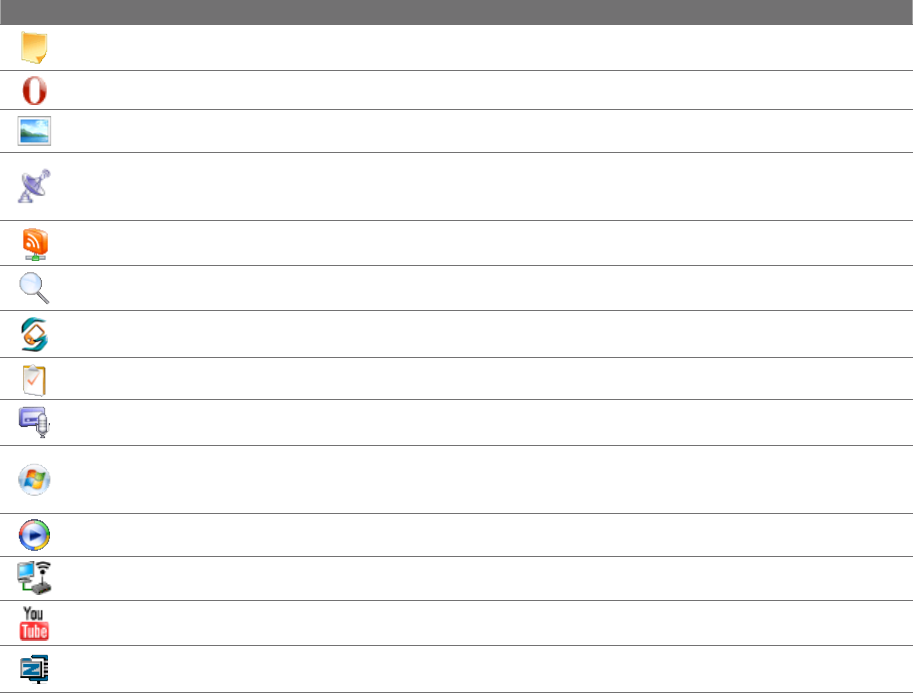
Programs on your Device 123
Icon Description
Notes Create handwritten or typed notes, drawings, and voice recordings.
Opera Mobile This is the mobile version of the Opera browser. See Chapter 8 for details.
Pictures & Videos View, organize, and sort pictures, animated GIFs, and video files on your device.
QuickGPS Download satellite data over the Internet via ActiveSync (if your device is connected to a
computer), Wi-Fi or a data connection to speed up the time for determining your current GPS position. See
Chapter 10 for details.
RSS Hub Download and read the latest Web feeds from the Internet. See Chapter 8 for details.
Search Search contacts, data, and other information on your device.
Sprite Backup Back up your device’s data and files to a specified folder, the internal storage, or a computer.
You can install this program from the Applications disc.
Tasks Keep track of your tasks.
Voice Recorder Record your voice and send it via e-mail or beaming. You can also set the recorded voice as
your ring tone.
Windows Live Use this mobile version of Windows Live™ to find information on the Web. It also lets you sign
into your Windows Live account so that you can access your Live Mail messages and send/receive instant
messages in Live Messenger. See Chapter 8 for details.
Windows Media Player Mobile Play back audio and video files. See Chapter 11 for details.
WModem Connect your notebook computer to the Internet using your device’s data connection.
YouTube™ Search for uploaded videos in YouTube and play them on your device. See Chapter 8 for details.
ZIP Save memory and free up storage space on your device by compressing files in the conventional ZIP
format.
12.2 Adding and Removing Programs
Additional programs, such as the programs in the Applications disc or other programs that you purchase,
can be installed and uninstalled on your device. Your device does not allow you to uninstall most of the
preinstalled programs.
Note Before you purchase additional programs for your device, make sure that they are compatible with your device.
To install a program
1. Download the program to your computer (or insert the CD or disk that contains the program into your
computer).
You may see a single *.exe file, a *.zip file, a Setup.exe file, or several versions of files for different
device types and processors. Be sure to select only the programs designed for your device.
2. Read any installation instructions or documentation that comes with the program. Many programs
provide special installation instructions.
3. Connect your device to the computer.
4. Double-click the installation setup file.
To uninstall a program
1. Tap Start > Settings > System tab > Remove Programs.
2. In the Programs in storage memory list, select the program you want to remove, then tap Remove.

124 Programs on your Device
12.3 Adobe® Reader® LE
Adobe® Reader® LE is an application for viewing PDF (Portable Document Format) documents on your
device. It supports a subset of the features found in the PC versions of Adobe Reader.
To open Adobe Reader LE
Tap Start > Programs > Adobe Reader LE.
To open a PDF file on your device
Open a PDF file in Adobe Reader LE; or
Open File Explorer, find the PDF file, then tap the file to open it.
To navigate through a PDF document
You can use the controls in the program and finger gestures to navigate a PDF document.
Tap Tools > View > Continuous and then slide your finger up or down the screen to scroll through the
pages in the document.
Tip You can also drag the scroll bars to scroll through the pages.
Tap to zoom in or to zoom out. After zooming in, slide your finger on the screen to pan the
current page.
Press Navigation up/down/right/left to move to the desired direction of the page.
Tap to return to the previous page; tap to move to the next page. Tap to jump to the first page;
tap to jump to the last page.
Tap Tools > Go To > Page Number to enter a page number that you want to view.
To search for text in the document
1. Tap Tools > Find > Text or tap in the toolbar.
2. Type in the text to be searched, then tap Find. The matched text in the document will be highlighted.
3. To view the next occurrence of the text, tap Tools > Find > Next.
Tips • Adobe Reader LE displays a bookmark pane for the PDF files that contain bookmarks. Tap the bookmarks to go
to a specific section/page within the file.
• Adobe Reader LE supports password-protected PDF files with up to 128-bit encryption. When you open a
password-protected PDF file, you will be prompted to enter the password before opening it.
12.4 Calendar
Use Calendar to create appointments, including meetings and other events. You can also synchronize
Calendar appointments between your device and computer.
To open the Calendar screen
On the TouchFLO 3D Home screen, tap Calendar or a displayed appointment; or
Tap Start > Calendar.
Create appointments
To schedule an appointment
1. Open the Calendar screen and then tap Menu > New Appointment.
2. Enter a name for the appointment.
3. Do one of the following:
If it is a special occasion such as a birthday or a whole-day event, set the All Day option to Yes.
If there is a time frame for the appointment, set the start and end dates and times.
4. Specify the type of category for your appointment, so that it can be grouped with other related
appointments. Tap Categories, then select a preset category (Business, Holiday, Personal, or Seasonal),
or tap New to create your own category.
•
•
•
•
•
•
•
•
•
•
•
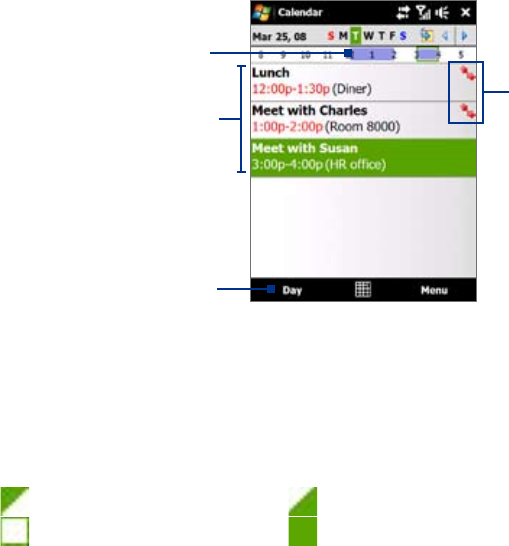
Programs on your Device 125
5. When finished, tap OK to return to the calendar.
Notes • All-day events do not occupy blocks of time in Calendar; instead, they appear in banners at the top of the
calendar.
• To remove an appointment, tap Menu > Delete Appointment.
Tip To have the time entered automatically in Day view, tap and drag to select a time slot for the new appointment,
and tap Menu > New Appointment.
To set the reminder time for new appointments
By default, Calendar has been set to display a reminder alert when you have new upcoming appointments.
You can change the reminder time.
1. Open the Calendar screen.
2. Tap Menu > Tools > Options > Appointments tab.
3. Make sure the Set reminders for new items check box is selected.
4. Set the time when you want the reminder to alert you.
5. Tap OK to return to the Calendar screen.
View appointments
By default, Calendar displays appointments in Agenda view. You can also look at your appointments in Day,
Week, Month, and Year views.
The highlighted hours
here indicate the time of
your appointments.
Tap to view appointment details.
Agenda view
Tap to switch views.
The red box and arrows indicate that
there are conflicting appointments.
To see detailed appointment information in any view, tap the appointment.
To view appointments by category, tap Menu > Filter, then select the desired category.
To change the default view that Calendar uses to display appointments, tap Menu > Tools > Options >
General tab. Tap the Start in box, then choose the calendar view.
When in Month view, you will see the following indicators:
Morning appointment Afternoon or evening appointment
All-day event Both morning and afternoon/evening appointments
Send appointments
To send a meeting request
Use Calendar to schedule meetings via e-mail with contacts who use Outlook or Outlook Mobile.
1. Open the Calendar screen.
2. Schedule a new appointment, or open an existing one and tap Menu > Edit.
3. Tap Attendees, then tap Add Required Attendee or Add Optional Attendee and add the contacts
whom you want to invite.
Note You can specify if an attendee is required or optional only if your device is connected to a Microsoft
Exchange 2007 server. Otherwise, all attendees are designated as required. For more information, see
“Managing Meeting Requests” in Chapter 7.
•
•
•
•
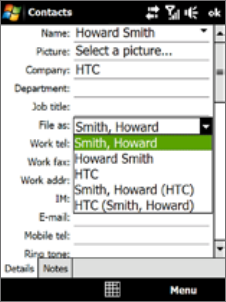
126 Programs on your Device
4. When you have finished adding attendees, tap Done.
5. Tap OK to send.
Tip To choose the e-mail account to use for sending meeting requests, tap Menu > Tools > Options > Appointments
tab. Tap the Send meeting requests via box and choose to send via your Outlook E-mail, POP3/IMAP4 or
Windows Live™ account.
Notes • If you’re sending the meeting request using your Outlook E-mail account, it will be sent to the attendees the next
time you synchronize your device with your computer or Exchange Server.
• When attendees accept your meeting request, the meeting is automatically added to their schedules. When their
response is sent back to you, your calendar is updated as well.
12.5 Contacts
Contacts is your address book and information storage for people and businesses you communicate with.
You can add the following types of contacts to your device:
Outlook contacts. Contacts that are stored on your device, which can be created on your device or
synchronized with your PC or the Exchange Server.
Windows Live™ contacts. Contacts that you communicate with using Windows Live™ Messenger or MSN.
Note You can only add Windows Live™ contacts after you have set up Windows Live™ on your device. See “Add Windows
Live contacts” in Chapter 8 for details.
To open the Contacts screen
On the TouchFLO 3D Home screen, slide to the People tab and then tap All People; or
Tap Start > Contacts.
Add new contacts
To add a contact on your device
1. Open the Contacts screen.
2. Tap New, select Outlook Contact, and enter the contact information.
3. In the File as field, choose how you want the contact name to appear
in the contact list.
4. To add a photo of the contact, tap Select a picture, and then select
the picture file or tap Camera to take a photo of the contact.
5. To assign a ring tone to the contact, tap the Ring tone field, scroll
through the list of tones, then select a desired tone.
6. When finished, tap OK.
Tips • If a person who is not in your list of contacts called you and you want to save that person’s phone number, tap
and hold the phone number in the Call History and then tap Save to Contacts from the shortcut menu.
• To save a phone number that is contained in a message, open the message, tap the underlined phone number,
and then tap Menu > Save to Contacts.
• To edit contact information, tap the contact name and then tap Menu > Edit.
•
•
•
•
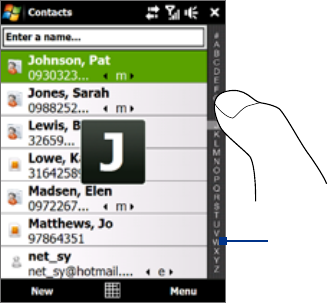
Programs on your Device 127
Organize and search contacts
To group similar contacts
For easier management, you can group similar contacts by assigning them to categories.
1. Create a new Outlook contact or edit an existing Outlook contact.
2. Tap Categories.
3. Select a preset category such as Business or Personal, or tap New to create your own category.
4. When finished, tap OK.
To find a contact on your device
There are several ways to find a contact when your contact list is long:
Begin entering a contact name in the provided text box until the contact you want is displayed.
On the Quick Scroll bar on the right of the Contacts screen, scroll to or tap a letter to go directly to the
part of the contacts list where contact names start with that letter.
Quick Scroll bar
Note You can disable the Quick Scroll bar by tapping Menu > Options and selecting the Show alphabetical
index check box. This will show the alphabetical index at the top of the Contacts list.
Filter the list by categories. In the contact list, tap Menu > Filter, then tap a category you’ve assigned to
a contact. To show all contacts again, select Menu > Filter > All Contacts.
Share contact information
To beam a contact’s details
You can quickly send contact information to another mobile phone or device through Bluetooth beaming.
1. On the Contacts screen, select a contact.
2. Tap Menu > Send Contact > Beam, then select a device where to beam the contact to.
Note Before beaming, make sure Bluetooth is turned on and set to visible mode on your device and the target mobile
device. You can also beam contact information to your computer. See Chapter 9 for details.
•
•
•
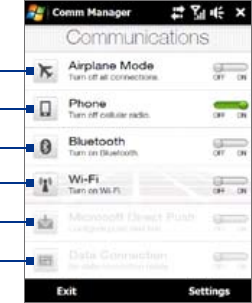
128 Programs on your Device
12.6 Comm Manager
Comm Manager is a central location where you can easily turn on and off the communication features of
your device such as the phone, Wi-Fi, data connection, Bluetooth, and more.
To access the Comm Manager
Do one of the following:
On the TouchFLO 3D Home screen, slide to the Settings tab and then touch Communications.
Touch Start > Settings > Connections tab > Comm Manager.
1
2
3
4
5
6
1Switch Airplane Mode on or off. Turning on Airplane Mode turns off the phone, Wi-Fi and Bluetooth
functions. For more information, see "To enable or disable Airplane Mode" in Chapter 2.
2Switch the phone on or off. Tap Settings > Phone to set the ring tone and other phone settings.
See Chapter 13 for details.
3Switch Bluetooth on or off. Tap Settings > Bluetooth to configure Bluetooth on your device.
See Chapter 9 for details.
4Switch Wi-Fi on or off. Tap Settings > Wireless LAN to configure wireless network connection
settings. See Chapter 8 for details.
5Switch between automatically receiving (as items arrive) or manually retrieving Outlook e-mails.
See Chapter 7 for details.
6Disconnect active data connections. You cannot reconnect a data connection in Comm Manager.
12.7 Microsoft® Office Mobile
Microsoft® Office Mobile consists of the following applications:
Microsoft® Office Excel® Mobile lets you create and edit Excel workbooks and templates on your
device.
Microsoft® Office OneNote® Mobile lets you create notes with text, photos, and voice recordings for
synchronization later with Microsoft® Office OneNote® 2007 on your computer.
Microsoft® Office PowerPoint® Mobile allows you to view (not create) slide show presentations in
*.ppt and *.pps formats.
Microsoft® Office Word Mobile lets you create and edit documents and templates in Word Mobile and
save them as *.doc, *.rtf, *.txt, and *.dot files.
To use Microsoft Office Mobile
1. Tap Start > Office Mobile.
2. Tap the Office Mobile application that you want to use.
•
•
•
•
•
•
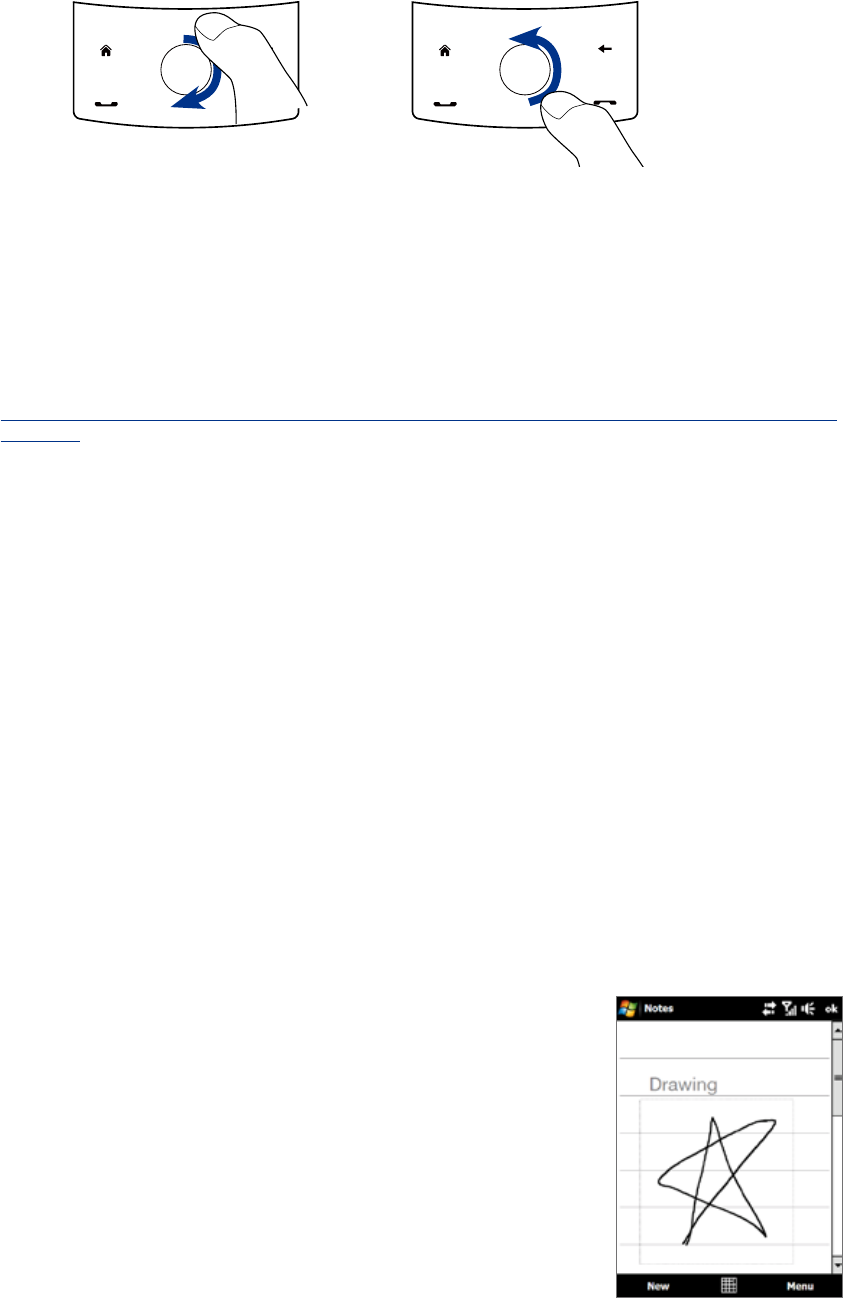
Programs on your Device 129
When working with Word Mobile and Excel Mobile files, you can use the Navigation Control on your device for
zooming:
To zoom in, slide your finger
clockwise around the Navigation
Control.
To zoom out,
slide your finger
counterclockwise around the
Navigation Control.
Word Mobile and Excel Mobile do not fully support some features of Microsoft® Office Word and Microsoft®
Office Excel®. To see a complete list of features that are not supported in Word Mobile and Excel Mobile, see
Help on your device.
Tips • By default, Word Mobile saves documents in .docx format, while Excel Mobile saves workbooks in .xlsx format.
If you want to open these types of files on a computer that uses Microsoft Office 2000, Office XP, or Office 2003,
you need to download and install the File Format Converter in your computer. You can find this converter at
http://www.microsoft.com/downloads/details.aspx?FamilyId=941B3470-3AE9-4AEE-8F43-C6BB74CD1466&displ
aylang=en.
• If you want Word Mobile to save documents in .doc format, tap Menu > Tools > Options (or Menu > Options
when no document is opened), then change the Default template to Word 97-2003 Document (.doc).
• If you want Excel Mobile to save workbooks in a format that is compatible with Microsoft Office 2000, Office XP,
or Office 2003, tap Menu > Options (with no workbook opened), then change the Template for new workbook
to Blank 97-2003 Workbook.
12.8 Notes
Using Notes, you can create handwritten and typed notes, record voice notes, convert handwritten notes to
text for easy readability, and more.
To create a note
1. Tap Start > Programs > Notes. In the note list, tap New.
2. Choose an input method and then enter your text.
Tip For more information about input methods and entering text, see Chapter 4.
3. When finished, tap OK to save and return to the note list.
Notes • To select handwritten text, tap and hold next to the writing. As soon as dots appear, and before they form a
complete circle, quickly drag across the writing.
• If a letter crosses three ruled lines, it is treated as a drawing rather than text.
To draw in a note
1. Create or open a note file.
2. Use the stylus to draw on the screen. A selection box then appears
around your drawing.
3. Tap OK to save.
Note To select a drawing (for example, to copy or delete it), tap and hold the drawing
briefly. When you lift the stylus, the drawing is selected.

130 Programs on your Device
To record a voice note
You can create a stand-alone recording (voice note) or you can add a recording to a note.
1. Tap Start > Programs > Notes.
2. If you do not see the Recording toolbar, tap Menu > View Recording Toolbar.
3. Do one of the following:
To add a recording to a note, create or open a note.
To create a stand-alone recording, record from the note list.
4. Tap the Record icon ( ) to begin recording your voice. Tap the Stop icon ( ) when you are
finished recording.
Tip
To select the voice recording format, return to the note list and then tap Menu > Options > Global Input Options
link (at the bottom of the Options screen). On the Input screen, tap the Options tab and choose the desired format
from the Voice recording format list.
12.9 Tasks
Use Tasks to keep track of things you need to do. A task can occur once or repeatedly (recurring).
Your tasks are displayed in a task list. Overdue tasks are displayed in red. A reminder will be displayed when
you have new tasks to be completed.
To create a task
1. Tap Start > Programs > Tasks.
2. Tap Menu > New Task, enter a subject for the task, and fill in information such as start and due dates,
priority, and so on.
3. Specify the type of category for your task, so that it can be grouped with other related tasks. Tap
Categories, then select a preset category (Business, Holiday, Personal, or Seasonal), or tap New to
create your own category.
4. When finished, tap OK.
To change the priority of a task
Before you can sort tasks by priority, you need to specify a priority level for each task.
1. Tap Start > Programs > Tasks.
2. Tap the task you want to change the priority for.
3. Tap Edit, and tap a priority level in the Priority box.
4. Tap OK to return to the task list.
Note All new tasks are assigned a Normal priority by default.
To show start and due dates in the task list
1. Tap Start > Programs > Tasks.
2. Tap Menu > Options.
3. Select the Show start and due dates check box, then tap OK.
•
•
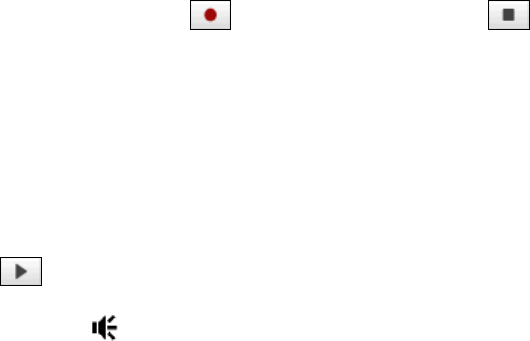
Programs on your Device 131
12.10 Voice Recorder
Voice Recorder lets you record your voice and quickly send it as e-mail attachment, beam it via Bluetooth, or
set the recorded voice as your ring tone.
Note
Voice Recorder saves voice recordings in AMR-NB (Adaptive Multi-Rate Narrowband) format only. This is a common
speech audio format used in mobile devices.
To record your voice
1. Tap Start > Programs > Voice Recorder.
2. Hold the device’s microphone close to your mouth.
3. Touch Record or to start recording. Tap Stop or to end the recording.
To select or create a folder where to save voice recordings
By default, all recordings are saved in the My Voices folder of the internal storage. You can choose another
folder or create a new folder to save your voice recordings.
1. Tap the arrow beside the folder name on the top-left of the screen.
2. In the menu that opens, choose an existing folder or touch Add/Delete to create a new folder.
To play back a voice recording
On the Voice Recorder screen, touch a voice recording, or navigate to a voice recording and then tap Play
( ).
Tip If you need to adjust the sound volume, touch any of the status icons on the title bar and then touch the Volume
icon ( ) to open the System Volume screen where you can adjust the volume.
To send a voice recording via e-mail
Select a voice recording, tap Menu > Send, and then select an e-mail account. This creates a new e-mail
message with the voice recording inserted as a file attachment.
See “Using E-mail” in Chapter 6 to learn how to send e-mails.
To beam a voice recording via Bluetooth
1. Select the voice recording you want to beam, then tap Menu > Beam File.
Tip To select multiple recordings, tap and drag over the desired recordings or tap Menu > Select All.
2. Tap the device you want to send the voice recording to.
3. On the other device, accept the file transfer to receive the file.
To set a voice recording as ring tone
Select the voice recording, then tap Menu > Set as Ringtone.
To rename or move a recording
1. Select the voice recording, then tap Menu > Rename/Move.
Tip To select multiple recordings, tap and drag over the desired recordings or tap Menu > Select All. Note
that you can move multiple files, but you cannot rename multiple files simultaneously.
2. In Name, enter the new voice recording name.
3. To move the voice recording, select the new destination Folder and Location.
4. Tap OK.
132 Programs on your Device
12.11 ZIP
The ZIP program increases the storage capacity of your device by allowing you to compress files in the
conventional ZIP format. It also allows you to extract files from a zip file.
To start ZIP on your device
Tap Start > Programs > ZIP.
Each time you start ZIP, it searches for files that have the .zip file extension, and displays these files on the
Archive List screen.
To open a ZIP file and extract files
1. Touch a zip file to open it, or navigate to a zip file and then touch File > Open Archive.
Note You cannot select multiple ZIP files.
2. From the zip file, select files by doing one of the following:
Touch a file to select it.
To select several files, touch Menu > Action and make sure Multi-Select Mode is selected. Select
files by touching each file. (Touch a selected file to deselect it).
To select all files, touch Menu > Action > Select All.
3. Touch Menu > Action > Extract.
4. Choose a folder where the files will be extracted to, then touch Extract.
5. Touch Menu > File > Close Archive to close the zip file.
To create a new zip archive
1. Touch File > New Archive.
2. On the Save As screen, enter the zip file name and choose a folder where you want to save it. You can
also choose whether to save the zip file on the device’s main memory or internal storage.
3. Touch Save.
4. Touch Menu > Action > Add.
5. Navigate to the folder that contains the files you want to archive.
6. Select files to add by doing one of the following:
Touch a file to select it.
To select several consecutive files, drag over the files.
To select several non-contiguous files, use the stylus to tap and hold on the screen and then select
Multi-Select Mode. Select files by tapping each file. (Tap a selected file to deselect it).
To select all files, use the stylus to tap and hold on the screen and then tap Select All.
7. Touch Add.
8. Touch Menu > File > Close Archive to save and close the zip file.
•
•
•
•
•
•
•
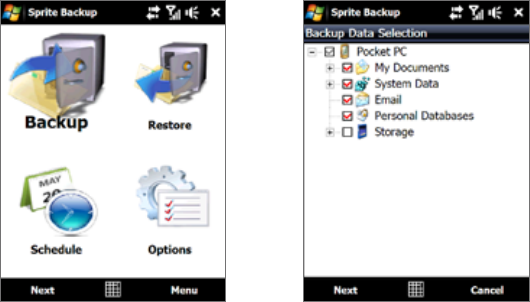
Programs on your Device 133
12.12 Sprite Backup
Use Sprite Backup to back up data, which includes settings, files, contacts, and all other information, to the
device memory, internal storage or a computer.
To install Sprite Backup
1. Make sure your device is connected to your computer via a USB cable.
2. Insert the Applications disc on your computer’s CD or DVD drive and start the Sprite Backup
installation.
3. Follow the on-screen instructions to install the Sprite Backup PC Manager to your computer and the
Sprite Backup program onto your device.
To open Sprite Backup
On your device, tap Start > Programs > Sprite Backup.
1. To back up data remotely to a computer, enable the PC backup feature first. See “To enable remote
backup to a computer” for instructions.
2. On the Sprite Backup main screen, tap Backup.
3. On the Backup Data Selection screen, you will see a tree view of the data and files on your device.
Tap “+” on the left of an item to view its sub-items. Use the check boxes to select or exclude items for
backup.
Main screen Backup Data Selection screen
4. After selecting data items, tap Next. The Save As screen then appears.
5. Enter a file name for the backup file.
6. In Location, choose whether to save the backup file to \Internal Storage, \My Documents on the
device memory, or to a PC.
Tip When backing up to the internal storage or to \My Documents on the device memory, you can also
choose a specific folder where to save the backup file.
7. Tap Next.
8. On the Device Reset Required screen, tap Next to start the backup.
Note Do not start and use any programs on your device until the backup process is completed.
To restore data
1. On the Sprite Backup main screen, tap Restore. Sprite Backup then searches for all available backup
files from the device memory and internal storage and then displays them on the Open File screen.
Tip To search for backup files created on your computer, connect your device to your computer and run
Sprite Backup PC Manager on your computer. In Sprite Backup’s Open File screen on your device, set
Location to PC.
2. Select the backup file you want to restore and then tap Next.
3. In the tree view, select the items you want to be restored to your device and then tap Next.
134 Programs on your Device
4. On the Device Reset Required screen, tap Next to begin restoring data.
Note Sprite Backup soft resets your device first before it begins the backup or restoration process. It soft resets again
after the operation is completed.
To enable remote backup to a computer
1. On the Sprite Backup main screen, tap Options > Networking > PC.
2. Select the Enable PC Backup check box and choose whether to do the remote backup to your
computer via ActiveSync or network.
For more information about using Sprite Backup, see Help on your device.
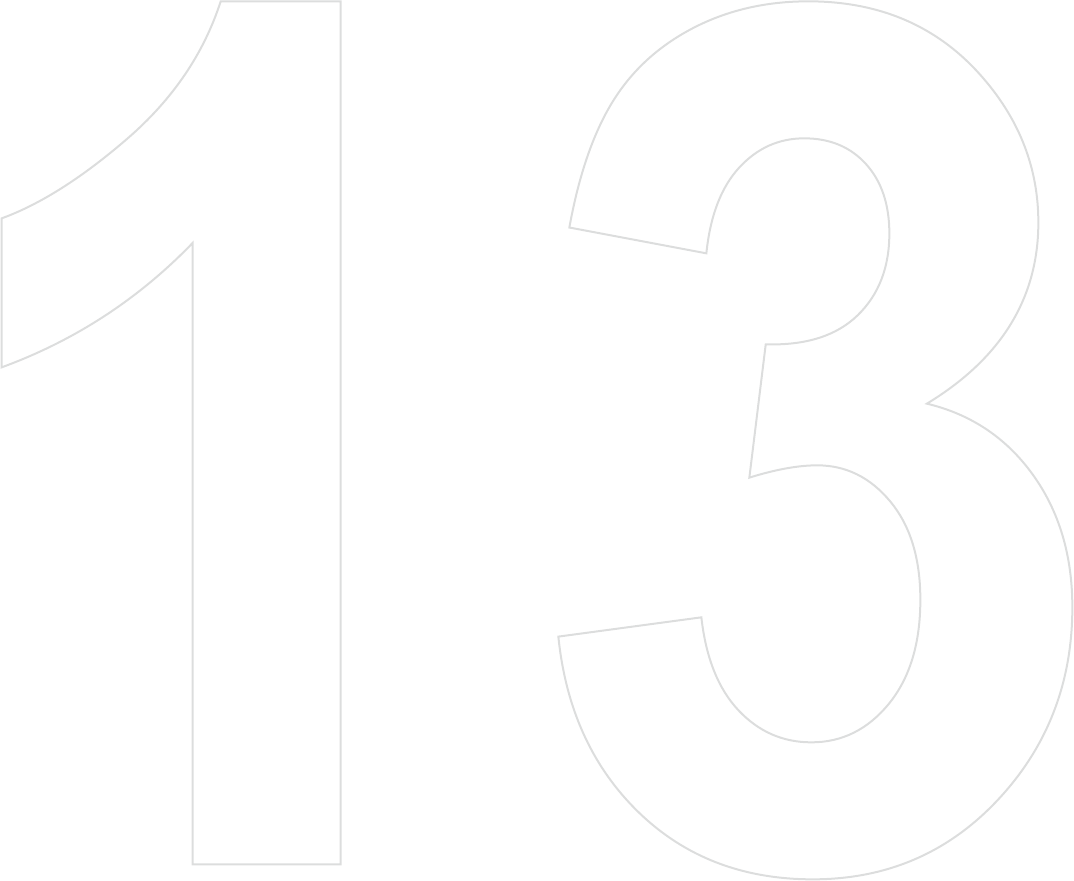
Chapter 13
Managing Your Device
13.1 Copying and Managing Files
13.2 Settings on your Device
13.3 Changing Basic Settings
13.4 Using Task Manager
13.5 Protecting Your Device
13.6 Managing Memory
13.7 Resetting Your Device
13.8 Windows Update
13.9 Battery Saving Tips

136 Managing Your Device
13.1 Copying and Managing Files
You can copy files between your device and computer, or copy files to the internal storage of your device. You
can also efficiently manage your files and folders using File Explorer.
To copy files using Windows Mobile Device Center or ActiveSync
1. Connect your device to the computer.
2. Click File Management > Browse the contents of your device in Windows Mobile Device Center on
your computer, or click Explore in ActiveSync on your computer. This opens Windows Explorer on your
computer and displays the contents of your device.
3. To copy a file from your device to your computer:
a. Browse the contents of your device, right-click the file you want to copy, then click Copy.
b. Right-click a folder on your computer, then click Paste.
4. To copy a file from your computer to your device:
a. Browse the folders on your computer, right-click the file you want to copy, then click Copy.
b. Right-click a folder on your device, then click Paste.
To manage files on your device using File Explorer
File Explorer lets you browse and manage the contents of your device. The root folder on the device is
named My Device, and contains the following folders: My Documents, Program Files, Windows, and more.
1. Tap Start > Programs > File Explorer.
2. Tap a folder or file to open it.
3. To return to an upper level folder, tap Up and select the folder.
4. To quickly delete, rename, or copy a file, tap and hold the file, then choose the desired operation on
the shortcut menu. To copy or delete multiple files, tap and drag over the desired files to select, tap and
hold the selection, then choose the desired operation on the shortcut menu.
To copy files to the internal storage
1. Tap Start > Programs > File Explorer and navigate to the appropriate folder.
2. Tap and hold the file you want to copy, then tap Copy.
3. Tap the down arrow ( ), then tap Internal Storage in the list.
4. Tap and hold an empty area on the screen and then select Paste on the menu.
Tip You can configure programs such as Word Mobile and Excel Mobile to directly save edited files onto the internal
storage. In the program's file list, tap Menu > Options, then select the Internal Storage in the Save to box.
To format the internal storage
To learn how to format the internal storage, see “Clear Storage” in this chapter.
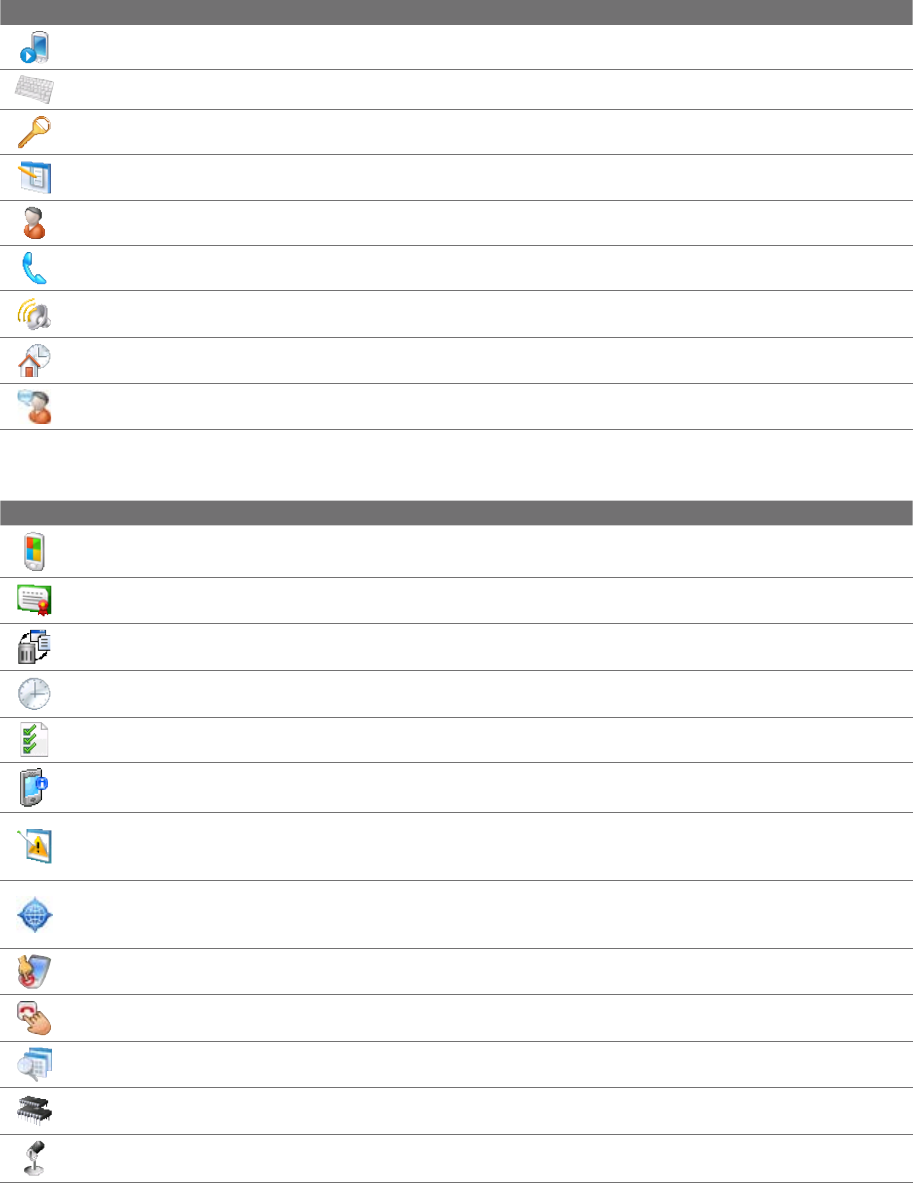
Managing Your Device 137
13.2 Settings on your Device
You can adjust the device settings to suit the way you work. To see all available settings, slide to the Settings
tab on the Home screen and tap All Settings.
Personal tab
Icon Description
Buttons Assign a program or function to a hardware button.
Input Set options for each of the input methods.
Lock Set a password for your device.
Menus Set which programs will appear in the Start menu.
Owner Information Enter your personal information on your device.
Phone Customize phone settings such as ring tone, and more.
Sounds & Notifications Enable sounds for events, notifications, and more, and set the type of notification for
different events.
Today Customize the appearance and the information to be displayed on the Home screen.
Voice Command Choose which functions you want to access by speaking out voice commands.
System tab
Icon Description
About This is where you can see basic information such as the Windows Mobile® version and type of
processor used on your device. You can also specify a name for your device.
Certificates See information about certificates that are installed on your device.
Clear Storage Reset your device to factory default settings and/or format the internal storage.
Clock & Alarms Set the device clock to the date and time of your locale or to a visiting time zone when you’re
traveling. Alarms can also be set at specified days and times of a week.
Customer Feedback Send feedback to the Customer Experience Improvement Program of Microsoft.
Device Information See information about the firmware version, hardware, identity, and the duration of calls
made on your device.
Error Reporting Enable or disable the device's error reporting function. When this function is enabled and
a program error occurs, technical data about the state of the program and your computer will be logged in a
text file and delivered to Microsoft's technical support if you choose to send it.
External GPS Set the appropriate GPS communication ports, if required. You may need to do this when there
are programs on your device that access GPS data or you have connected a GPS receiver to your device. See
Help for details.
Key Lock Lock the buttons on your device except for the POWER button when the device is in Sleep mode.
This ensures you will not switch the device on by accident and consume unnecessary power.
Long Press End Key Choose the desired function to be executed (for instance, lock the device) when
pressing and holding the END key.
Managed Programs Displays the programs that were installed on your device using System Center Mobile
Device Manager.
Memory Check the device memory allocation status and internal storage information. You can also stop
currently running programs.
Microphone AGC Adjust the volume of your voice automatically when you are recording.
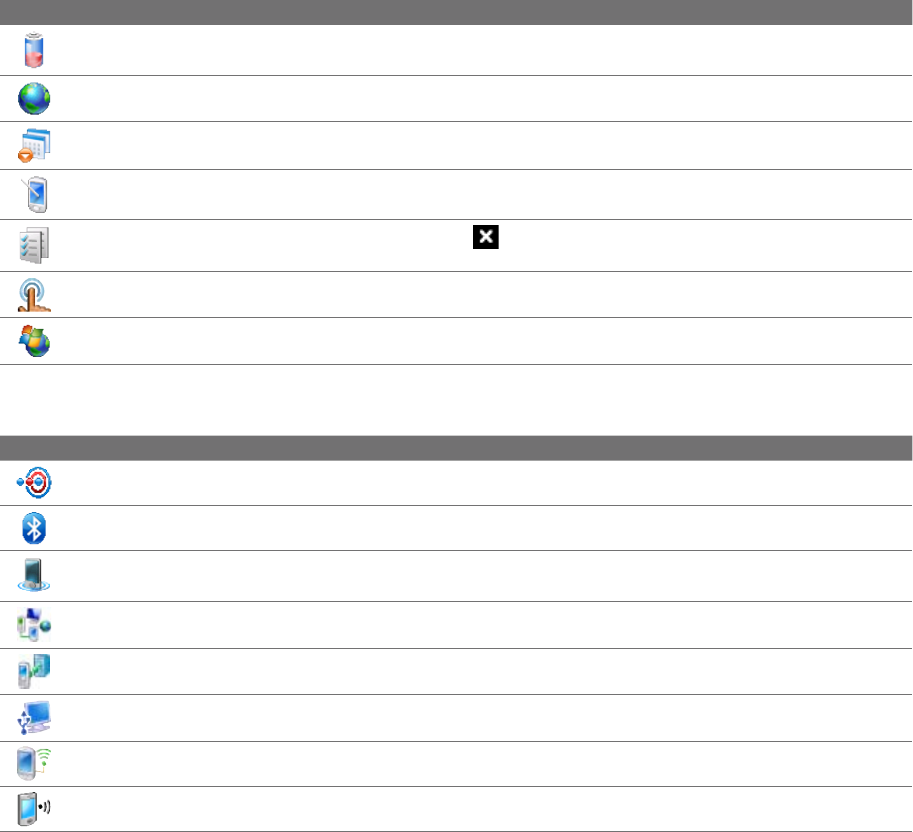
138 Managing Your Device
Icon Description
Power Check the remaining battery power. You can also set the brightness of the backlight and timeout for
turning off the display (switching device to Sleep mode) to conserve battery power.
Regional Settings Set the regional configuration to use, including the format for displaying numbers,
currency, date, and time on your device.
Remove Programs Remove programs that you installed on your device.
Screen Re-calibrate the screen, apply ClearType, and change the screen text size.
Task Manager Stop running programs and set the ( ) button to end programs immediately when you tap
the button. For more information, see "Using Task Manager" in this chapter.
TouchFLO You can enable or mute the finger scrolling and panning sound. You can also enable or disable the
large Start menu, and choose to show or hide the System Status screen when title bar icons are tapped.
Windows Update Link to Microsoft's Web site and update Windows Mobile® on your device with the latest
security patches or fixes, if they are available.
Connections tab
Icon Description
Beam Set your device to receive incoming Bluetooth beams.
Bluetooth Turn Bluetooth on, set your device to visible mode, and scan for other Bluetooth devices.
Comm Manager Manage your device’s connections (including data connection and Bluetooth), turn the
phone on or off, and enable or disable the Direct Push function.
Connections Set up one or more types of modem connections for your device, such as phone dial-up, and
more, so that your device can connect to the Internet or a private local network.
Domain Enroll Enroll your device in your company’s domain to let System Center Mobile Device Manager to
manage the device. Please ask your Server Administrator for more details.
USB to PC Set the type of USB connection to your PC. Select the ActiveSync option for synchronising data, or
use Disk Drive mode for transferring files.
Wi-Fi Scan for available wireless networks.
Wireless LAN See information about the active wireless network, and customize Wi-Fi settings.
13.3 Changing Basic Settings
Date and time
To set the date and time
1. On the Home screen Home tab, tap the time display and then tap the Time tab.
Tip Tap the More tab and select the Display the clock on the title bar in all programs option to show the
clock on all screens.
2. Select the correct time zone and change the date or time.
Note During synchronization, the time on your device is updated with the time on your computer.
To set the date and time for a different location
If you visit or communicate with someone in a particular time zone often, you can select it as your visiting
time zone.
1. On the Home screen Home tab, tap the time display and then tap the Time tab.
2. Tap Visiting.
3. Select the correct time zone and change the date or time.
Managing Your Device 139
Regional settings
The style in which numbers, currency, dates, and times are displayed is specified in regional settings.
1. On the Home screen, slide to the Settings tab and then tap All Settings.
2. On the System tab, tap Regional Settings > Region tab and then select your region from the list. The
region you select determines which options will be available on the other tabs.
Note This does not change the language of your device’s operating system.
3. To customize regional settings further, tap the appropriate tabs and set the desired options.
Display settings
To adjust the screen brightness
1. On the Home screen, slide to the Settings tab and then tap All Settings.
2. On the System tab, tap Power > Backlight tab.
3. Adjust the brightness by dragging the slider under On battery power and On external power.
To set the backlight to dim after a time delay
1. On the Home screen, slide to the Settings tab and then tap All Settings.
2. On the System tab, tap Power > Advanced tab.
3. In On battery power and On external power, select the Turn off backlight if device is not used for
check box, then specify the time delay.
To increase or decrease the size of text on the screen
1. On the Home screen, slide to the Settings tab and then tap All Settings.
2. On the System tab, tap Screen > Text Size tab.
3. Move the slider to increase or decrease the text size.
Device name
The device name is used to identify your device in the following situations:
Synchronizing with a computer
Connecting to a network
Restoring information from a backup
Note If you synchronize multiple devices with the same computer, each device must have a unique name.
To change the device name
1. On the Home screen, slide to the Settings tab and then tap All Settings.
2. On the System tab, tap About > Device ID tab.
3. Enter the device name.
Notes • The device name must begin with a letter, consist of letters from A to Z, numbers from 0 to 9, and cannot contain
spaces. Use the underscore character to separate words.
• If you enroll your device to your company’s domain, the device name will be changed to be the same as the one
used to enroll the device.
Ringer settings
To change the ring type and ring tone
1. On the Home screen, slide to the Settings tab and then tap Sound.
2. Scroll down and then tap Ring Type. Select the Ring Type you want to use and then tap Done.
3. Tap Ringtone and then select the ringtone you want to use.
4. Tap Done.
•
•
•

140 Managing Your Device
Tips • You can use *.wav, *.mid, *.mp3, *.wma, or other types of sound files that you downloaded from the Internet or
copied from your computer as ring tones. For a complete list of supported audio file formats for ring tones, see
"Specifications" in the Appendix.
• To use your sound files as ring tones, copy them first to the /My Documents/My Ringtones folder on your
device, then select the sound from the Ring tone list of your device. For more information about copying files,
see “Copying and Managing Files” in this chapter.
Alarms and notifications
To set an alarm
1. On the Home screen Home tab, tap the time display and then tap the Alarms tab.
2. Tap <Description> and enter a name for the alarm.
3. Tap the day of the week for the alarm. Select multiple days by tapping each desired day. Tap again to
deselect the day.
4. Tap the time to open a clock and set the time for the alarm.
Tip You can drag the hour and minute hands of the clock to set the time.
5. Tap the alarm icon ( ) to specify the type of alarm you want. You can choose a flashing light, a single
sound, a repeating sound, or vibration.
6. If you choose to play a sound, tap the list next to the Play sound check box and tap the sound you
want.
To choose how to be notified about events or actions
1. On the Home screen, slide to the Settings tab and then tap Sound > Advanced.
2. On the Sounds tab, choose how you want to be notified by selecting the appropriate check boxes.
3. On the Notifications tab, in Event, tap an event name and choose how you want to be notified by
selecting the appropriate check boxes. You can choose from several options, such as a special sound, a
message, or a flashing light.
Tip Turning off sounds and flashing light notifications helps conserve battery power.
Phone services
Your device can directly link to the mobile phone network, and enable you to access and change the settings
of various phone services for your device. Contact your wireless service provider to find out about the
availability of phone services for your device.
To access and change settings of phone services
1. On the Home screen, slide to the Settings tab and then tap All Settings.
2. On the Personal tab, tap Phone > Services tab.
3. Select the service you want to use, then tap Get Settings.
4. Choose your desired options, then tap OK.
The following are some of the optional phone services that you may find on your device. For more
information about customizing settings of phone services, see Help on your device.
Phone Services Usage
Location Setting Allow the mobile phone network to detect your current location via your device’s built-in GPS
chip. This is especially useful in times of emergency.
Network Service Choose whether to restrict your device to phone calls from your home network only.
TTY Mode Allow the use of a TTY (teletypewriter) device with the device for users who are visually or
hearing impaired.
Time Synchronization Choose whether or not to synchronize the time on your device with the mobile network.
Plus Code Dialing This allows easy dialing when making international calls. For more information, see "To
customize plus code dialing".
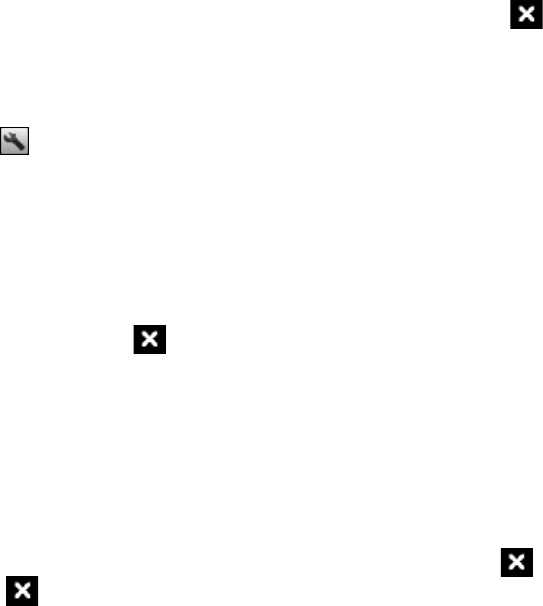
Managing Your Device 141
To customize plus code dialing
You can customize how phone numbers that begin with a plus “+” sign will be dialed.
1. Tap Start > Settings > Personal tab > Phone > Services tab.
2. Select Plus Code Dialing, then tap Get Settings. The following screen then appears:
3. To place local and international calls from the United States, select Enable.
When you place calls, the “+” sign at the beginning of phone numbers that you dial will be replaced as
follows:
When you enter a long distance phone number that starts with “+1”, the “+” will be removed and the
rest of the number will be dialed. For example, if you entered +1 416 123 4567, the number to be
dialed will be 14161234567.
When you enter an international phone number that starts with a “+” followed by a digit other
than 1, the “+” will be replaced with the United States international dialing code, which is already
set by default. For example, if you entered +58 212 123 4567, the number to be dialed will be
011582121234567.
4. To place calls to the United States from another country, select Disable and change the International
dialing code to the one used by the country where you are in.
So when you dial a phone number that starts with “+” followed by any digit (0 - 9), the “+” will be
replaced with the international dialing code of the country where you are in.
Tip If you modified the international dialing code, you can tap Reset to change it back to the default.
13.4 Using Task Manager
Task Manager lets you view and stop running programs, configure the button, and enable the Quick
Menu on the Home screen.
To open Task Manager
Tap the Quick Menu button on the top right corner of the Home screen to open the Quick Menu, then
tap .
On the Home screen, slide to the Settings tab and then tap All Settings. On the System tab, tap Task
Manager.
To switch back to a running program
Tap the program name in the Quick Menu.
On the Task Manager screen, tap and hold the program name on the Running tab, then tap Activate.
To configure the Exit ( ) button
You can configure the Exit button to shut down running programs when the button is tapped, or to just
temporarily close the program screen but keep the program running.
1. On the Task Manager screen, tap the Button tab.
2. Select the Enable the “X” button to end running programs check box.
Note When the Enable the “X” button to end running programs check box is not selected, tapping the
Exit button will only close a program screen. The program is not ended and continues to run in the
background.
3. Choose the action for shutting down programs (by tapping the button, or by tapping and holding
the button).
4. Tap OK.
•
•
•
•
•
•
142 Managing Your Device
To close running programs from the Task Manager
1. On the Task Manager screen, tap the Running tab.
2. Do one of the following:
Select the check box of the programs that you want to close, then tap Stop Selected.
Tap Stop All to close all programs in the list.
Tap Menu > Stop All but Selected to close all programs except those which check boxes are
selected.
Tip You can also close running programs from the Quick Menu on the Home screen. See “Quick Menu” in Chapter 1 for
details.
To add a running program to the exclusive list
If you add a running program to the Exclusive Programs List, it will not be closed when you tap Stop
Selected or Stop All and will not be listed in the Quick Menu on the Home Screen.
1. On the Task Manager screen, tap the Running tab.
2. Tap and hold the program name, then tap Add Exclusive.
Tip To remove a program from the exclusive list, tap the Exclusive tab, select the check box of the program, then tap
Remove.
To set the sorting preference and program icon size in the Quick Menu
1. On the Task Manager screen, tap the Others tab.
2. In Sort programs in Quick Menu by, choose whether to sort according to Program name or Memory
usage. The list will be sorted in ascending order.
3. In Program icon size in Quick Menu, choose whether to use Small size or Large size.
13.5 Protecting Your Device
Protect your device with a password
You can help keep your data more secure by requiring a password every time the device is turned on.
To set a device password
1. On the Home screen, slide to the Settings tab and then tap All Settings.
2. On the Personal tab, tap Lock.
3. Select the Prompt if device unused for check box, then specify the idle time before the device
requires a password.
4. In the Password type box, select the type of password you would like to use.
Tip If your device is configured to connect to a network, use an alphanumeric password for increased
security.
5. Enter the password in both the Password and Confirm boxes.
6. Tap OK. The next time the device is turned on, you will be prompted to enter your password.
Notes • To ensure that you can always make emergency calls, do not begin your password with the digits of your local
emergency number.
• If you entered a hint, the hint will be displayed after the wrong password is entered five times.
• Each time a wrong password is entered, the device response time gets longer until the device appears to be not
responding.
• If you forget your password, you can hard reset or clear the device memory. Before you do this, make sure you
back up your data and files so that you can restore them back to your device. For more information about hard
resetting the device and clearing the memory, see “Resetting Your Device” in this chapter.
•
•
•
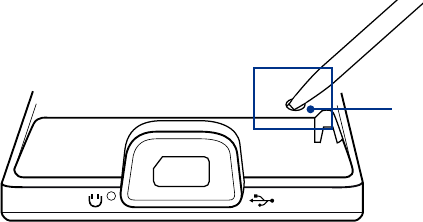
Managing Your Device 143
13.6 Managing Memory
To see how much memory is available for use
1. On the Home screen, slide to the Settings tab and then tap All Settings.
2. On the System tab, tap Memory > Main tab. The amount of memory allocated to data storage versus
program storage is displayed, as well as the amount of memory in use versus the available memory.
To see the available space of the internal storage
1. On the Home screen, slide to the Settings tab and then tap All Settings.
2. On the System tab, tap Memory > Storage Card tab.
If your device is running low on memory, try the following to free memory on your device:
Close programs which are not in use.
Move files and e-mail attachments to the internal storage.
Delete unnecessary files. Tap Start > Programs > File Explorer. Tap and hold the file, and tap
Delete.
Delete large files. To find large files on your device, tap Start > Programs > Search. In the Type list,
tap Larger than 64 KB, and tap Search.
In Opera Mobile or Internet Explorer Mobile, delete temporary Internet files and clear history
information.
Remove programs you no longer use.
Reset your device.
13.7 Resetting Your Device
Soft reset
Occasionally, you may need to reset your device. A soft (or normal) reset of your device clears all active
program memory and shuts down all active programs. This can be useful when your device is running slower
than normal, or a program is not performing properly. A soft reset is also necessary after the installation of
some programs. If a soft reset is performed when programs are running, unsaved work will be lost.
To perform a soft reset
1. Pull out the stylus.
2. Remove the back cover.
3. Use the stylus to press the RESET button located at the bottom of the back side of the device. Your
device restarts and displays the Home screen.
RESET button
•
•
•
•
•
•
•

144 Managing Your Device
Hard reset
You can also perform a hard reset (also known as a full reset). A hard reset should only be performed if
a normal reset does not solve a system problem. After a hard reset, the device is restored to its default
settings—the way it was when you first purchased it and turned it on. Any programs you installed, data you
entered, and settings you customized on your device will be lost. Only Windows Mobile® software and other
pre-installed programs will remain.
Warning! Your device will be set back to factory default settings. Make sure that any additional installed
programs and/or user data have been backed up before you perform a hard reset.
To perform a hard reset
1. Pull out the stylus.
2. Remove the back cover.
3. With the device turned on, press and hold the VOLUME DOWN and ENTER buttons, then press the
RESET button with the stylus tip.
4. Release the RESET button, but continue pressing the VOLUME DOWN and ENTER buttons until you see
this message on the screen:
This operation will delete
all your personal data,
and reset all settings
to manufacturer default.
Press VolUp to restore
manufacturer default, or
press other keys to cancel.
5. Release the VOLUME DOWN and ENTER buttons, then press the VOLUME UP button to perform the
hard reset, or press any other button to cancel the reset.
Clear Storage
You can also use Clear Storage to reset your device back to factory default settings and/or format the internal
storage.
1. On the Home screen, slide to the Settings tab and then tap All Settings.
2. On the System tab, tap Clear Storage.
3. In the drop-down menu, select whether to Clear Storage only, Format internal storage only, or
Clear storage and format internal storage.
4. Enter “1234” and then tap Yes.
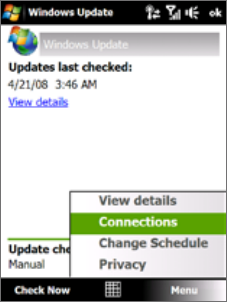
Managing Your Device 145
13.8 Windows Update
You can update Windows Mobile® on your device with the latest updates, security patches or fixes, if these are
available.
To set up Windows Update
The first time you run Windows Update, you need to set up how you want Windows Update to check for
patches on the Microsoft Web site.
1. On the Home screen, slide to the Settings tab and then tap All Settings.
2. On the System tab, tap Windows Update.
3. On the Update Setup screen, tap Next.
4. Choose how you want to check for updates, Manual or Automatic, then tap Next.
Note If you select Automatic, you will be asked if you want to use your current data plan to check for
updates. Select or clear the Use my data plan to check for and download updates check box and tap
Next.
5. Tap Finish.
To check for updates
1. On the Home screen, slide to the Settings tab and then tap All Settings.
2. On the System tab, tap Windows Update.
3. Tap Check Now.
Note Windows Mobile® updates may not be available at all times. Check the Windows Mobile® Web site for update
information.
To change Windows Update options
1. On the Home screen, slide to the Settings tab and then tap All Settings.
2. On the System tab, tap Windows Update.
3. Tap Menu and select the option you want to change.
Tap Connections to change how the device connects to
the Internet when checking for updates.
Tap Change Schedule to change how Windows Update
checks for Windows Mobile® updates.
•
•
146 Managing Your Device
13.9 Battery Saving Tips
How long your battery power lasts depends on the battery type and how you use your device. Try the
following to help conserve battery life:
When the device is not in use, press POWER to switch off the display.
On the Home screen, slide to the Settings tab and then tap All Settings. On the System tab, tap
Power > Advanced tab of the Power settings screen. Here, you can specify the time before your device
automatically turns off the display and backlight to conserve battery power. For optimum conservation,
specify 3 minutes or less.
On the Home screen, slide to the Settings tab and then tap All Settings. On the System tab, tap Power
> Backlight tab to adjust the backlight brightness settings.
Use the AC adapter to plug your device into an external power outlet whenever possible, especially
when using a modem or other peripherals.
Turn Bluetooth off when you are not using it. Make your device visible to other devices only when you
are trying to establish a Bluetooth partnership. For more information about Bluetooth, see Chapter 9.
Lower the volume.
Close battery-intensive programs, such as the Camera, when you are done using them. Make sure
the programs are ended and are not continuously running in the background. Refer to “Using Task
Manager” in this chapter for information on closing programs.
•
•
•
•
•
•
•
Appendix
A.1 Specifications
A.2 Regulatory Notices
A.3 Additional Safety Information

148 Appendix
A.1 Specifications
System Information
Processor Qualcomm® MSM7500A™ 528 MHz
Memory – ROM : 512 MB
– RAM : 192 MB DDR (includes 64MB baseband memory)
Note: Figures are the total ROM and RAM memory available for use and storage. Since the
memory is shared by the operating system, applications, and data, the actual available
memory is less than what is specified.
Operating System Windows Mobile® 6.1 Professional
Power
Battery Rechargeable Lithium-ion battery, 1340 mAh
Battery Life
(estimates)
Standby time: Up to 303 hours
Talk time: Up to 270 minutes
(The above are subject to network and phone usage.)
AC Adapter Voltage range/frequency: 100 - 240V AC, 50/60 Hz
DC output: 5V and 1A
Communications
Network CDMA2000 1xEVDO/1xRTT and IS-95A/B voice or data
Dual-band (800 and 1900 MHz)
Internal Antenna Yes
Physical
Dimensions 106 mm (L) X 52 mm (W) X 17.85 mm (T)
Weight 150 g (with battery)
Display
LCD Type 2.8-inch TFT-LCD flat touch-sensitive screen
Resolution 480 x 640 VGA resolution
Camera Module
Type 3.2 megapixel color camera with auto focus
Resolution Photo: 3M (2048 x 1536); 2M (1600 x 1200); 1M (1280 x 960); VGA (640 x 480);
QVGA (320 x 240)
Video: CIF (352 x 288); QVGA (320 x 240); QCIF (176 x 144); Sub-QCIF (128 x 96)
•
•
Digital Zoom Up to 4X
Connections
I/O Port HTC ExtUSB™ (11-pin mini-USB and audio jack in one; USB 2.0 high speed)
Wireless Connections Bluetooth® 2.0 with EDR
Wi-Fi® (IEEE 802.11 b/g)
•
•
Audio
Microphone/Speaker Built-in
Ring tone Supports MP3, AAC, AAC+, eAAC+, WMA, WAV, AMR-NB, AMR-WB, QCP, MIDI,
MPEG-4 formats
40 polyphonic and standard MIDI format 0 and 1 (SMF) / SP MIDI
•
•
Supported Playback
Formats
Windows Media® Player: MP3, MPEG-4, AAC, AAC+, eAAC+, WMA, WAV, AMR,
AMR-NB, AMR-WB, AWB, SP-MIDI
TouchFLO™ 3D: MP3, MPEG-4, WMA, AAC, AAC+
•
•

Appendix 149
Controls
Device Control TouchFLO™ 3D
Touch-sensitive navigation control with ENTER button
HOME button
BACK button
Phone buttons: TALK/SEND and END
POWER button
VOLUME CONTROL buttons
RESET button
•
•
•
•
•
•
•
•
Others
Special Features GPS and A-GPS ready (GPS navigation software not included)
A.2 Regulatory Notices
Regulatory Agency Identifications
For regulatory identification purposes, your product is assigned a model number of RAPH500.
FCC ID: NM8RAPH500.
To ensure continued reliable and safe operation of your device, use only the accessories listed below with
your RAPH500.
The Battery Pack has been assigned a model number of DIAM171.
Note This product is intended for use with a certified Class 2 Limited Power Source, rated 5 Volts DC, maximum 1 Amp
power supply unit.
Federal Communication Commission Interference Statement
This equipment has been tested and found to comply with the limits for a Class B digital device, pursuant
to Part 15 of the FCC Rules. These limits are designed to provide reasonable protection against harmful
interference in a residential installation. This equipment generates, uses and can radiate radio frequency
energy and, if not installed and used in accordance with the instructions, may cause harmful interference
to radio communications. However, there is no guarantee that interference will not occur in a particular
installation. If this equipment does cause harmful interference to radio or television reception, which can be
determined by turning the equipment off and on, the user is encouraged to try to correct the interference by
one of the following measures:
Reorient or relocate the receiving antenna.
Increase the separation between the equipment and receiver.
Connect the equipment into an outlet on a circuit different from that to which the receiver is connected.
Consult the dealer or an experienced radio or television technician for help.
FCC Caution: Any changes or modifications not expressly approved by the party responsible for compliance
could void the user's authority to operate this equipment.
This device complies with Part 15 of the FCC Rules. Operation is subject to the following two conditions: (1)
This device may not cause harmful interference, and (2) this device must accept any interference received,
including interference that may cause undesired operation.
IMPORTANT NOTE
Radiation Exposure Statement:
This equipment complies with FCC radiation exposure limits set forth for an uncontrolled environment. End
users must follow the specific operating instructions for satisfying RF exposure compliance. To maintain
compliance with FCC RF exposure compliance requirements, please follow operation instruction as
documented in this manual.
This transmitter must not be co-located or operating in conjunction with any other antenna or transmitter,
except the transmitters built-in with this device.
•
•
•
•
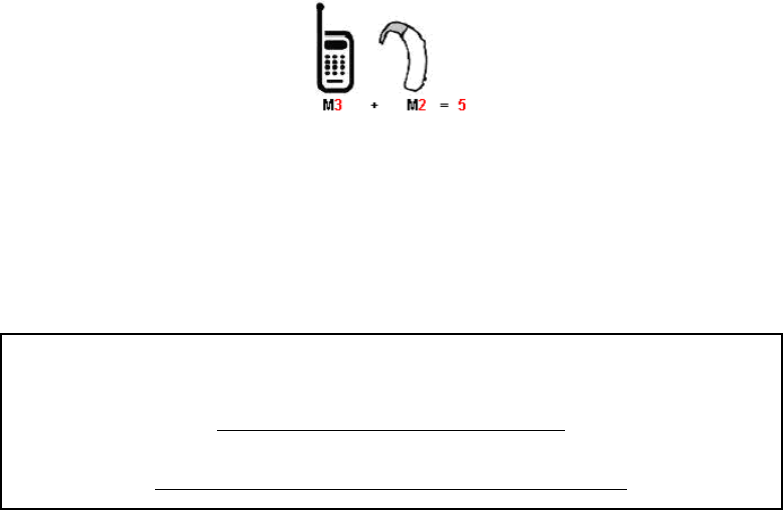
150 Appendix
FCC Hearing-Aid Compatibility (HAC) Regulations for Wireless Devices
On July 10, 2003, the U.S. Federal Communications Commission (FCC) Report and Order in WT Docket 01-
309 modified the exception of wireless phones under the Hearing Aid Compatibility Act of 1988 (HAC Act)
to require digital wireless phones be compatible with hearing-aids. The intent of the HAC Act is to ensure
reasonable access to telecommunications services for persons with hearing disabilities.
While some wireless phones are used near some hearing devices (hearing aids and cochlear implants), users
may detect a buzzing, humming, or whining noise. Some hearing devices are more immune than others to
this interference noise, and phones also vary in the amount of interference they generate.
The wireless telephone industry has developed a rating system for wireless phones, to assist hearing device
users find phones that may be compatible with their hearing devices. Not all phones have been rated. Phones
that are rated have the rating on their box or a label located on the box.
The ratings are not guarantees. Results will vary depending on the user’s hearing device and hearing loss.
If your hearing device happens to be vulnerable to interference, you may not be able to use a rated phone
successfully. Trying out the phone with your hearing device is the best way to evaluate it for your personal
needs.
M-Ratings: Phones rated M3 or M4 meet FCC requirements and are likely to generate less interference to
hearing devices than phones that are not labeled. M4 is the better/higher of the two ratings. RAPH500 is rated
M3.
Please power off the Bluetooth function while using hearing aid devices with your RAPH500.
Hearing devices may also be rated. Your hearing device manufacturer or hearing health professional may
help you find this rating. Higher ratings mean that the hearing device is relatively immune to interference
noise. The hearing aid and wireless phone rating values are then added together. A sum of 5 is considered
acceptable for normal use. A sum of 6 is considered for better use. A sum of 8 is considered for best use.
In the above example, if a hearing aid meets the M2 level rating and the wireless phone meets the M3 level
rating, the sum of the two values equal M5. This should provide the hearing aid user with “normal usage”
while using their hearing aid with the particular wireless phone. “Normal usage” in this context is defined as a
signal quality that is acceptable for normal operation.
The M mark is intended to be synonymous with the U mark. The T mark is intended to be synonymous
with the UT mark. The M and T marks are recommended by the Alliance for Telecommunications Industries
Solutions (ATIS). The U and UT marks are referenced in Section 20.19 of the FCC Rules. The HAC rating and
measurement procedure are described in the American National Standards Institute (ANSI) C63.19 standard.
For information about hearing aids and digital wireless phones
FCC Hearing Aid Compatibility and Volume Control:
http://www.fcc.gov/cgb/dro/hearing.html
Gallaudet University, RERC:
http://tap.gallaudet.edu/DigWireless.KS/DigWireless.htm
SAR Information
1.43 W/KG @1g (HEAD)
1.18 W/KG @1g (BODY)
THIS MODEL DEVICE MEETS THE GOVERNMENT’S REQUIREMENTS FOR EXPOSURE TO RADIO WAVES.
For body worn operation, this phone has been tested and meets the FCC RF exposure guidelines when used
with the HTC Corporation accessories supplied or designated for this product. Use of other acccessoies may
not ensure compliance with the FCC RF exposure guidelines.

Appendix 151
Your wireless mobile CDMA phone is a radio transmitter and receiver. It is designed and manufactured not to
exceed the emission limits for exposure to radio frequency (RF) energy set by the Federal Communications
Commission of the U.S. Government. These limits are part of comprehensive guidelines and establish
permitted levels of RF energy for the general population. The guidelines are based on the safety standards
previously set by both U.S. and international standards bodies:
American National Standards Institute (ANSI) IEEE. C95.1-1992.
National Council on Radiation Protection and Measurement (NCRP). Report 86. 1986.
International Commission on Non-Ionizing Radiation Protection (ICNIRP) 1996.
Ministry of Health (Canada), Safety Code 6. The standards include a substantial safety margin designed
to assure the safety of all persons, regardless of age and health.
The exposure standard for wireless mobile CDMA phone employs a unit of measurement known as the
Specific Absorption Rate, or SAR. The SAR limit set by the FCC is 1.6 W/kg*.
This phone has been tested and meets the FCC RF exposure guidelines when used with an accessory that
contains no metal and that positions the handset a minimum of 1.5 cm from the body. The FCC has granted
an Equipment Authorization for this model device with all reported SAR levels evaluated as in compliance
with the FCC RF exposure guidelines. SAR information on this model device is on file with the FCC and can be
found under the Display Grant section of https://fjallfoss.fcc.gov/oetcf/eas/reports/GenericSearch.cfm after
searching on FCC ID: NM8RAPH500. Additional information on Specific Absorption Rates (SAR) can be found
on the Cellular Telecommunications & Internet Association (CTIA) Web-site as http://www.phonefacts.net.
Normal condition only to ensure the radiative performance and safety of the interference. As with other
mobile radio transmitting equipment, users are advised that for satisfactory operation of the equipment and
for the safety of personnel, it is recommended that no part of the human body be allowed to come too close
to the antenna during operation of the equipment. Use of non-HTC Corporation approved accessories may
violate FCC RF exposure guidelines and should be avoided.
Telecommunications & Internet Association (TIA) Safety Information
Pacemakers
The Health Industry Manufacturers Association recommends that a minimum separation of six inches be
maintained between a handheld wireless phone and a pacemaker to avoid potential interference with the
pacemaker. These recommendations are consistent with the independent research by and recommendations
of Wireless Technology Research. Persons with pacemakers:
Should ALWAYS keep the phone more than six inches from their pacemaker when the phone is turned
ON.
Should not carry the phone in a breast pocket.
Should use the ear opposite the pacemaker to minimize the potential for interference. If you have any
reason to suspect that interference is taking place, turn the phone OFF immediately.
Hearing Aids
Some digital wireless phones may interfere with some hearing aids. In the event of such interference, you may
want to consult your service provider, or call the customer service line to discuss alternatives.
Other Medical Devices
If you use any other personal medical device, consult the manufacturer of your device to determine if they
are adequately shielded from external RF energy. Your physician may be able to assist you in obtaining this
information.
Turn the phone OFF in health care facilities when any regulations posted in these areas instruct you to do so.
Hospitals or health care facilities may be using equipment that could be sensitive to external RF energy.
•
•
•
•
•
•
•

152 Appendix
WEEE Notice
The Directive on Waste Electrical and Electronic Equipment (WEEE), which entered into force as European law
on 13th February 2003, resulted in a major change in the treatment of electrical equipment at end-of-life.
The purpose of this Directive is, as a first priority, the prevention of WEEE, and in addition, to promote the
reuse, recycling and other forms of recovery of such wastes so as to reduce disposal.
The WEEE logo (shown at the left) on the product or on its box indicates that this product must not
be disposed of or dumped with your other household waste. You are liable to dispose of all your
electronic or electrical waste equipment by relocating over to the specified collection point for
recycling of such hazardous waste. Isolated collection and proper recovery of your electronic and
electrical waste equipment at the time of disposal will allow us to help conserving natural resources.
Moreover, proper recycling of the electronic and electrical waste equipment will ensure safety
of human health and environment. For more information about electronic and electrical waste
equipment disposal, recovery, and collection points, please contact your local city center, household
waste disposal service, shop from where you purchased the equipment, or manufacturer of the
equipment.
RoHS Compliance
This product is in compliance with Directive 2002/95/EC of the European Parliament and of the Council of
27 January 2003, on the restriction of the use of certain hazardous substances in electrical and electronic
equipment (RoHS) and its amendments.
A.3 Additional Safety Information
This section provides more safety information in addition to the information at the beginning of the
user manual.
When Driving
Do Not Use The PC Functions Of Your Pocket PC While Driving Or Walking
Never use the personal computer functions of your device while driving an automobile or any other moving
vehicle. Always pull out of traffic and come to a stop in a legally permissible and safe location before using
your device. Failure to do so could result in serious bodily injury in a traffic accident.
When driving:
Always secure your device in its leather pouch.
Never place your device on the passenger seat or anyplace else in the car where it can become a
projectile during a collision or stop.
An air bag inflates with great force. DO NOT place objects, including either installed or portable
wireless equipment, in the area over the air bag or in the air bag deployment area. If in-vehicle wireless
equipment is improperly installed and the air bag inflates, serious injury could result.
Never store or transport flammable liquids, gases or explosive materials in the same compartment of your
automobile as the device or any of its accessories, as possible sparking in the device could cause ignition or
explosion.
Never use your device while walking. Usage while walking could result in bodily injury caused by inattention
to automobile traffic or other pedestrian hazards.
Using The Phone Function Of Your Pocket PC While Driving Is Extremely Dangerous
Talking on or using your device while driving is extremely dangerous and is illegal in some states. Remember,
safety comes first. Check the laws and regulations on the use of phones in the areas where you drive. Always
obey them.
If you must use the phone function while driving, please:
Give full attention to driving. Driving safely is your first responsibility.
Use hands-free operation and/or one-touch, speed dialing, and auto answer modes.
Pull off the road and park before making or answering a call.
WARNING! Failure to follow these instructions could lead to serious personal injury and possible property damage.
•
•
•
•
•
•
Appendix 153
When Using Your Device Near Other Electronic Devices
Your wireless handheld portable device is a low power radio transmitter and receiver. When it is ON, it receives
and also sends out radio frequency (RF) signals.
Most modern electronic equipment is shielded from RF energy. However, certain electronic equipment
may not be shielded against the RF signals from your wireless device; therefore, use of your device must be
restricted in certain situations.
In addition, the computer portion of your device produces low levels of RF energy due to the generation of
digital timing pulses by its clock oscillator circuits. Your device has been equipped with internal shielding
to minimize stray emissions of RF energy. However, use of the computer functions of your device must be
restricted in certain situations.
PACEMAKERS
The Health Industry Manufacturers Association recommends that a minimum separation of six (6”) inches be
maintained between a handheld wireless phone and a pacemaker to avoid potential interference with the
pacemaker. These recommendations are consistent with the independent research by and recommendations
of Wireless Technology Research.
Never come closer than six (6) inches to a person with a heart pacemaker implant when using your device.
Doing so could result in interference with the function of the pacemaker.
Persons with pacemakers:
Should ALWAYS keep the phone more than six inches from their pacemaker when the phone is
turned ON.
Should not carry the phone in a breast pocket.
Should use the ear opposite the pacemaker to minimize the potential for interference.
Note This is not necessary if the device is not held to the ear.
If you have any reason to suspect that interference is taking place, turn the phone OFF immediately.
HEARING AIDS
Some digital wireless phones may interfere with some hearing aids. In the event of such interference, you may
want to consult your service provider, or call the customer service line to discuss alternatives.
For more regulatory information about hearing devices, see “FCC Hearing-Aid Compatibility (HAC)
Regulations for Wireless Devices”.
OTHER MEDICAL DEVICES
If you use any other personal medical device, consult the manufacturer of your device to determine if it
is adequately shielded from external RF energy. Your physician may be able to assist you in obtaining this
information.
HOSPITALS AND HEALTH CARE FACILITIES
Turn your device OFF in health care facilities when any regulations posted in these areas instruct you to do so.
Hospitals or health care facilities may be using equipment that could be sensitive to external RF energy.
ELECTRONIC DEVICES IN VEHICLES
RF signals may affect improperly installed or inadequately shielded electronic systems in motor vehicles.
Check with the manufacturer or its representative regarding your vehicle. You should also consult the
manufacturer of any equipment that has been added to your vehicle.
POSTED FACILITIES
Turn your device OFF where posted notices so require.
•
•
•
•
154 Appendix
Turn Off Your Device Before Flying
AIRCRAFT
FCC regulations prohibit using the transmitting and phone functions of your device while in the air. In
addition, most airline regulations prohibit the on-board use of portable PCs (and all other portable electronic
devices that could potentially emit stray RF energy), particularly during take-offs and landings, to prevent any
possible interference with the reception of signals by airborne electronic navigational devices.
Turn your device OFF before boarding an aircraft. Always request and obtain prior consent and approval of an
authorized airline representative before using your device aboard an aircraft. Always follow the instructions of
the airline representative whenever using your device aboard an aircraft, to prevent any possible interference
with airborne electronic equipment.
Turn Off Your Device in Dangerous Areas
BLASTING AREAS
To avoid interfering with blasting operations, turn your device OFF when in a “blasting area” or in areas posted
“Turn off two-way radio”. Obey all signs and instructions.
POTENTIALLY EXPLOSIVE ATMOSPHERES
Turn your device OFF when in any area with a potentially explosive atmosphere and obey all signs and
instructions. Sparks in such areas could cause an explosion or fire resulting in bodily injury or even death.
Areas with a potentially explosive atmosphere are often, but not always, clearly marked. They include fueling
areas such as gas stations; below deck on boats; fuel or chemical transfer or storage facilities; vehicles using
liquefied petroleum gas (such as propane or butane); areas where the air contains chemicals or articles, such
as grain, dust, or metal powders; and any other area where you would normally be advised to turn off your
vehicle’s engine.
General Safety
Your pocket PC is a high quality piece of equipment. Before operating, read all instructions and cautionary
markings on the product, battery and adapter/charger.
Failure to follow the directions below could result in serious bodily injury and/or property damage due to
battery liquid leakage, fire or rupture.
DO NOT use or store this equipment in a place where it will be exposed to high temperatures, such as near an
open flame or heat-emitting equipment.
DO NOT drop your device or subject it to severe shock. When not using, lay down the unit to avoid possible
damage due to instability.
DO NOT expose this equipment to rain or spilled beverages.
DO NOT use unauthorized accessories.
DO NOT disassemble the device or its accessories. If service or repair is required, return unit to an authorized
cellular service center. If the unit is disassembled, the risk of electric shock or fire may result.
Never allow metallic objects, such as staples and paper clips, to get into the inside of your device.
Never touch the liquid that might leak from a broken liquid crystal display. Contact with this liquid could
cause a skin rash. If the crystal display liquid should come into contact with the skin or clothing, wash it
immediately with clean water.
In the event that the device emits an unusual odor or sound or generates smoke, immediately disconnect the
AC adapter from the power outlet, then detach the battery.
Appendix 155
Antenna Safety
Use only the supplied or an approved replacement antenna. Unauthorized antennas, modifications, or
attachments could impair call quality, damage your device, or result in violation of FCC regulations. Please
contact your local dealer for replacement antenna.
Do not use the device with a damaged antenna. If a damaged antenna comes into contact with the skin, a
minor burn may result. Please contact your local dealer for replacement antenna.
Battery Safety
Your device uses a removable and rechargeable lithium ion battery. Please contact customer service for
assistance should you need a replacement battery.
DOs
Only use the battery and charger approved by the manufacturer.
Only use the battery for its original purpose.
Try to keep batteries in a temperature between 41°F (5°C) and 95°F (35°C).
If the battery is stored in temperatures above or below the recommended range, give it time to warm
up or cool down before using.
Completely drain the battery before recharging. It may take one to four days to completely drain.
Store the discharged battery in a cool, dark, and dry place.
Purchase a new battery when its operating time gradually decreases after fully charging.
Properly dispose of the battery according to local regulations.
DON’Ts
Don’t attempt to disassemble the battery – it is a sealed unit with no serviceable parts.
Don’t expose the battery terminals to any other metal object (e.g., by carrying it in your pocket or purse
with other metallic objects such as coins, clips and pens). This can short circuit and critically damage
the battery.
Don’t leave the battery in hot or cold temps. Otherwise, it could significantly reduce the capacity and
lifetime of the battery.
Don’t dispose of the battery into a fire.
Lithium ion batteries are recyclable. When you replace the removable battery, please request the repair center
to recycle the battery in accordance with RBRC standards. When disposing of the battery by yourself, please
call RBRC at (800) 822-8837 for proper disposal tips.
Never touch any fluid that might leak from the built-in battery. Such liquid when in contact with the eyes or
skin, could cause injury to the skin or eyes. Should the liquid come into contact with the eyes, irrigate the
eyes thoroughly with clean water and immediately seek medical attention. In the event the liquid comes into
contact with the skin or clothing, wash it away immediately with clean water.
Adapter/Charger
Use the Correct External Power Source
A product should be operated only from the type of power source indicated on the electrical ratings label. If
you are not sure of the type of power source required, consult your authorized service provider or local power
company. For a product that operates from battery power or other sources, refer to the operating instructions
that are included with the product.
The AC Adapter/Charger designed for this unit requires the use of a standard 120 V AC power source for
device operation.
Never attempt to disassemble or repair an AC adapter/charger. Never use an AC adapter/charger if it has a
damaged or worn power cord or plug. Always contact an authorized service center, if repair or replacement is
required.
•
•
•
•
•
•
•
•
•
•
•
•
156 Appendix
Never alter the AC cord or plug on an AC adapter/charger. If the plug will not fit into the available outlet, have
a proper outlet installed by a qualified electrician.
Never allow any liquids or water to spill on an AC adapter/charger when it is connected to an AC power
source.
Always use the authorized AC adapter/charger to avoid any risk of bodily injury or damage to your cellular
phone or battery.
Never attempt to connect or disconnect the AC adapter/charger with wet hands. Always unplug the AC
adapter/charger from the power source before attempting any cleaning. Always use a soft cloth dampened
with water to clean the equipment, after it has been unplugged.
Handling the cord on this product or cords associated with accessories sold with this product, will expose you
to lead, a chemical known to the State of California to cause birth defects or other reproductive harm. Wash
hands after handling.
Always disconnect the travel charger or desktop charger from the power source when it is not in use.
Index
A
A2DP 97
ActiveSync
- about 122
- set up 55
- synchronize with computer 56
- synchronize with Exchange Server 70
Add and remove programs 123
Adobe Reader LE 122, 124
Airplane Mode 31, 128
Alarm 140
Album
- about 112, 122
- close Album 115
- play back video 115
- select a photo or video to view 112
- view an image 113
Attachment
- add to e-mail 65
- download 66
- set IMAP4 to automatically receive attachments 67
- set Outlook to automatically receive attachments 67
Audio Booster 118, 122
B
Back cover
- remove 18
Backlight
- adjust brightness 139
- set backlight timeout 139
Back up data 133
Basic settings 138
Battery
- charge battery 19
- install 18
- remove 18
- save battery power 77, 145
Beam via Bluetooth 97
Block Recognizer 50
Bluetooth
- about 96
- Bluetooth Explorer 98, 122
- Bluetooth file sharing 98
- Bluetooth shared folder 98
- hands-free headset 97
- modes 96
- partnership (pairing) 96
- stereo headset 97
- synchronize 57
- turn on and o 128
- visible 96
Bluetooth Explorer 122
C
Calculator 122
Calendar
- about 122
- create appointment 124
- send appointment 125
- view appointment 125
Call History 30
Calling
- from Contacts 28
- from Home screen 28
- from Phone screen 28
Camera
- about 106, 122
- Advanced Options
110
- capture modes 106
- controls 107
- file formats 107
- icons 107
- Menu Panel 108
- specifications 148
- zooming 109
Clear Storage 144
Clock & Alarms 137, 138, 140
Comm Manager 128, 138
Compact QWERTY 47
Company Directory 74
Connect device to Internet
- Dial-up 78
- start a connection 78
- ways of connecting 76
Contacts 122, 126
Contacts Picture capture mode 106
Copy
- copy and manage files 136
- media files from PC to device 116
D
Device name 139
Dial-up 78
Dimensions and weight 148
Direct Push 71, 128
Disconnect data connection 128
Download
- download complete e-mail 65
- e-mail download settings 63, 66
- file attachments 66
- satellite data 103
- synchronize e-mails 66
- Web feeds 91
Draw 129
158 Index
E
E-mail
- Internet e-mail account (POP3/IMAP4) 62
- mail server settings 63
- Mail tab (Home screen) 37
- send 64
- settings (POP3/IMAP4) 63
- setup wizard 62
- synchronize 54, 66, 70
- types of e-mail accounts 62
Emergency call 28
Emoticon
- Windows Live Messenger 85
Equalizer 118
Excel Mobile 122, 128
Exchange Server 70
F
Favorite contacts 36
File Explorer 122, 136
Find contact
- Company Directory 74
- on device 127
Finger gestures 43
Finger panning 43
Finger scrolling 43
Forward e-mail 66
Full QWERTY 46
G
Games 122
Getting Started 122
GPS 102, 103, 123
H
Hard reset 143
Help 122
Home screen 22, 34
Home tab (Home screen) 35
I
IMAP4 62
Input methods
- Block Recognizer 50
- Compact QWERTY 47
- Full QWERTY 46
- Letter Recognizer 50
- Phone Keypad 48
- Transcriber 50
Input Panel 46
Input Selector arrow 46
International call 29
Internet 76
Internet e-mail 62
Internet Explorer Mobile 122
Internet Sharing 122
Internet tab (Home screen) 41
L
Letter Recognizer 50
Library
- Music tab (Home screen) 40
- Windows Media Player Mobile 116
Live Messenger 85
M
Mail tab (Home screen) 37
Meeting request 73, 125
Memory 24, 142, 148
Messages tab (Home screen) 37
Messaging
- about 60, 122
- e-mail 62, 64
- text (SMS) 60
Messenger 85, 122
Microsoft Office Mobile 122, 128
MP3 Trimmer 119, 122
Multitap 48
N
News channels (Web feeds) 91
Notes 123, 129
Now Playing
- Music tab (Home screen) 40
- Windows Media Player Mobile 116
Numeric and Symbol Mode 49
O
Office Mobile 122, 128
OneNote Mobile 122, 128
Open PDF file 124
Opera Mobile 79, 123
P
Panorama capture mode 106
Password 142
People tab (Home screen) 36
Phone 28, 122
Phone Keypad 48
Phone services 140
Photo capture mode 106
Photos and Videos tab (Home screen) 38
Pictures & Videos 123
Picture Theme capture mode 106
Playlists
- Music tab (Home screen) 40
- Windows Media Player Mobile 118
Play media 117
Play music
- Music tab (Home screen) 39
- Windows Media Player Mobile 117
Podcasts 93
POP3 62
PowerPoint Mobile 122, 128
Programs 122
Index 159
Programs tab (Home screen) 42
Put call on hold 29
Q
QuickGPS 103, 123
Quick menu 24, 141
R
Record
- voice note 130
- voice recording 131
Regional Settings 138, 139
Regulatory notices 149
Reply
- e-mail 66
- text (SMS) 37, 61
Reset
- clear storage 144
- hard reset 143
- soft reset 143
Review screen (Camera) 110
Ring tone 42, 139
Ring type 139
RSS Hub
- about 91, 123
- headline list 92
- news channels 91
- podcasts 93
- summary view 92
S
Safety information 3
Screen text size 139
Search 123
Send
- e-mail 64
- text message (SMS) 60
Settings (Connections tab)
- Beam 138
- Bluetooth 138
- Connections 78, 138
- Domain Enroll 138
- USB to PC 56, 138
- Wi-Fi 77, 138
- Wireless LAN 77, 138
Settings (Personal tab)
- Buttons 137
- Input 137
- Lock 137, 142
- Menus 137
- Owner Information 137
- Phone 137, 139, 140
- Sounds & Notifications 137, 140
- Today 137
Settings (System tab)
- About 137, 139
- Certificates 137
- Clear Storage 137, 144
- Clock & Alarms 137, 138, 140
- Device Information 137
- Error Reporting 137
- External GPS 137
- Key Lock 137
- Long Press End Key 137
- Managed Programs 137
- Memory 137
- Microphone AGC 137
- Power 138
- Regional Settings 138, 139
- Remove Programs 123, 138
- Screen 138, 139
- Task Manager 138, 141
- TouchFLO 24, 43, 138
- Windows Update 138, 144
Settings tab (Home screen) 42
Sleep mode 20
Smart Dial 31
SMS 37, 60, 64
Soft reset 143
Sounds & Notifications 137, 140
Speakerphone 30
Specifications 148
Speed Dial 30
Sprite Backup 133
Start menu 24
Status icons 22
Swap/switch calls 29
Synchronize
- ActiveSync 56
- change information types 56
- music and videos 57
- via Bluetooth 57
- Windows Media Player 116
- Windows Mobile Device Center 54
- with computer 42, 56
- with Exchange Server 42, 70
T
T9 48
Task Manager 138, 141
Tasks 123, 130
Text messages
- create new message 60
- Messages tab (Home screen) 37
- send 61
Text size (screen) 139
Transcriber 50
Troubleshoot
- sync connection 56
- Windows Media Player Mobile 118
Turn device on and off 20
Turn phone function on and off 128
Turn the phone function on and off 31
160 Index
U
USB to PC 56, 138
V
Vibrate 23, 25, 30, 140
Video capture mode 106
Voice call
- about 28
- answer call 29
- end call 30
- make call 28
Voicemail 29
Voice Recorder 123, 131
W
Weather tab (Home screen) 41
Wi-Fi 76, 128
Windows Live 84, 123
Windows Live Messenger 85, 122
Windows Media Player Mobile
- about 123
- file formats 115
- menus 116
- playlists 118
- troubleshoot 118
Windows Mobile Device Center 54
Windows Update 138, 144
Word Mobile 122, 128
Y
YouTube 81, 123
Z
ZIP
- about 123, 132
- create archive 132
- open zip file and extract files 132
Zooming
- Camera 109
- finger gestures 43